Boutique Japan

20 Essential Japanese Phrases for Travelers to Japan
If you’re visiting Japan and a little worried about the language barrier (or you simply love languages), we’ve got you covered with these essential Japanese phrases for travelers.
In our guide to what we believe are the most important Japanese phrases for travel, we’ll introduce you to a selection of key words and phrases — and explain why the Japanese language barrier is not as worrisome as you might think.
The truth is, you do not need to speak any Japanese to have a successful, wonderful trip to Japan (and if you’re looking for travel inspiration, check out our favorite destinations in Japan ). However, learning a few key Japanese phrases can make your trip just that much better. So let’s get into it!
Download our Free Japanese Phrasebook:
Originally written in 2014, this post was updated and republished on November 1, 2019.
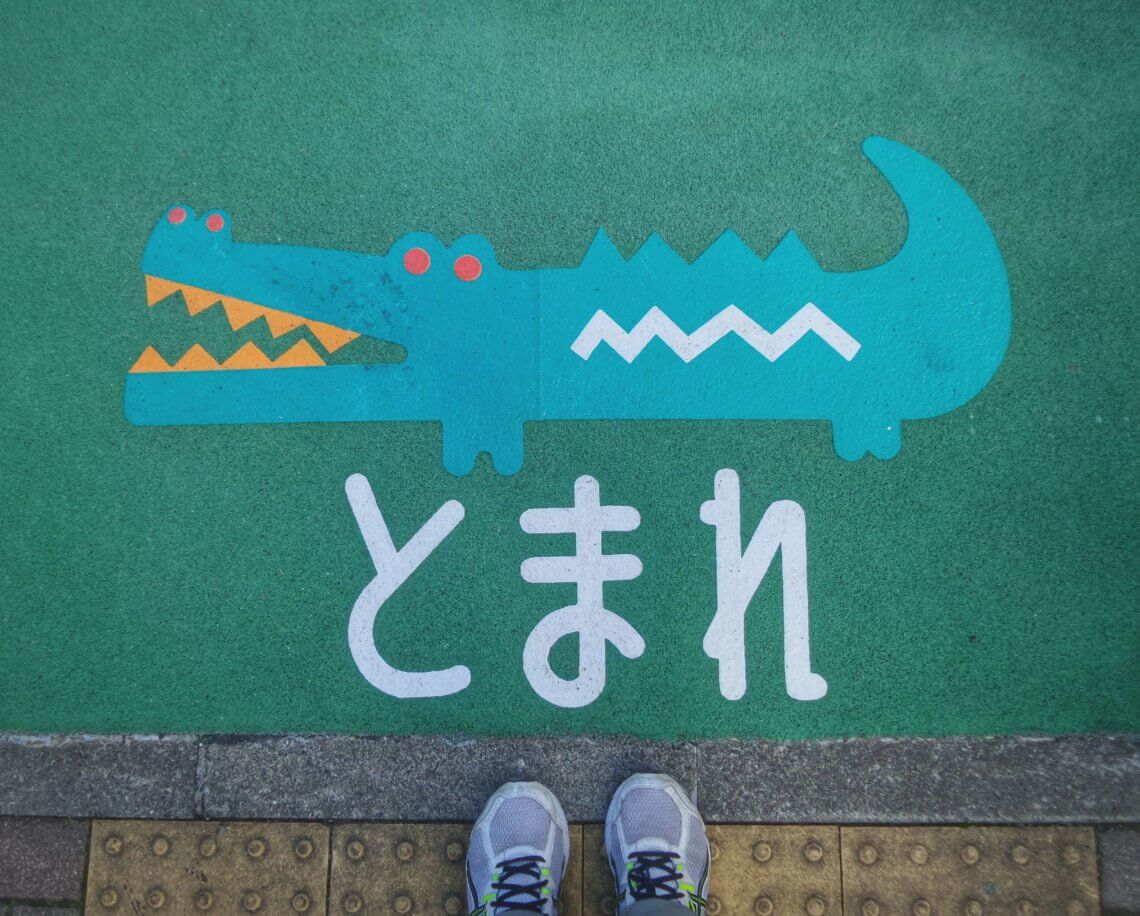
The Most Essential Japanese Words & Phrases for Your Trip to Japan
Learning Japanese can seem daunting, but don’t worry. You don’t need to learn any of these words or phrases to have a great time (see why we love Japan ).
However, as any seasoned traveler knows, making a little linguistic effort can go a long way, and it can be helpful to learn even a little of the local language for your travels. We’ve narrowed it down to a small selection of key words and phrases, divided by category:
- The Basics: Key Japanese Words and Phrases
- Food and Drink: Eating Your Way Around Japan
- Now or Later: Time-Related Phrases in Japanese
- Getting Around Japan: Transportation-Related Phrases
Here is a quick look at the words and phrase you’ll find below:
Top 20 Essential Japanese Travel Phrases:
- Konnichiwa (こんにちは) – Hello
- Arigatou Gozaimasu (ありがとうございます) – Thank you
- Sumimasen (すみません) – Excuse me
- __ o Kudasai (__をください) – I would like __, please
- __ wa Doko Desu ka? (__はどこですか) – Where is __?
- Itadakimasu (いただきます) – An expression of gratitude for the meal you’re about to eat
- Omakase de (お任せで) – Used to order chef’s recommendation (often for sushi)
- O-sake (お酒) – General term for alcohol
- Nihonshu (日本酒) – Japanese sake
- Kinen Seki (禁煙席) – Non-smoking seat
- Ima Nanji Desu ka? (今何時ですか) – What time is it now?
- Nanji ni? (何時に?) – At what time?
- Asa (朝) – Morning
- Kyou (今日) – Today
- Ashita (明日) – Tomorrow
- __ ni Ikitai (__に行きたい) – I want to go to __
- Tomete Kudasai (止めてください) – Stop, please
- Kippu (切符) – Ticket
- Shinkansen (新幹線) – Bullet train
- Dono Densha? (どの電車?) – Which train?
If you’re concerned about memorizing all this Japanese, or want to learn even more words and phrases, download Boutique Japan’s Tiny Phrasebook for free.
And for an introduction to how to say these words and phrases, see our bonus video to help you practice your Japanese pronunciation .
Basic Japanese Words and Phrases
Let’s start with a few of the most basic-yet-essential Japanese words and phrases. Even if you only remember how to say hello or thank you , you’ll find that Japanese people will be appreciative of your efforts!
1. Konnichiwa (こんにちは) – Hello
Let’s start with one you’ve probably heard before: the word for hello is konnichiwa .
Konnichiwa is typically used during the day, and there are other phrases for good morning and good evening ( ohayou gozaimasu , and konbanwa , respectively). But when you’re starting out it’s best to keep things simple, and if you simply learn konnichiwa you can use it throughout the day to say hello !
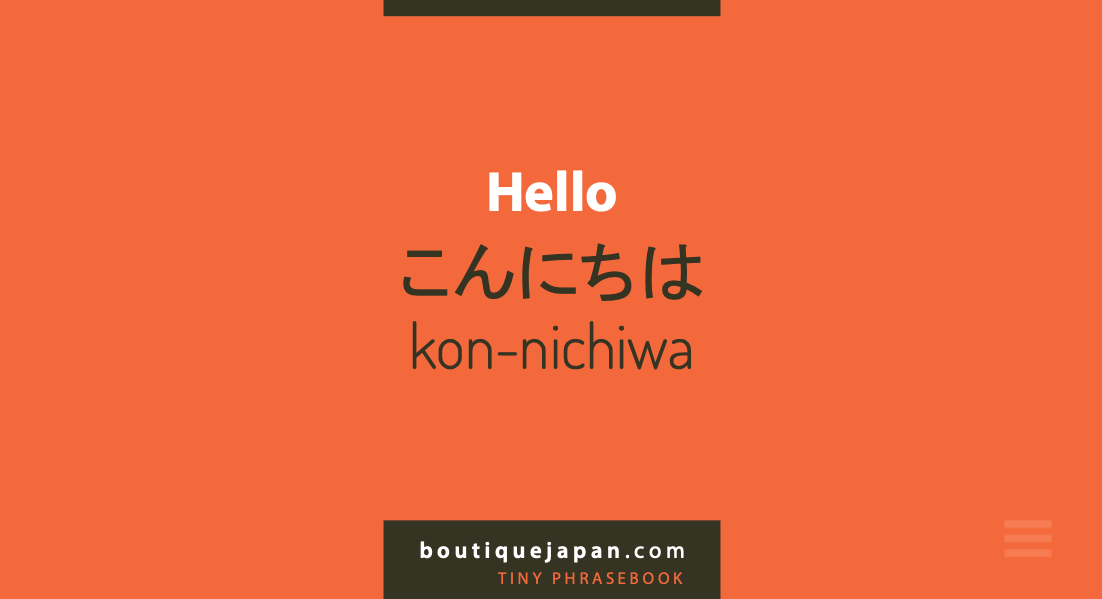
2. Arigatou Gozaimasu (ありがとうございます) – Thank you
In Japan, etiquette is no joke, and chances are you’ll be saying thank you a lot (learn more in our guide to Japanese etiquette ).
The word for thank you in Japanese is arigatou gozaimasu (in Japanese, the u at the end of some words is barely pronounced to the point of being nearly silent). You can usually simply say arigatou , which is a little more casual but usually perfectly fine. In Japan, where politeness is such a key part of the culture, you’ll be saying arigatou gozaimasu a lot!
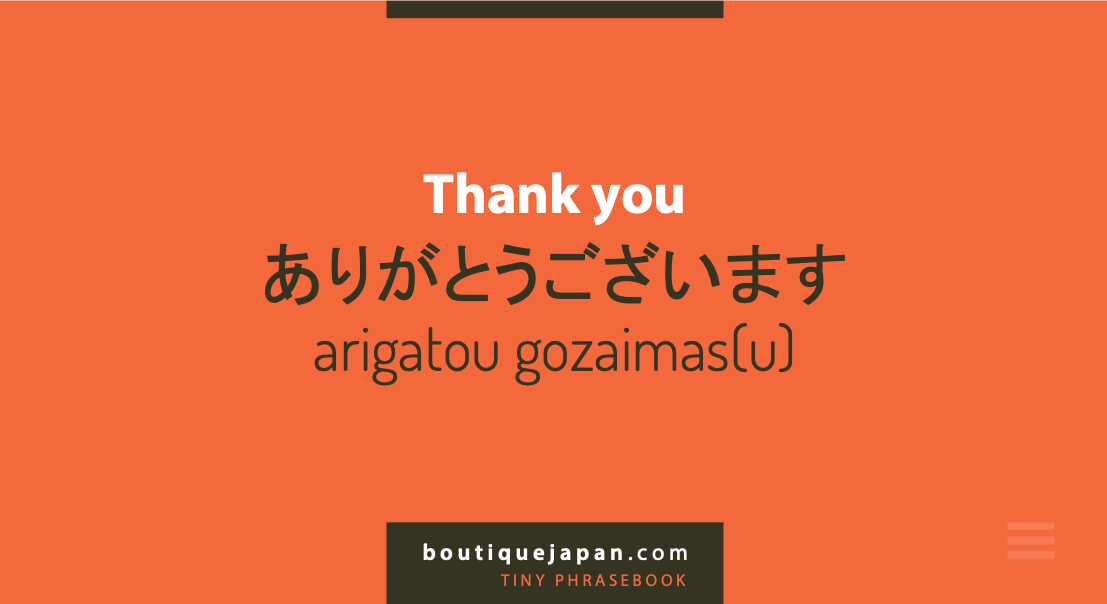
3. Sumimasen (すみません) – Excuse me
Excuse me is an important expression in any language, and Japanese is no exception.
The word for excuse me in Japanese is sumimasen . Chances are you’ll also be using this one quite a bit, so if you can try and memorize it! It’s a doubly useful word, as it can be used both to get a person’s attention, and also to apologize.
For example, use sumimasen at an izakaya (a Japanese-style gastropub) to get a waiter’s attention. At izakaya , it’s often called out as sumimaseeeeee~n ! On the other hand, if you accidentally walk onto a tatami floor with your shoes on (something you’re likely to do at some point) you can use sumimasen to say I’m sorry .

4. __ o Kudasai ( をください) – I would like , please
Now that we’ve covered three basic essentials, we can move onto two key sentences that will hopefully help you a lot.
First is I would like __, please . This is useful in a variety of situations: at restaurants, in stores, and on many other occasions you’ll encounter while traveling. In Japanese, it’s __ o kudasai (simply fill in the __ [blank] with the item of your choice).
To get the most out of this phrase, you may want to learn a few vocabulary words, such as water (mizu), beer (biiru) , sake , and others you think you may need.
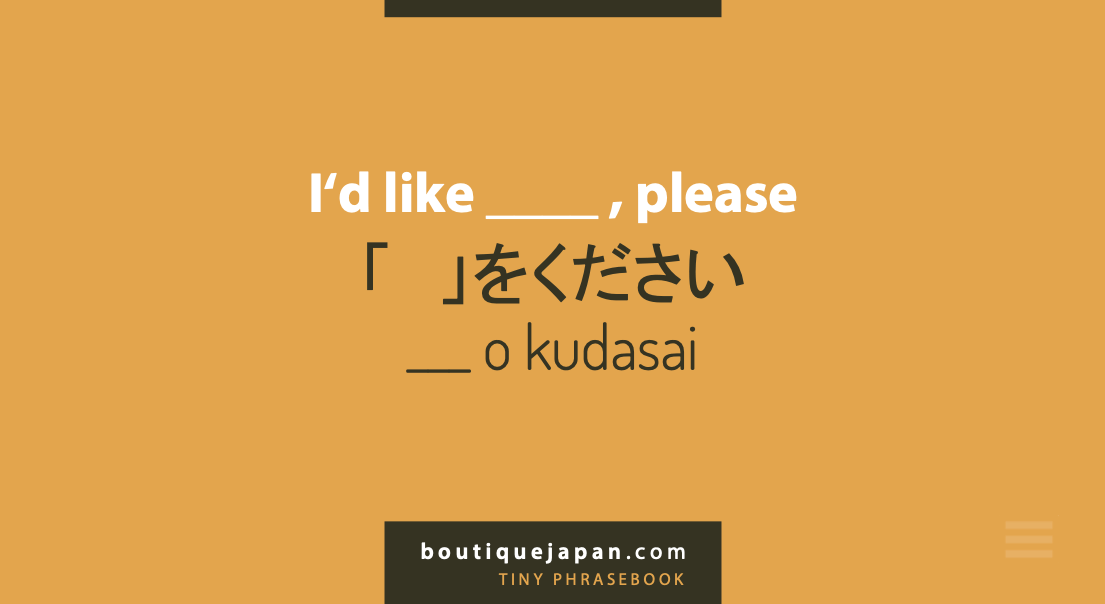
5. __ wa Doko Desu ka? ( はどこですか) – Where is __?
Last but not least, we think it’s quite useful to be able to ask Where is the __? This is useful even if you can’t understand the answer, because once you ask, people will be able to point you in the right direction, or even help you get to where you’re going!
In Japanese, it’s __ wa doko desu ka? (simply fill in the __ [blank] with the place you’re trying to reach, such as the Ghibli Museum ). One key vocabulary word that often goes along with this phrase for travelers is eki , which means station (for example, Shinjuku eki is Shinjuku station ).
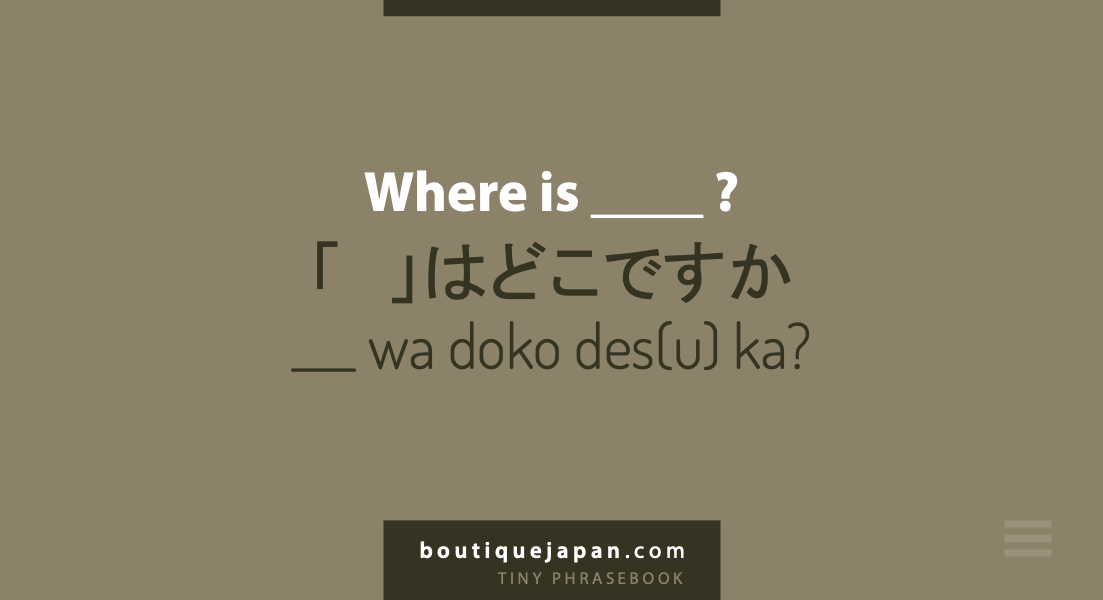
Eating Your Way Around Japan: Food and Drink Phrases
For many travelers, Japanese food is a top priority! From classic Tokyo sushi restaurants to the legendary food culture of Okinawa , there’s a lot to take in. For alcohol afficionados, Japan also offers sake , Japanese whisky , shochu , and other traditional beverages.
While you don’t need to speak any Japanese to enjoy eating and drinking in Japan, these key words and phrases will help you make the most of your culinary experiences.
6. Itadakimasu (いただきます) – An expression of gratitude for the meal you’re about to eat
Certainly not required, but if you say itadakimasu before you begin eating, whether in a restaurant or at a person’s home, they will surely be impressed with your manners.
Essentially, this phrase expresses humility and thanks for the meal you are about to enjoy. The website Tofugu does a very nice job of explaining the meaning of itadakimasu .

7. Omakase de (お任せで) – Used to order chef’s recommendation (often for sushi)
If you’re a passionate sushi enthusiast, you probably already know the meaning of omakase .
When you tell a chef omakase de , you’re letting them know that you’re placing the meal in their hands. Especially for travelers with adventurous palates, this is the best way to experience a meal at a Tokyo sushi shop , for example.
However, the phrase is not only used at sushi restaurants, and can often be used at other types of establishments as well.

8. O-sake (お酒) – General term for alcohol
Technically osake , this word has tripped many a non-Japanese speaker up! While in English the word sake means, well, sake , in Japanese the word sake — more politely, osake — refers to alcoholic beverages in general.
( Sake and osake are virtually interchangeable; the “o” is what is known as an honorific prefix, but unless you’re studying Japanese in more depth, you really don’t need to worry about this!)
So if you’re looking for sake (which in Japanese is called nihonshu) , it’s best to ask for nihonshu (see below). If you’re simply looking for an adult beverage (such as nihonshu , shochu , or Japanese whisky ), the catchall term sake will do the trick.

9. Nihonshu (日本酒) – Japanese sake
See above for the distinction between sake and nihonshu !
10. Kinen Seki (禁煙席) – Non-smoking seat
Encountering cigarette smoke is somewhat of an unavoidable aspect of traveling around Japan. This being said, most of our travelers are quite averse to smoke, and fortunately it’s possible to travel around Japan without smoke becoming too much of a nuisance.
In some places, such as restaurants, you may have a choice between the smoking and non-smoking sections. Kinen means non-smoking, and seki means seat : put them together and you’ve just conveyed that you’d like to be seated in the non-smoking area!

Time-Related Phrases in Japanese
Time-related phrases can be extremely helpful in certain travel situations, and below you’ll find a few of the most practical Japanese words and phrases on this topic.
11. Ima Nanji Desu ka? (今何時ですか) – What time is it now?
Chances are you’ll have a watch or cell phone on you, but once in a while you may need to ask a stranger for the time.
The basic phrase is simply nanji desu ka? which means, What time is it? People also commonly say ima nanji desu ka? which simply means, What time is it now? ( Ima means now.)

12. Nanji ni? (何時に?) – At what time?
This is a particularly useful phrase while traveling. It can be helpful when purchasing rail tickets (see more on getting around Japan below), making meal reservations, or arranging tickets to events.
Sure, you could just ask nanji? ( what time? ) and hope your point gets across, but by adding the preposition ni you can be assured of much more clarity!

13. Asa (朝) – Morning
This one is fairly self-explanatory: asa means morning . While it’s no surprise that a food-loving culture like Japan has multiple words for breakfast , one of the most common is asagohan ( gohan literally means rice , but is more generally used to mean food ).

14. Kyou (今日) – Today
Words like today and tomorrow can be particularly useful when buying train tickets, for example. For more on transport, see the transport-related phrases below.

15. Ashita (明日) – Tomorrow
When pronouncing the word for tomorrow, ashita , the i is virtually silent, so it ends up sounding more like ashta . If you need to express the day after tomorrow, the word is asatte .

Getting Around Japan: Transportation-Related Phrases for Travelers to Japan
For some travelers, one of the biggest concerns about not speaking the language is the prospect of getting around the country, navigating the trains, and trying to avoid getting lost.
Fortunately, Japan has an incredibly efficient and easy-to-use rail network, and you can read all about it in our guide to train travel and getting around Japan . And here are some key Japanese words and phrases to help you on your way.
16. __ ni Ikitai ( に行きたい) – I want to go to __
On its own, ikitai means, I want to go .
To express that you’d like to go somewhere, use the phrase __ ni ikitai (simply fill in the __ [blank] with the place you’re trying to reach). For example, Kyoto ni ikitai means, I want to go to Kyoto .

17. Tomete Kudasai (止めてください) – Stop, please
Tomete means stop , and is particularly useful in taxis. The kudasai here means please , and makes the phrase much more polite ( tomete on its own would come off as quite brusque).

18. Kippu (切符) – Ticket
Kippu means ticket (as in train tickets). As you can easily imagine, when purchasing rail tickets it can be very useful to be able to tell the ticket agent that you’d like a ticket to a certain place!
Made means until or to (in this case, to your destination). For example, Osaka made means to Osaka . Thus, Osaka made no kippu means ticket to Osaka . Put it all together with kudasai (for politeness) and you have Osaka made no kippu o kudasai .

19. Shinkansen (新幹線) – Bullet train
Ah, the shinkansen . One of the utter joys of traveling around Japan is the world-famous shinkansen (bullet train).
Whether you have the well-known Japan Rail Pass or not, if you’re doing any domestic travel within Japan, chances are you’ll end up on the incredible (and incredibly pleasant) shinkansen for at least one if not more of your journeys. Enjoy, and grab a bento and some nihonshu (see above) for the ride!

20. Dono Densha? (どの電車?) – Which train?
Wondering which train you need? Imagine you’re in Kyoto Station, headed for Tokyo. You’re on your shinkansen’s departure platform, but you see two trains.
You show your ticket to a friendly Japanese person, and ask, dono densha? They take a look at your ticket and the two trains, and point you to the right one. And you’re on your way – happy travels!

Download our Free Japanese Phrasebook PDF
For those of you who want to learn even more Japanese for travel, we’ve created the Boutique Japan Tiny Phrasebook.
Our Tiny Phrasebook features carefully selected Japanese words and phrases designed to help you get the most out of your trip to Japan. You’ll find all of the words and phrases featured above, and many more!
The phrasebook is a beautifully designed PDF (it may take a few moments to load depending on your internet speed).
Simply save it to your smartphone, tablet, or computer. We suggest using an app like iBooks (or another PDF reader) so you can search for words and navigate easily.
Bonus Video: Practice your Japanese Pronunciation
One of the best things about Japanese is that it’s surprisingly easy to pronounce. Unlike several other languages throughout Asia, Japanese is not a tonal language.
In the video below, we go over basic pronunciation for some of the most useful Japanese words and phrases for your trip to Japan.
Do you need to speak any Japanese to travel around Japan ?
Absolutely not. You can travel to Japan without learning any of these words and have a great time.
People ask us about the Japanese language barrier all the time, with common questions such as, Do Japanese people speak English? How much (or how little)? The language barrier is a common myth that shouldn’t get in your way. Most of our travelers don’t speak a single word of Japanese, yet come back with testimonials of how much they love Japan .
The truth is that most Japanese people speak at least a little bit of English. These days, all Japanese students study English for a minimum of six years in secondary school, and many students — as well as adults — also take English-language classes after school or on weekends.
English-language fluency is not widespread, so most people you meet probably won’t be fluent in English, but almost everyone you meet will know at least a few English words – and many will know anywhere from hundreds to thousands.
Sometimes you may find that the people you meet are hesitant to try their English on you, but you’ll likely find that you can communicate in basic English in a huge variety of situations while traveling around Japan.
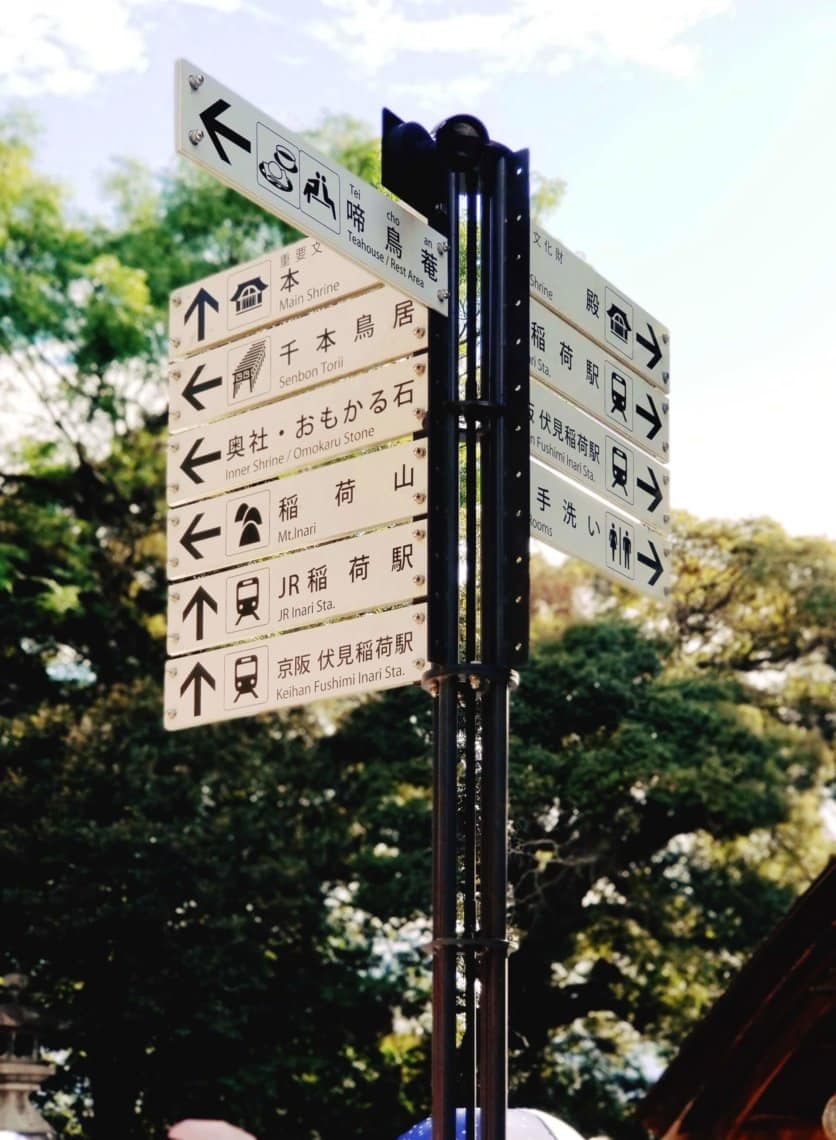
The Japanese Written Language
You may also be worried about the written language. The good news is that you don’t need to be able to read or write Japanese to enjoy Japan.
Japanese people don’t expect you to be able to read the Japanese language, and you’ll find English-language signage throughout the country. This is especially true in places frequented by travelers, such as sightseeing spots, shopping areas, train stations, airports, and often even on the street.
As for at restaurants, though it’s not always the case, in some cases you will find English-language menus. When English-language menus are not available, photos are often included to make pointing and ordering possible.
Despite Japan’s travel-friendliness, every visitor to Japan at some point finds him or herself in a situation in which linguistic communication is simply not possible, and sign language and gesturing are required.
Getting lost in a foreign country where you don’t speak the language is a fear of many would-be travelers, but if you had to pick a country in which to get lost, you couldn’t do much better than Japan! Japan is by far one of the safest countries in the world, with crime rates that are astonishingly low compared to places like the US and most of Europe. And Japanese people will often go to surprising lengths to help tourists.
Back when I first moved to Japan I spoke very little Japanese, and on my first visit to Kyoto I accidentally took the wrong train and ended up wandering around a neighborhood with no idea how to get where I wanted to go. Luckily, an older gentleman with his wife spotted me looking confused and came up to me with perhaps one of the only English phrases he knew: “ Are you lost? ” I said yes and showed him the name of the place I wanted to go.
If he had simply pointed me in the right direction it would have been helpful, but instead he started walking me in the right direction. After a few minutes of walking his wife split off, presumably to go home, and we continued. After 15 minutes of walking he had dropped me off at exactly the spot I needed to be, and – as is typical in Japanese culture – expected nothing in return. I thanked him profusely and we had a good laugh despite our inability to communicate linguistically.

Why Learn Any Japanese if You Won’t Need it?
Almost everyone who has visited Japan has a similar story of a random act of kindness and generosity from a Japanese stranger (or a tale of a camera or passport left on a train being miraculously returned). So you can rest assured that even if you forget all of the words and phrases we’ve shown, you’ll be in good hands with the wonderful people of Japan.
But aside from the fact that it’s a rich and fascinating language, learning even just one or two Japanese words or phrases will help endear you to the Japanese people you meet during your trip, and enhance your overall travel experience.
Japanese people tend to be extremely appreciative of visitors who take the time to learn even just a word or phrase or two, and if you try then chances are you’ll be greeted with oohs and aahs of encouragement.
We hope you’ve found our guide to Japanese words and phrases for travelers helpful. Arigatou gozaimasu!
More Great Posts

Is Japan Expensive?
One of the most common myths about Japan is that it’s incredibly pricey — but how expensive is Japan really?…

Japan’s Best Boutique and Luxury Hotels & Ryokans
The best hotels and ryokans in Japan range from charming traditional inns in the countryside, to stylish design hotels and…

Traveler’s Guide to the JR Pass (Is It Worth It?)
The Japan Rail Pass (or JR Pass, for short) can be a good way to get around Japan, but many…
Plan Your Japan Trip
Learn more and contact us to discuss your unique trip.
Get Started
- The Process
- Testimonials
You are using an outdated browser. Please upgrade your browser or activate Google Chrome Frame to improve your experience.
Japanese Phrases for Tourists: 116 Essential Phrases for Your Japanese Vacation
Before I traveled to Japan for the first time, everyone assured me that “Everybody speaks English there,” and I wouldn’t need to use Japanese at all.
But in reality, most of the people I encountered in Japan had a fairly elementary level of spoken English .
For a better travel experience, you should learn some basic travel words and phrases in Japanese.
Greetings and Basic Japanese Phrases
Airport phrases you’ll hear, airport phrases you’ll use, asking for directions, receiving directions, transportation phrases, hotel phrases, eating and drinking in japan: what you’ll hear, eating and drinking in japan: what you’ll say, shopping in japan: phrases you’ll hear, shopping phrases you’ll use, number of items in japanese, tips to use your new phrases: politeness and pronunciation, how to study these japanese travel phrases.
Download: This blog post is available as a convenient and portable PDF that you can take anywhere. Click here to get a copy. (Download)

I’ll provide the hiragana, kanji and romaji for each word, and will explain the use of certain Japanese phrases for tourists in context.
1. Hello — konnichiwa
2. good morning — ohayou gozaimasu, 3. nice to meet you — hajimemashite, 4. goodbye — sayounara, 5. please — onegaishimasu, 6. thank yo u — arigatou gozaimasu, 7. you’re welcome — dou itashimashite, 8. excuse me/sorry — sumimasen.
This is definitely one to memorize. I say すみません at least 30 times a day in Japan. It’s a magical word.
It helps you push through a crowd, get attention from a waiter, ask for directions or be excused for basically any touristy blunder.
Simply saying すみません and gesturing is a pretty good way to express that you need help, but don’t speak Japanese.
9. Yes — hai
10. no — iie, 11. let’s eat/ “bon appetit” — itadakimasu .
Similar to the French “ bon appetit” , this is what Japanese people say before they eat. It doesn’t have a literal translation in English, but it’s a way to give thanks for a meal .
You should also remember this phrase’s pair: ごちそうさま (gochisousama) or ごちそうさまでした (gochisousama deshita). These phrases are used at the end of a meal and translate as “What a good meal,” or “Thank you for the meal,” the latter being the more polite form.
12. I don’t understand — wakarimasen
13. i don’t speak japanese — nihongo o hanashimasen, 14. do you speak english — eigo o hanashimasu ka , 15. can you please repeat that — mou ichido itte kudasai, 16. can you please speak slowly — yukkuri hanashite kudasai, 17. what is your name — onamae wa nan desu ka, 18. my name is… — watashi no namae wa…, 19. what is this — kore wa nan desu ka.
これ and それ literally just mean “this” and “that.”
20. How much does this cost? — kore wa ikura desu ka?
If you’re pointing at something that you can’t reach, you say それは いくらですか?
21. Can you please help me? — tasukete moraemasuka ?
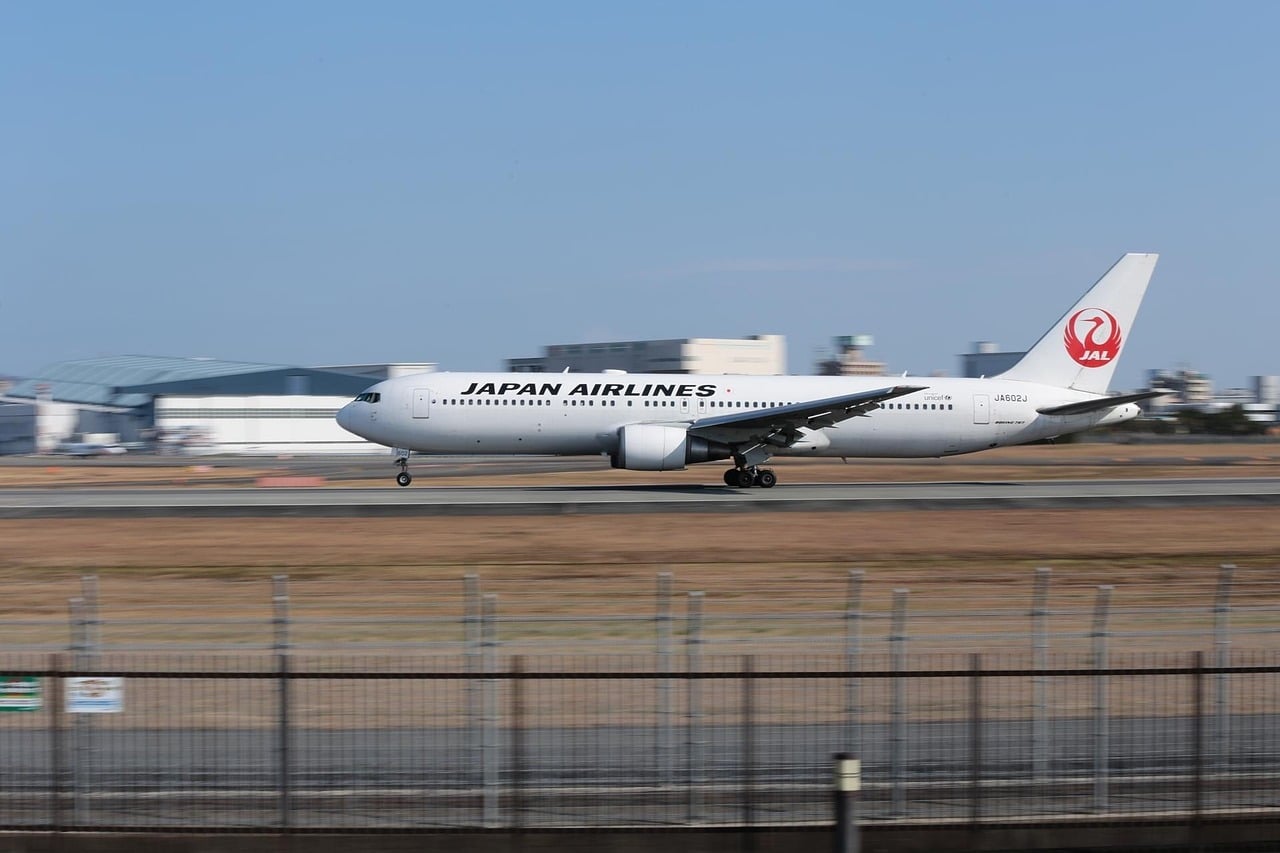
Japanese airports aren’t just places to land: they’re an entire cultural showcase on their own. For example, at the Narita Airport , you’ll see pet hotels , gacha machines , the (in)famous smart toilets and even a Pokémon Store !
22. Welcome, please come in — yokoso, o-hairi kudasai
23. please show your ticket — chiketto o misete kudasai, 24. please show your passport — pasupooto o misete kudasai, 25. what is your reservation name — yoyaku-mei wa nan desu ka, 26. the flight is delayed — furaito chien shiteimasu, 27. the flight has been canceled — furaito kyanseru saremashita, 28. baggage claim is this way — baggeji kureimu wa kochira desu, 29. we have arrived at … airport — … kuko ni tochaku shimashita, 30. we will depart for … airport — … kuko e shuppatsu shimasu, 31. there is a delay in the flight — furaito ni okure ga arimasu, 32. there are restrictions on carry-on baggage — kinai mochikomi no nimotsu niwa seigen ga arimasu.
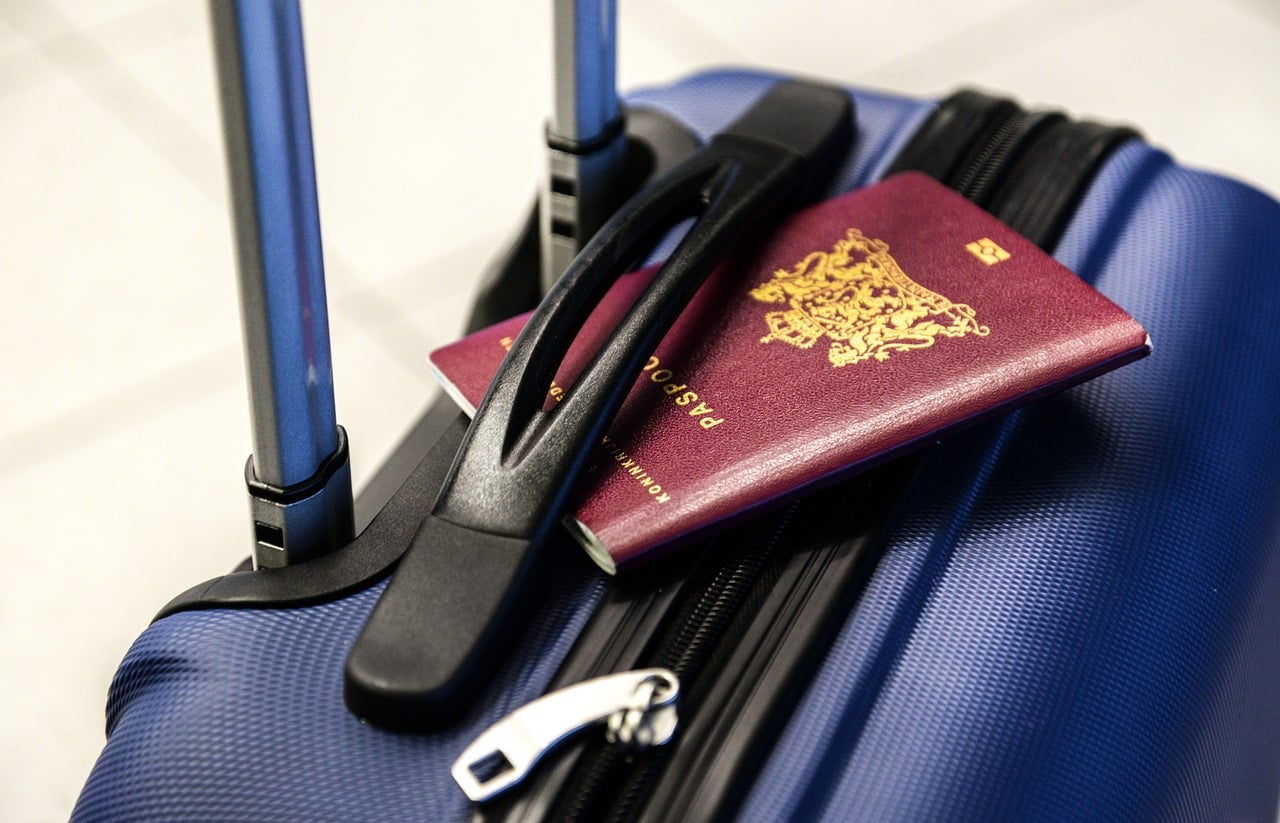
33. Please tell me how to get to the airport — kuko e no ikikata o oshiete kudasai
34. is this a departure flight — korewa shuppatsu-bin desu ka, 35. is this an arrival flight — korewa tochaku-bin desu ka, 36. where is the boarding gate — tojyo-guchi wa doko desu ka, 37. i’ll check my baggage — tenimotsu azukemasu, 38. please call a taxi — takushii o yonde kudasai, 39. i’d like to rent a car — rentakaa o karitai desu, 40. where is the gate for the connecting flight — noritsugi-bin no geeto wa doko desu ka.

Asking for directions is sort of daunting, especially when the person answers in a whole stream of fast-paced Japanese.
But you’ll find that Japan is one of the best places to be a lost and hopeless tourist. There’s always someone nearby who’s more than happy to help. I’ve even had people take time out of their days to walk me where I needed to go!
Simply say wherever it is that you want to go followed by どこですか? — doko desu ka? (Where is …?).
41. I want to go… (here) — (koko) ni ikitai desu
Say ここ if you have an address written down or a point marked on a map of where you want to go.
If you know the name or address of the place where you want to go, simply say the place name followed by に行きたいです . For example, if you want to go to Shinjuku station, you simply say 新宿駅に行きたいです — Shinjuku eki ni ikitai desu . (I want to go to Shinjuku station.)
42. Where is the…? — …wa doko desu ka?
43. can you please show me where we are on the map — watashitachi ga doko ni iru no ka, chizu de oshiete kudasai.
This might seem like an odd question (and a bit of a mouthful), but it can be a lot more helpful than asking for directions from someone who doesn’t know English.
44. Is it near? — chikai desu ka?
45. is it far — tooi desu ka.

46. Go straight ahead — massugu itte kudasai
47. turn left — hidari ni magatte kudasai, 48. turn right — migi ni magatte kudasai.

In Japan, public transportation is how most people get around. If you’re not used to taking the bus, train or anything similar, better keep the following phrases handy!
49. Take me to this address, please — kono jyusho made tsureteitte kudasai
50. what is the fare — ryoukin wa ikura desu ka, 51. stop here, please — koko de tomatte kudasai, 52. does this bus go to (street name) — kono basu wa … ni ikimasu ka, 53. does that train stop at … — sono denshya wa … de tomarimasu ka, 54. a map, please — chizu o onegai shimasu, 55. this hotel — k ono hoteru, 56. the subway — chikatetsu , 57. the train station — denshya no eki, 58. the bus stop — basutei, 59. the taxi stand — takushii noriba, 60. the exit — deguchi, 61. the entrance — iriguchi, 62. the bathroom — toire.

Like other service-oriented businesses in the country, Japanese hotels subscribe to the concept of omotenashi , which roughly translates to pouring your whole heart into service. That means you can expect employees at Japanese hotels to go above and beyond when it comes to making you feel welcome.
63. I have a reservation under the name of … — … no yoyaku o shiteimasu
64. i would like to check-in — chekkuin shitai desu, 65. what time is check-in — chekkuin wa nanji desu ka, 66. is breakfast included — choshoku wa fukumareteimasu ka, 67. where is my room — watashi no heya wa doko desu ka, 68. please give me a wake-up call at … — … ni weikuappu kooru onegaishimasu., 69. where is the nearest convenience store — ichiban chikai konbini wa doko desu ka, 70. can you recommend a good restaurant nearby — chikaku no oishii resutoran o shokaishite moraemasu ka, 71. what time is check-out — chekkuauto no jikan wa nanji desu ka, 72. where can i store my luggage — nimotsu wa dokoni azukeraremasu ka, 73. is there wi-fi in the hotel — hoteru ni wa wai-fai ga arimasu ka, 74. where is the nearest atm — ichi-ban chikai atm wa doko desu ka, 75. i’d like to have some extra towels, please — yobun no taoru o kudasai., 76. what time is breakfast served — choshoku wa nanji kara desu ka, 77. excuse me, i need an iron and ironing board — sumimasen, airon to iron-dai ga hitsuyo desu..
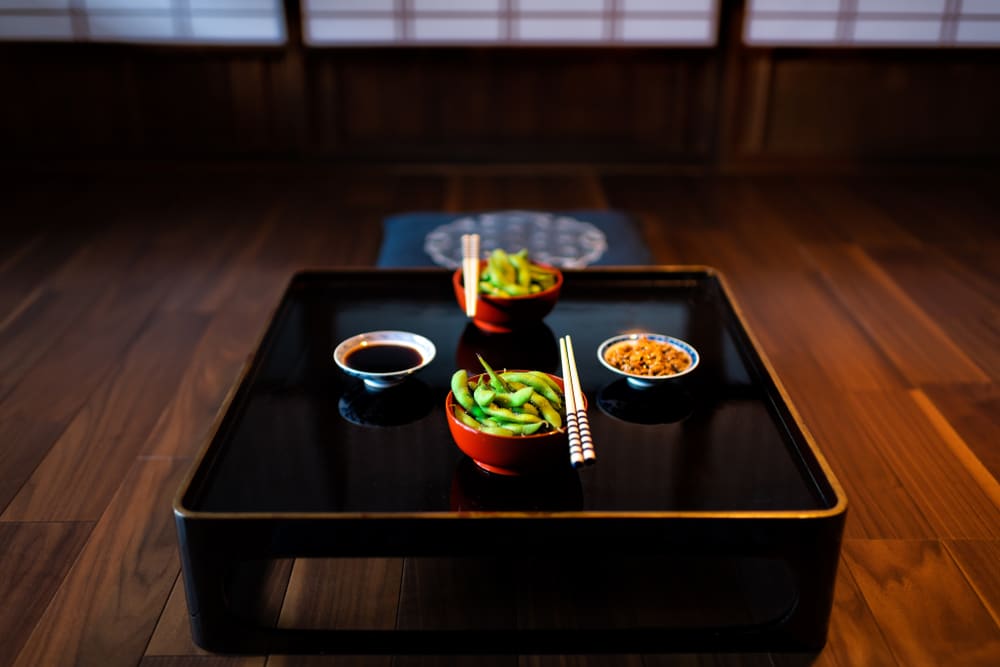
Like Japanese hotels, Japanese restaurants also practice omotenashi. Here are some of the more common phrases you’ll hear from Japanese restaurant staff.
78. Welcome — Irasshaimase
79. how many people in your party — nan mei sama desu ka, 80. this way, please — kochira e douzo, 81. certainly (in response to your order) — kashikomarimashita, 82. thank you for waiting — omatase itashimashita.
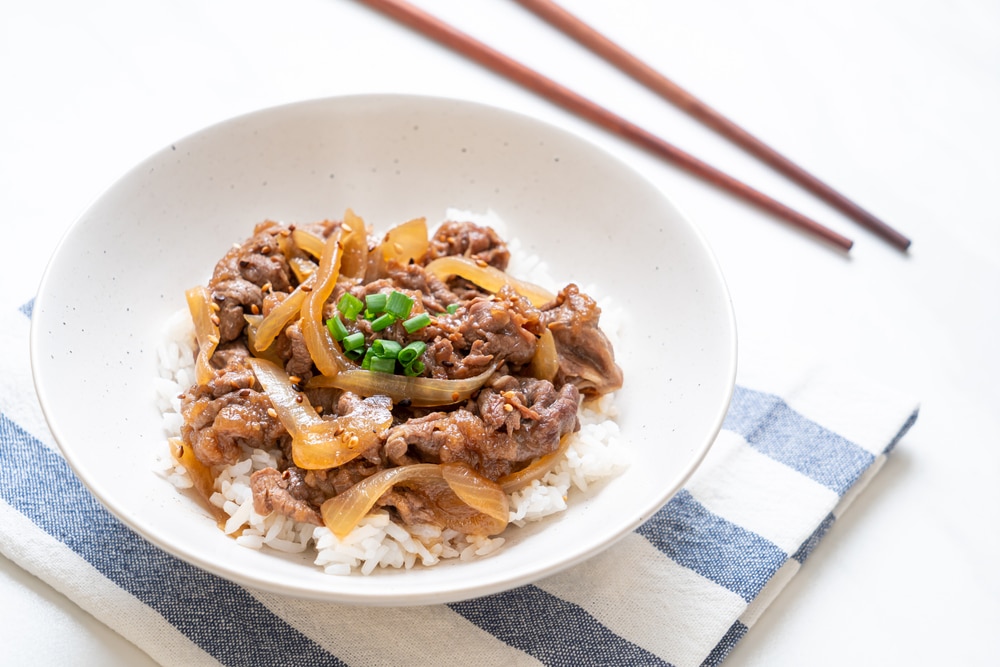
The best restaurants in Japan are the authentic ones that don’t cater to tourists. But these are also the places that have no English menus, and sometimes no English-speaking waitstaff.
Luckily, it’s very common for Japanese menus to feature photos of all the dishes. And many places have models of their dishes on display, so you likely won’t be going in completely blind.
Use these phrases , and you should be in and out of a restaurant without too many hiccups.
83. A table for two, please — futari you no teeburu o onegai shimasu
You can also replace futari with the number of people who you need to have seated:
- one — hitori ( 一人 )
- three — sannin ( 三人 )
- four — yonin ( 四人 )
If you’re confused about Japanese numbers and counters, don’t despair. You can just do as the locals do and indicate the number of diners by holding up your fingers.
84. The menu, please — menyu o onegai shimasu
85. what are today’s recommendations — kyo no osusume wa.
If everything on the menu looks appetizing and you’re not quite sure what to order, use this phrase.
86. Water, please — mizu o onegai shimasu
87. two beers, please — biiru o nihai onegai shimasu, 88. can i please have (one, two) of this — kore o (hitotsu, futatsu) onegai でdekimasu, 89. do you have a vegetarian dish — bejitarian youno ryouri ga arimasu ka.
I’ve traveled in Japan with vegetarians twice, and this question usually draws quite strange looks. Vegetarianism basically doesn’t exist in Japan, although Japanese cuisine is generally quite vegetarian-friendly.
It might work better to say これは肉ですか? — kore wa niku desu ka? , to say “is this meat?” Follow up with 私は肉を食べません — watashi wa niku o tabemasen, which means “I don’t eat meat,” if you want to make yourself understood.
90. Is … in it? — … wa haitte imasu ka?
Alternatively, you can also ask if specific ingredients are included in your food, so you’ll know whether you should order it or not.
91. That’s okay — daijyoubu desu
You can also use this expression to ask someone if they’re okay. Just add the question particle ka to the end: 大丈夫ですか ? — daijyoubu desu ka?
92. The check, please — okanjyou o onegai shimasu
Say the above, or you can do as the locals do and catch the waiter’s eye (with a smile!) and draw a clockwise circle in the air with your index finger pointing towards the roof.
In some restaurants, you need to bring the check to the cash register which is usually located by the restaurant’s doorway.
93. Cheers! — kanpai!
94. it was delicious — oishikatta desu, 95. water — mizu, 96. wine — wain, 97. beer — biiru , 98. tea — ochya, 99. coffee — coohii, 100. juice — juusu, 101. meat — niku, 102. chicken — toriniku , 103. pork — butaniku, 104. beef — gyuniku , 105. fish — sakana , 106. rice — gohan, 107. bread — pan , 108. vegetables — yasai , 109. fruit — kudamono.
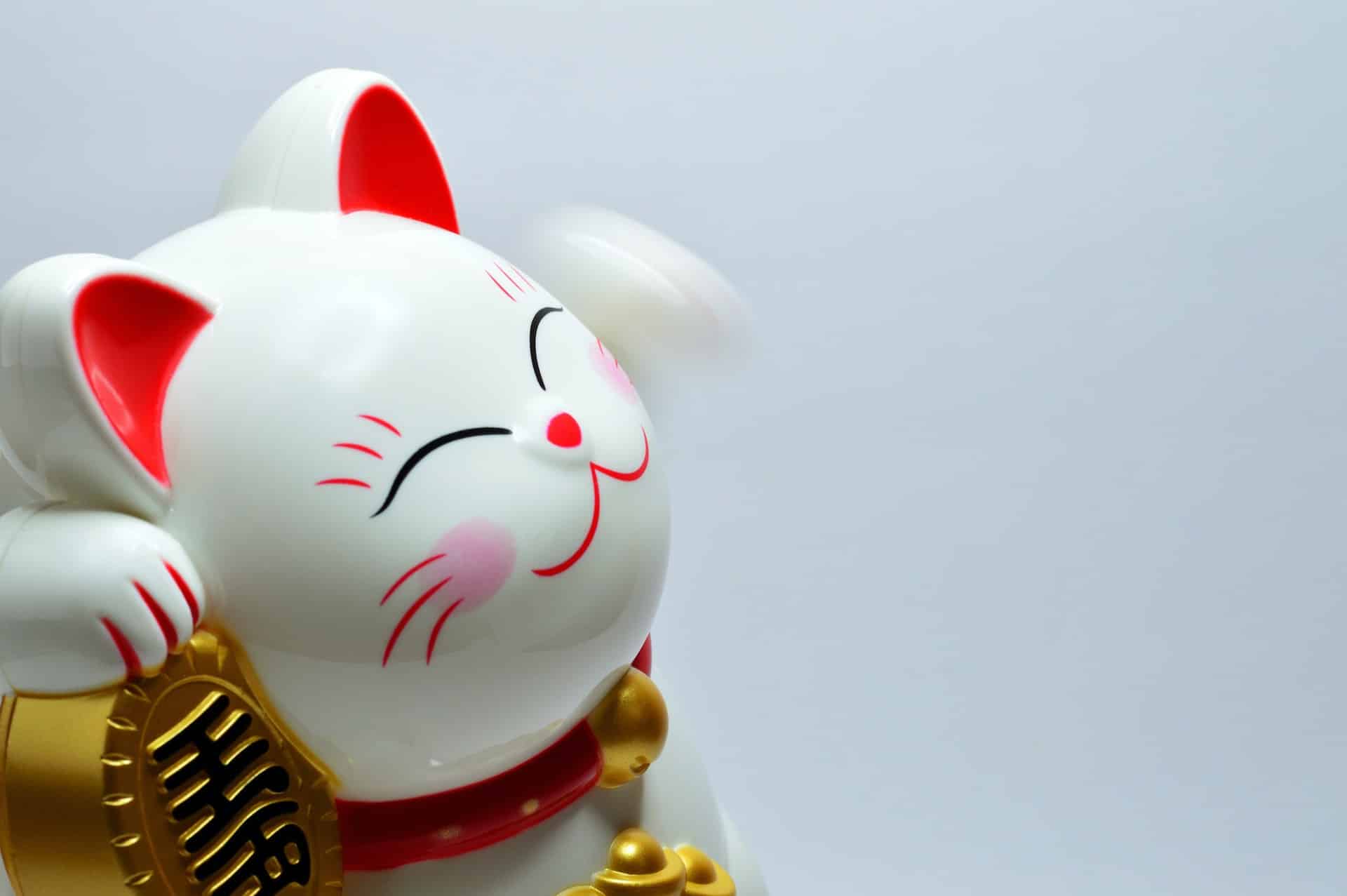
When you’re met with cries of いらっしゃいませ!, you’re not really expected to respond to this greeting. As for me, I just smile and say こんにちは which means, of course, “hello.”
Walking into a department store is particularly surreal, with each assistant taking cues from the others, so that every time a customer walks in, いらっしゃいませ bounces around the entire floor.
110. Are you looking for something? — nani ka osagashi desu ka?
111. is that all — ijyou de yoroshii desu ka, 112. here it is / here you go — hai, douzo.

113. I would like this — kore o onegai shimasu
114. i would like one of those — sore o hitotsu onegai shimasu, 115. i would like to pay in cash — genkin de onegai shimasu, 116. i would like to pay by credit card — kurejitto kaado de onegai shimasu.
The only real challenge with ordering meals in Japanese is the use of counters.
We have counters in English, too (for example “sheets” of paper, “glasses” of water, “blades” of grass), but not as many or as complicated as in Japanese.
Luckily Japanese has a “universal” counter, つ ( tsu ), which you can use for anything, including food.
The numbers one to four as つ counters are pronounced 一つ ( hitotsu )、 二つ ( futatsu )、 三つ ( mittsu ) and 四つ ( yottsu ). You can use this counter for drinks too, and the waiter will understand you.
However, if you want to be a little more impressive, you can use the drinks counter: 杯 ( hai/bai/pai depending on the number used with it). The numbers one to four using this counter are 一杯 ( ippai )、 二杯 ( nihai ) 、 三杯 ( sanbai ) and 四杯 ( yonhai ).
If you want to learn more about counters, this post explains them in more detail.
All the examples I’ve given are in the polite, neutral form of speech . You basically can’t go wrong speaking this way in Japan, so you don’t need to worry about making any social faux pas!
Some notes on pronunciation:
- Avoid turning vowels into dipthongs (vowel sounds that run into each other, like the oi in “coin”). Pronounce each vowel on its own even when there are two vowels next to each other. Onegai is read as “o-ne-ga-i,” not “o-ne-gai”
- The sound ou and repeated vowels like ii and ee are exceptions: they show an elongation of the sound. Ohayou is read as “o-ha-yoh,” not “o-ha-yo-u.”
- Treat ん (n) as its own syllable. Konnichiwa is read “ko-n-ni-chi-wa,” not “ko-ni-chi-wa.” It’s subtle, but it makes a difference!
- Repeated consonants are pronounced. For an example of how to do this, just read the word “bookkeeper” out loud.
- The small kana っ like in いって signify a break between the sounds —”it-te,” not “i-te.”
- Small y- kana like ゃ in おちゃ add the y sound to the preceding syllable —”o-chya,” not “o-chi-a.”
- は (ha) as a particle is pronounced wa, and を (wo) as a particle is pronounced o.
The beauty of Japanese is that it’s an extremely phonetic language, so if you say the words exactly as you read them, you can’t really get them wrong.
Having said that, people will probably struggle to understand you if you speak in a strong non-Japanese accent, so it might pay to listen to some spoken Japanese before you start practicing pronunciation.
The most important thing to remember is that, unlike English speakers, Japanese speakers don’t put emphasis on the second or third syllable of a word—there’s some emphasis on the first syllable, but it’s subtle.
Some ways that you can listen to Japanese being spoken is by watching Japanese films , television programs , anime or YouTube clips .

The Japanese language program FluentU has a little bit of everything in the media, with interactive subtitles and customizable flashcards for a well-rounded learning experience.
Maybe this seems like a lot, but learning Japanese travel phrases for tourists will make your trip run more smoothly, and the people you meet will appreciate your effort.
Speaking the local language tends to get people on your side. They’re less likely to try to rip you off, and often will want to become your best friend.
I like to make little phrasebooks for myself when I travel, so I can have these Japanese travel phrases and vocabulary always on hand.
I’ve been treated to tea and dinner in people’s homes, and once was driven around a city with a personal guide/impromptu friend all day, just because I struck up conversations in the local language.
Don’t be scared! Give it a try!
Related posts:
Enter your e-mail address to get your free pdf.
We hate SPAM and promise to keep your email address safe

Learn Japanese
I want to learn Japanese!
If you follow the instructions in this over the top, step-by-step guide, you will reach your goal of Japanese fluency.
However, this journey is going to take a lot of effort and hard work on your part. Anyone who tells you learning a language is going to be easy is either misinformed or trying to sell you something. And eventually, after the honeymoon phase of learning wears off, progress feels slower. You burn out. Sh*t hits the fan. If you've ever tried learning something new, you know exactly what I'm talking about.
Instead, you need to do things the hard way (i.e. the correct way) right from the start.
Just because we're doing it right doesn't mean it has to be inefficient.
This method for learning Japanese starts at the very beginning. I assume you have zero knowledge of the Japanese language and guide you through each step. I'll cover reading, writing, speaking, and listening. And we explain what you should use, when, and why.
This should be everything you need to progress, that way you don't use all of that fresh enthusiasm you're feeling on planning how to learn, and instead spend it on actual learning.
Make like those famous shoes and just do it.
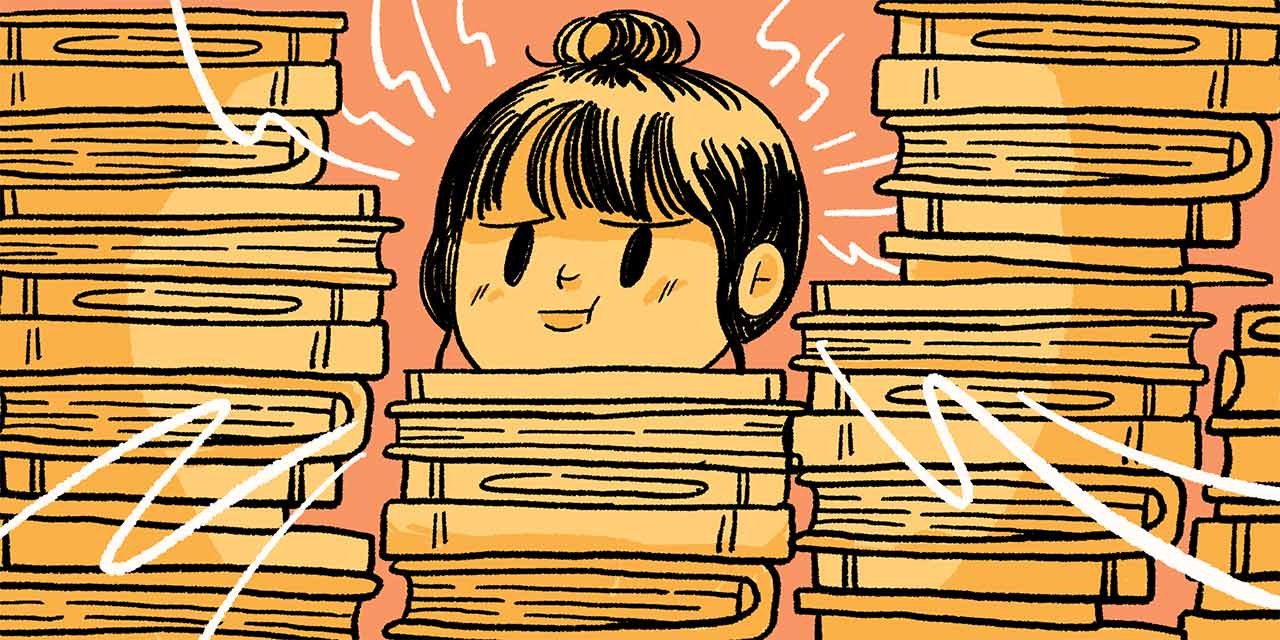
Our goal is to reach Japanese fluency as directly as possible. Unlike a teacher or a textbook, we have the freedom to be ruthless in the path we take to get there.
There are no tests or quizzes to take. You don't have to move at the speed of the slowest learner in your group. All you need to do is follow each step, do the work, and progress.
Just keep in mind that because of this, some steps may seem counterintuitive. They may even seem slow compared to other methods, but everything has been carefully selected to get you to the finish line faster and more efficiently. We'll talk more about that later.
A bit of housekeeping first: This is a living document, meaning it will be updated from time to time. Check back, subscribe to our email list , or follow us on Twitter to know when these updates happen. And, if you already have experience with Japanese, I still recommend you give it a read. There's a good chance you'll find something important to help you on your own Japanese language journey.
Table of Contents
Learn to read hiragana, basic japanese pronunciation, learning to type hiragana in japanese, understanding the concept of "kanji", beginning kanji & stockpiling kanji knowledge, learn to read katakana, learning to type katakana, learning to type kanji, 1. collecting vocabulary, 2. processing, 3. adding the words to your srs, beginning japanese grammar, a beginner's japanese textbook / program, answering your japanese language questions, order of learning, fact checking / cross referencing, do the work, sometimes, you'll just get stuck, optional: finding a japanese language tutor, suggested books and resources, intermediate level japanese, zero knowledge of japanese.
Welcome to learning Japanese! This section is for the true beginner. You know little-to-no Japanese. Maybe a "konnichiwa" here and a "baka" there. These first steps you take are especially important because they're going to set a foundation you can build off of.
The more deliberate your steps, the easier everything that follows will be.
Carefully completing this section is going to be necessary if you want to avoid the thing that takes down most learners: the intermediate wall. Instead, take your time on these foundational steps. What feels slow now is actually speed later on.
Estimated Time: 1 day to 1 week
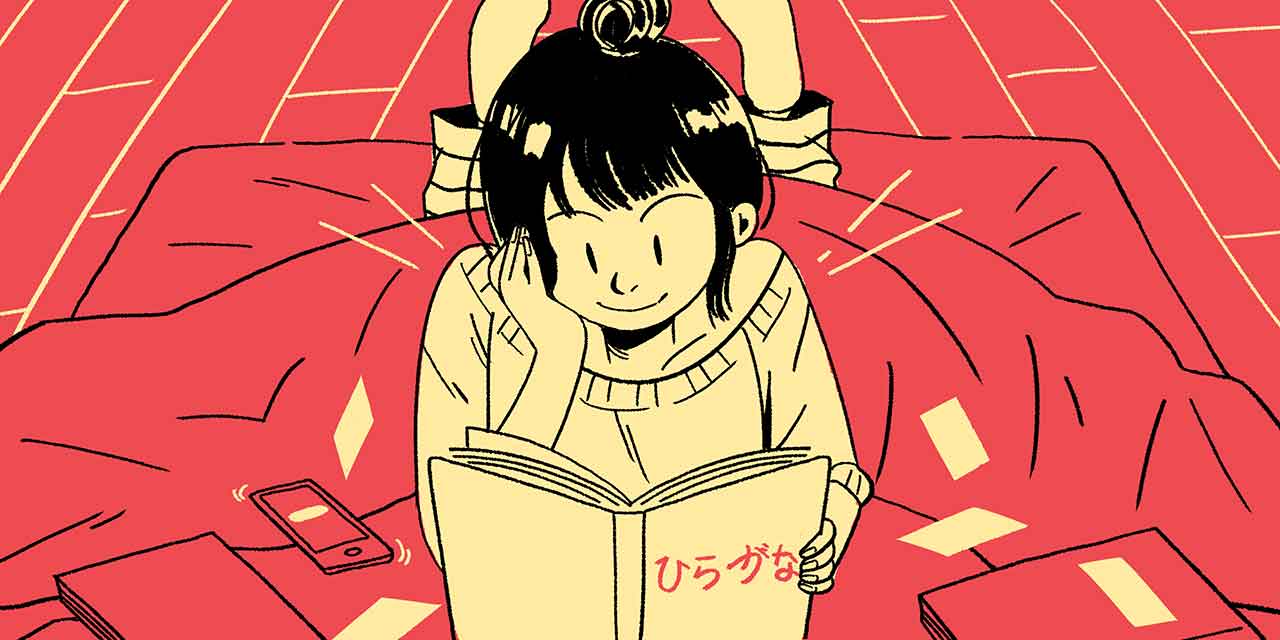
Hiragana is Japan's version of the alphabet. It is one of three Japanese writing systems you need to learn to be able to read. The other two are katakana and kanji, but hiragana is where everything starts.
The ability to read hiragana is going to be a prerequisite for most beginner Japanese textbooks and resources. It's the first thing you learn in a traditional classroom. Surprisingly, I agree with everyone else. This is a good place to start.
Most Japanese classrooms spend an entire month learning how to read and write hiragana. That's too long! Instead of writing out each hiragana character over and over to memorize them, use the guide below and you may be reading hiragana later tonight. It uses mnemonics and worksheets that are designed to help you learn and be able to recall hiragana faster than you thought possible.
Do it: Learn How to Read Hiragana
It's important to note that this guide is going to teach you how to read hiragana and not how to write it. This has a purpose! While it is important to learn how to hand write Japanese eventually, right now it will slow you down immensely with very little payoff. Typing covers 99% of modern day writing so you will learn how to type hiragana (and katakana and kanji) instead.
This, in combination with mnemonics and worksheets, will allow you to learn how to read hiragana in a day or two instead of a month.
Remember: You're not in a class. You don't have to move at the speed of the slowest 10%. There is no speed limit .
In order to complete this section and move on, you need to get to the point where you can read all of the hiragana. Even if you're slow, as long as you can recall each character, as well as the contractions, without cheating, that's enough. You're about to get plenty of practice and your reading speed will naturally increase over time as you move on.
Note: Read "Japanese Pronunciation, Part 1" (below) before you start learning hiragana.
Estimated Time: n/a

Good pronunciation starts with hiragana. While hiragana alone won't teach you everything, it is the key to understanding how and why Japanese words sound the way they do. It will also help you get the foundation you need for a native-sounding accent. At the very least, hiragana will get you 80% of the way there.
For the remaining 20%, we wrote a guide covering the basics of Japanese pronunciation. Before you begin learning how to read hiragana, you should read up to the "Japanese Sounds and Your Mouth" section.
Once you've finished learning how to read hiragana, go though that section again, but this time read about "Important Differences" as well. This section will cover all of the sounds that don't exist in English, giving you a head start. Make sure you can pronounce all of the hiragana characters correctly before moving on.
Read: Basic Japanese Pronunciation Guide
With pronunciation, it's best to put the time and work in now, at the beginning. Don't ignore it because it's hard. When things get more difficult, it's very important that you've spent time speaking and hearing these sounds so that you can learn about all the differences and exceptions headed your way.
Okay, now go ahead and get back to learning how to read hiragana . Get to the point where you can read and recall everything, then move on to the next section.
Estimated Time: 1-2 days (or less) Prerequisite: Able to read hiragana
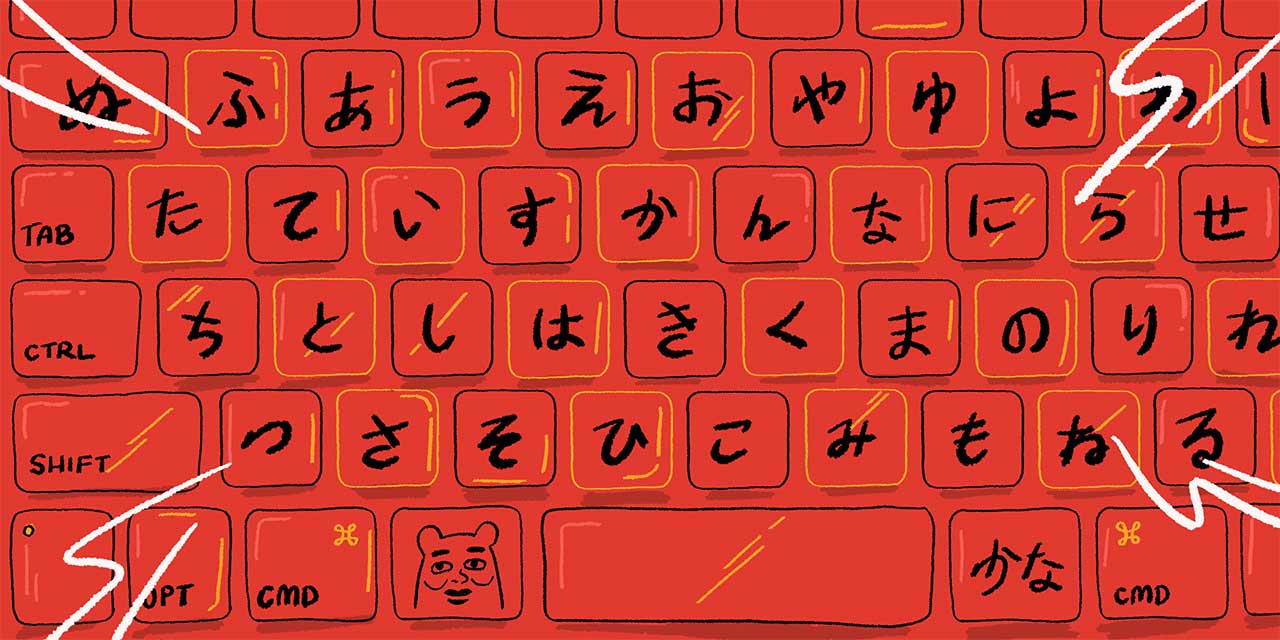
Now that you can read and pronounce hiragana (remember, slowly is okay!) it's time to learn how to type it on your computer or smartphone.
First, you need to install a Japanese keyboard. Luckily, you don't have to buy a special piece of hardware or computer to do this thanks to a type of software called an IME (input method editor). You can add an IME onto almost any kind of computer, phone, or operating system. Just follow the instructions in this guide to add them to your devices:
Read: How to Install a Japanese Keyboard
After you’re done installing, it’s time to learn how to actually type. Use the following guide, and only focus on the hiragana portion (since that’s all you know how to read right now):
Read: How to Type in Japanese
Assuming you are able to read hiragana, typing in hiragana is surprisingly straightforward. Once you feel confident in your typing abilities, including trickier things like contractions, small tsu, and dakuten, move on to the next section. It's time to talk about the elephant in every Japanese learner's room: kanji.
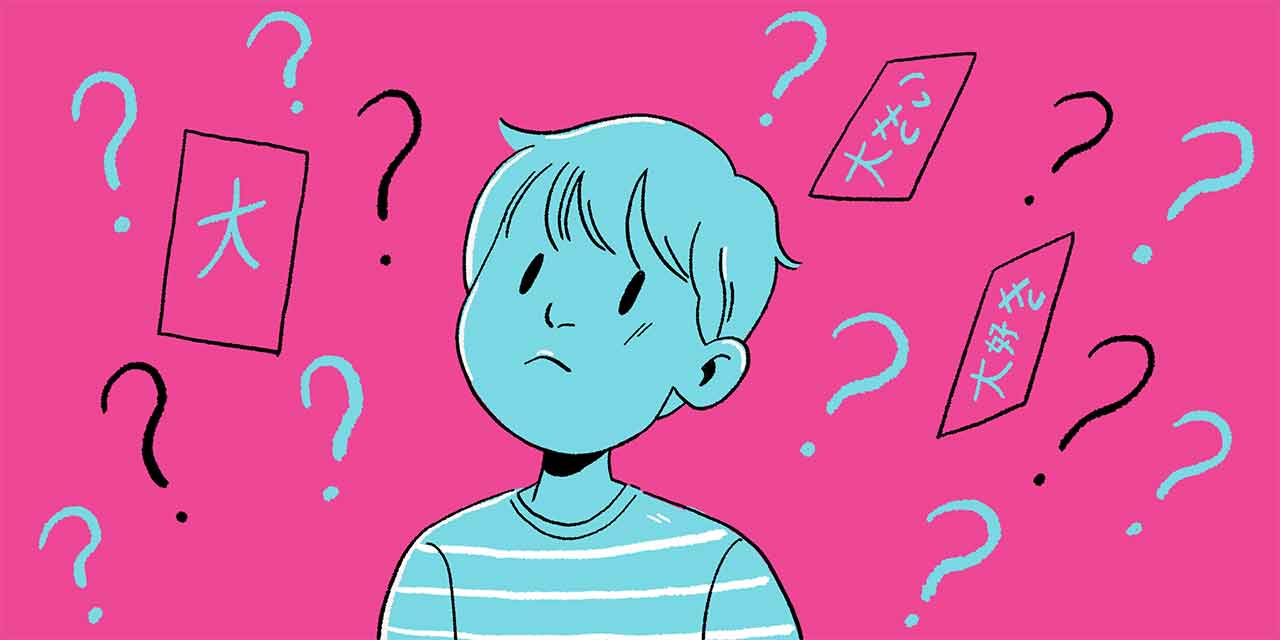
In our Japanese learning method, you're going to learn to read kanji characters very early. As soon as you can read and type hiragana it's time to start tackling kanji.
Here is our reasoning:
The most difficult thing about learning Japanese is kanji. At least, that's what people say. But trying to save it or brush it off until later isn't going to help you learn Japanese. Almost everything uses kanji, making it one of the most important aspects of learning this language. Your learning quality of life will drop drastically if you choose to ignore it.
A lot of a beginner’s time when using a textbook is spent looking up kanji and vocabulary. This takes your focus away from the grammar you're trying to learn and makes progression slow and frustrating. Learning (some) kanji and vocabulary first makes learning grammar a lot faster and, more importantly, easier. Think of it this way: you're losing a little time now to save a ton of time later.
Kanji leads to vocabulary, vocabulary aids communication, and grammar is like the glue that holds vocabulary together. Without vocabulary there's nothing for the grammar glue to stick to and everything gets messy. It makes grammar abstract and difficult to learn, when it doesn't have to be.
Like hiragana, we have a way for you to learn kanji that's way more effective than the traditional methodology (rote memorization). Thanks to that, it won't be as difficult as everyone says. It may even *gasp* be a pleasure to learn! Maybe.
This kanji-vocabulary-first route will get you to the point where you can use Japanese quickly. It feels slow at first, but soon you will rocket past your fellow Japanese learning compatriots. You'll also be able to get over that "intermediate wall" easier and quicker than if you were to use a traditional method. This lowers your chances of burnout and giving up all together.
If you're on board with this philosophy, you need to start at the very beginning: understanding what kanji is and how it's used. For that, we have another guide for you to read:
Read: On’yomi vs. Kun’yomi: What’s the Difference?
Once you understand how Japanese kanji readings work, you’ll be ready to learn some actual kanji.
Estimated Time: 1-3 months

Important note about this section: You should start to learn katakana (the next section) at the same time as this step. "Beginning Kanji & Stockpiling Kanji Knowledge" will take 1-3 months. In fact, you can complete all of the steps up to "The Beginner of Japanese" while you work on this one!
Okay, so it's time to actually learn kanji. Let's define what "learn kanji" means before you get started. That way you know what is expected of you.
When I say "learn kanji" I mean learn the kanji’s most important (English) meaning(s), and their most important (Japanese) reading(s). As you know from reading about on'yomi and kun'yomi, some kanji have a lot of readings. And, unfortunately, English meanings are just translations and can't always match the Japanese meaning one-to-one. That means there can be many correct English meanings for a single kanji that you'll need to deal with. We'll narrow those down so you only learn the most important meanings and readings first—the ones used 80-90% of the time. The remaining meanings and readings will come via vocabulary and other practice.
As you learn kanji you will also learn vocabulary that use those kanji. Not only will this help solidify those kanji concepts in your mind, but it will also be where you learn the remaining kanji readings. Plus, as you know, this vocabulary will be used to give you something to glue together with grammar later.
By the end of this guide, your goal is to know around 2,000 of the most important kanji as well as 6-7000 vocabulary words that use them. With this groundwork you should be able to read almost anything—or at least have the tools to easily decipher the rest on your own.
Your goal should be to learn 20-30 kanji and ~100 vocabulary words that use those kanji (and only those kanji) each week. If that seems like a lot, don't worry: there is a method for memorization that will speed things up considerably. Please read up on the Radicals Mnemonic Method. As a bonus, you will learn some important foundational knowledge about how kanji works in here as well.
Read: Learn kanji with the radicals mnemonic method
In this guide you will learn how to narrow down kanji meanings and readings to the most important ones. You will learn how to use radicals and mnemonics and how to create an effective routine.
You should be able to use these techniques to create a weekly study plan on your own for free, as long as you put in the work. But, if you would like all of the above (and then some) in one, complete package, we recommend the kanji learning program, WaniKani .
We'll be referencing it going forward, but just know that creating your own content and schedule is totally fine and doable. You'll just need to make sure you maintain your pace to keep up. Or, for some of you, make sure you slow down so you don't burn out!
Once you begin learning vocabulary in WaniKani (or your own system) read the Basic Japanese Pronunciation Guide from the Pronouncing Vocabulary section all the way through to the end. You will learn about long and short vowel sounds, double consonants, dropping sounds (all common stumbling blocks for beginners), and more. You will also learn about pitch accent. Although it may be difficult now, just knowing pitch accent exists and how it works in Japanese will give you a leg up.
Okay! Make sure you get started now. Do the work, don't just plan to do it! Sitting down and starting is the hardest part.
Estimated Time: 2 days to 2 weeks Prerequisite: Able to read hiragana

Learning katakana is about the same as learning hiragana, with a few Shyamalanian twists. We have yet another mnemonic-based guide for you, and chances are you'll be able to read katakana within the next few days if you're willing to put in the work.
You should get to the point where you can read all of the katakana, however slowly, by the time you start unlocking vocabulary in WaniKani (or by the time you start vocabulary in your own kanji method). Although katakana words won't show up a lot right from the start, there are enough to make it worthwhile. It's also a good way to spend your extra time while the number of kanji you're learning is still quite low.
Do it: Learn to Read Katakana
Note: Katakana tends to give learners more trouble than hiragana. This is because it seems to be used less than hiragana and kanji, especially at the beginning stages. Later on, katakana will appear more frequently, but for now simply being able to read katakana is enough. There will be plenty of opportunities to get better at it—just know that reading katakana may not come as quickly as it did with hiragana. And that's okay. Hiragana and kanji are just more useful right now, so spend your limited time and energy there.
Once you can read each katakana character—no matter how slowly—move on to the next section about typing katakana.
Estimated Time: 1-2 hours Prerequisites: Able to type hiragana, able to read katakana
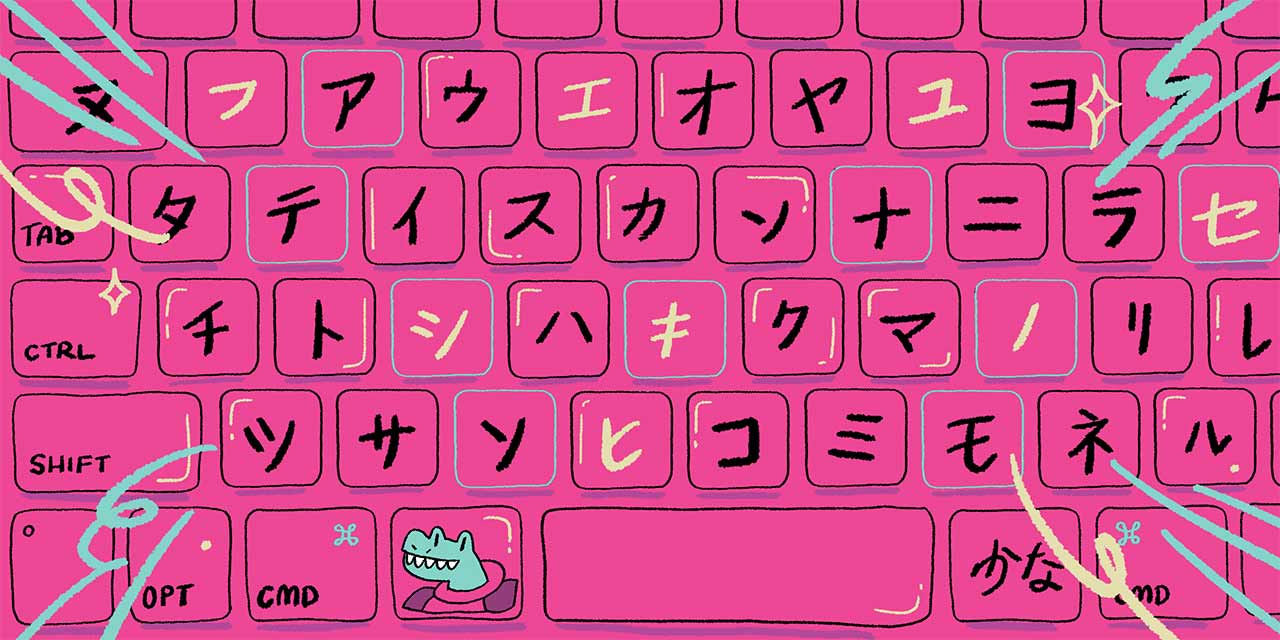
Katakana is similar to hiragana in many ways, and thanks to this, learning how to type it should be fairly easy. There are a few differences to figure out, but you will be able to apply your hiragana knowledge to it and progress quickly. Jump to the katakana section of our typing guide and get started.
Read: How to Type Katakana
Note: Make sure you keep working on your kanji! If you’re using WaniKani, just do your reviews as they become available. It's important to make this a habit. Because WaniKani is a spaced repetition system there must be spaces between reviews. Longer and longer ones, in fact (though it will depend on how well you're doing). Do your reviews on time and you’ll get through this initial "slow" phase in a week or two. That's a drop in the bucket compared to your entire Japanese-learning career, so try to be patient. The waiting time is critical to testing your ability to recall information.
Estimated Time: 1-2 hours Prerequisite: Able to read 20-30 kanji

Before starting this step, make sure you can read a handful of kanji. Twenty or thirty will do just fine. If you're using WaniKani, this is when you start unlocking vocabulary or are around level 2.
Okay, are you done?
Typing in kanji is a little more complicated than typing in hiragana or katakana, but it still follows similar rules. Learn how to type in kanji using the kanji section of our guide then read to the end. There are some additional tips and tricks in there (punctuation, symbols, etc.) that may come in handy.
Read: How to type kanji
Now you know how to type everything there is to type in Japanese (that is, unless you count kaomoji )! If you can type in English, typing in Japanese is surprisingly easy. With practice, you'll be able to type it as naturally as you type in your native language.
To continue using this typing knowledge, you'll need to know more kanji and vocabulary. Once you get there though, you'll be ready for "The Beginner of Japanese" section!
Before moving on, you should reach level 10 on WaniKani (or around 300 kanji and 1,000 vocabulary words using your own method).
This is an important time in terms of pronunciation too. Make sure you consciously mimic the vocabulary audio. Think about pitch accent as you do it. This work will prepare you for sentences later.
With this kanji knowledge (and good pronunciation, to boot!), grammar is going to come quickly to you. You won't be spending your grammar study time looking up every other word. Instead, you'll be able to focus solely on grammar, and you'll know the contents of 80% of every sentence you see for the first time. When you say these sentences out loud, you won't be tripping over your tongue because you'll already be intimately familiar with Japanese sounds and pronunciation. The time you put into kanji, vocabulary, and pronunciation will begin to pay off.
Put your head down, trust in this, and do the work each day.
Go on, get to it, and come back here when you're done.
The Beginner of Japanese
Being a beginner of anything is great. Everything is new, everything feels like real, tangible progress, and even if you're bad at something, you can't really tell because you don't know enough yet anyway.
Enjoy it while it lasts.
At this point, you have a strong base of kanji and vocabulary. If you are using WaniKani , you should be at level 10 or above. If you are doing kanji on your own, or using another resource, you should know the most common meaning and reading of around 300 kanji and 1,000 vocabulary words. If you are using a resource that only teaches you the meaning of a kanji (and not how to read it), that doesn't count . You need to be able to do the whole thing, not just the easiest 20%.
With this assumption about your knowledge in place, we're going to go through some options for how you can learn Japanese grammar. This includes using a textbook as well as creating your own grammar program from scratch. We offer some of our own material as well. Most likely, you'll end up doing a hybrid of the above. No matter what you choose, your foundation of kanji, vocabulary, and pronunciation will make everything much easier. Without it, even the best Japanese textbook will be a frustrating experience.
Using a Spaced Repetition System For Vocabulary
Estimated Time: 2-4 hours + ongoing

You will learn a lot of vocabulary purely from your kanji studies. As long as you have a good kanji system in place, you shouldn't worry too much. However, you will definitely need to learn all of the words that do not use kanji too. In the beginning, this will largely be grammatical things, and words that don't use kanji, from your textbook. Later it will be vocabulary you pick up from signs, manga, and other real life sources.
It's time to learn how and when to introduce vocabulary words from outside your kanji studies into your study routine. The most important thing is to have a good system in place.
You need to be able to record and store these words so that you can study them later. You also need a good system to handle and process these words. It's a waste if you record them once and never look at them again.
At your currently level, most of the new words you encounter will probably be hiragana or katakana-only words. Once you start reading more and more Japanese, the number of new words you encounter will increase, so being able to keep track and add these to your routine becomes even more important. For now though, your goal is to develop a habit of collecting, processing, and studying vocabulary that is unfamiliar to you. This should become second nature.
Most likely, you will find most of the vocabulary that you want to learn in your Japanese textbook (we'll cover that really soon!). As I mentioned earlier, these might be words that don't have kanji, or maybe they're words that you didn't learn in WaniKani. There are a lot of words out there and no one resource will teach you all of them.
Once you've found some words that you want to learn you need to collect them. How you do this doesn't matter as much as actually doing it. Put them in a spreadsheet, a tool like Evernote or OneNote, or just write them down on a piece of paper. Make sure wherever you put these new words is easily accessible and make a trigger for yourself that essentially says " if I see a vocabulary word I want to learn, then I add it to my list."
There are plenty of list-apps and pieces of paper out there, so it's going to be difficult for me to say what you should use. I'm partial to Evernote and have my own processes built up there. And Airtable is a great spreadsheet app for people who don't think in math. But maybe you like physical pocket-sized notebooks, to-do lists, your smartphone camera (with a special folder for future processing), or something else.
Whatever you use, make sure it's easy for you . Figure out what makes sense and make it work. If this step doesn't happen, everything else will fall apart.
The next step is processing. I'd recommend you create a habit where every day, week, or month (it depends on how much new vocabulary you want to introduce to your routine) you go through this list and put them into your SRS of choice. What is an SRS? I'm glad you asked.
If you've been using WaniKani, you've been using a "Spaced Repetition System" (a.k.a. SRS) this whole time! But you'll want to use something else for the vocabulary you find out in the wild. For this, we wrote a guide. In it you'll learn how to collect vocabulary and add them to your SRS.
Read: Spaced Repetition and Japanese: The Definitive Guide
One additional piece of reading I'd recommend is this article on Keyword Mnemonics. For the non-kanji vocabulary you want to learn this is a surprisingly simple (and effective) mnemonic method which will allow you to learn more vocabulary in one sitting, and be able to recall it for longer.
Read: Keyword Mnemonic Method for Learning Japanese Vocabulary
As I said earlier, you won't be working with a ton of vocabulary at the start. For now, let your kanji studies give you most of your vocabulary. Then, when stray street vocabulary does start coming up, send it through the vocabulary process you've built.
Make this a habit.
Habit generally means 3-6 weeks of doing something regularly. And you should start now, because in six weeks you'll be needing to utilize this habit a lot more.
Estimated Time: It's a mystery

It’s (finally!) time to start learning grammar. If you followed this guide to the letter, you’re probably 2-4+ months into your Japanese studies. If it's more than that, don't worry about it. We all go at our own speeds and the important thing is that you kept moving forward. You should know around 300 kanji and 1,000 Japanese vocabulary words, and your pronunciation should be getting better, or at least you're being conscious about improving it. Now it’s time to kick Japanese grammar's butt.
Let's start by internalizing a philosophy. Carry this with you for the rest of your life:
When learning something new, you should already know 80% of it.
This means that each new thing you learn should be a 20% (or smaller) incremental step. A +1 from where you are, rather than a +20 or +100.
Most people go into a textbook with zero knowledge and wind up spending a large chunk of their time looking up words they don't know. How much of a sentence is vocabulary? Depending on the length, it's easy to answer "more than 80%."
So when you're learning grammar with a textbook, coming into it with prior vocabulary knowledge brings you to that 80%. Leaving you just the grammar, which you can then point your laser-like focus towards. Instead of constantly flipping to the index to look up a word or kanji and deal with context switching when you finally get back to the lesson, all you have to worry about is learning the grammar and nothing else.
That's the +1 we're talking about.
Let's assume for a moment that your Japanese vocabulary knowledge doesn't get you to 80% (or more). If that's the case, there are a few possible reasons:
You don't know enough vocabulary: If you don't know a lot of the words in a sentence before studying with it, then you don't understand 80% of the sentence before you start. In this case, go back to your kanji/vocabulary studies for a while and reconsider the level of the resource you're using. Another solution would be to pull the vocabulary from the resource, study them with your SRS method, and then come back once you've learned them.
You don't know enough grammar: Imagine you're looking at a sentence that contains three separate grammar points. If you're being taught one of the three, but you don't know the other two, you're dipping way below that ideal 80%.
The sentence is very short: If a phrase only has three parts (ex. "[vocabulary] + [particle] + [vocabulary]"), and you don't know one of them, you're going to be at 66%. In cases like this, you can make an exception. Knowing 66% of a three piece phrase, or 75% of a four piece phrase is acceptable. This will be very common in the beginning.
That's the philosophy we're working off of going forward, so double-check that you have that base of kanji and vocab before continuing with this guide. Your failure rate increases dramatically if this foundation is weak!
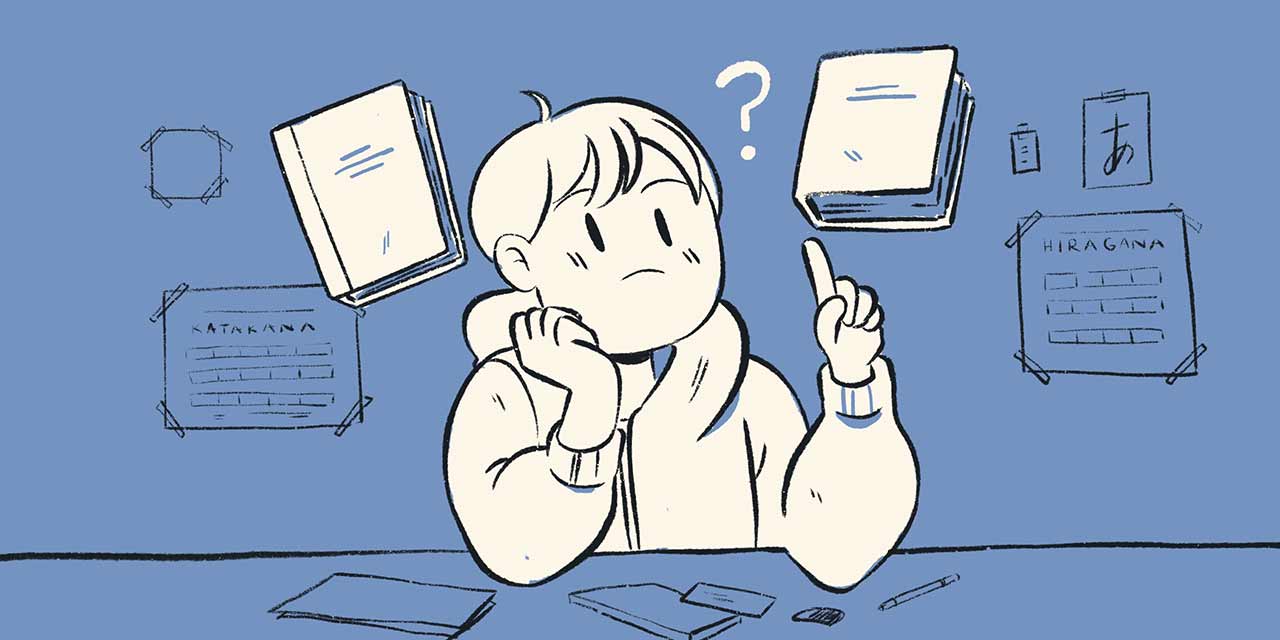
It's time to take our philosophy and apply it to a beginner textbook. All the things that would have normally tripped you up (the things teachers and textbooks have a tough time explaining, due to the curse of knowledge ) should now be less difficult to deal with. And with kanji and vocabulary already in your tool belt, learning grammar should be much more interesting. You won't be spending 90% of your time and energy on looking up kanji and vocabulary you don't know. Instead, you'll just be doing it.
With this base knowledge, choosing a specific textbook or program to follow becomes less important, but there are still many "good" textbooks and many "bad" textbooks out there. Most will teach you the same content one way or another, so pick one that you feel fits your learning style.
To help you with this choice, we wrote a guide:
Read: The Best Japanese Textbooks for Beginners
Whatever you end up choosing, get started right away. It's so easy for people to get trapped in a "preparation loop" where they spend all of their time planning and getting ready, only to stop before any actual work gets done.
At this point you will focus on working through your textbook of choice. Try to progress through the entire thing from beginning to end. Doing this will create a strong foundation of Japanese inside of you, something you can use to base other knowledge off of.
Once all of the basic, foundational grammar is in place you'll be able to really accelerate and work toward fluency.
It will take around 2-6 months to get through most beginner Japanese textbooks. Though, this does depend on how much time you have to spend on your studies and what grammar method you choose. You can even go through a couple different textbooks at the same time, if you want. What one textbook doesn't teach well, another probably does. That being said, if you don't feel like you understand a concept, or you want to know more, there's plenty of ways to get your questions answered. I recommend not skipping questions—instead, follow your curiosity! Learning is supposed to be fun, though school may have "taught" you otherwise.
Read the next section as you start your textbook studies. You'll eventually run into something you don't know that your textbook doesn't explain. You might as well be ready for it.

As you're going through your textbook, you're going to run into things you don't understand. Or, you'll find you don't know 80% anymore. It's not necessarily a failure of your textbook, it's just that many of them were designed for teachers to use in a classroom. They expect someone to be there to answer questions for you. Or, there just isn't enough paper in the world to cover everything.
Not to worry. When you run into something you don't understand you can look it up. No matter what kind of question you're asking or answer you're searching for, we wrote up a guide that will tell you how to find anything Japanese language related:
Read: How to Answer your Japanese Language Questions
Note: You should continue to use WaniKani (or whatever kanji learning method you chose) as you continue on. You should keep going until you finish, and/or you reach the end of this guide. It is important to keep your kanji-vocabulary knowledge ahead of your grammar knowledge at all times. If you don't, that 80% ratio will tick down until your studies no longer feel sustainable or fun.
Alternative: Learning Japanese Grammar On Your Own

By gathering all that kanji and vocabulary knowledge you’re making it possible to learn grammar on your own. Learning grammar is easy comparatively. That being said, if you decide not to use a Japanese textbook as your main resource, there are some things you'll want to consider:
This is a topic we'll be writing a big guide on. But, it's quite complicated so I haven't gotten around to it yet. We'll fill in this section with that guide in the near future, but for now don't use my slowness as an excuse. Just get started. If you do, ordering will, for the most part, naturally fall into place if you follow the "know 80% of all new things" philosophy.
Don't just trust any ol' thing you read on the internet. The same goes for textbooks and teachers, too. When you learn a new piece of Japanese grammar, make sure to read explanations from multiple sources. Some will be complicated with hard linguistic language while others will be overly simplified. And a few here and there will be just right! Making a habit out of using multiple explanations and resources for one thing will feel like it's slowing you down at first, but it's much faster overall. We'll list some really good reference books at the end of the Beginning Japanese section, so make sure to take a look.
If you're studying Japanese grammar on your own, it's even more important to do the work . It's not hard to study and use what you've learned. It's hard to sit down and start . Even more so than a class or textbook, you'll need to make sure you actually sit down and make progress. Measurable progress, preferably, though you'll have to figure out just how to measure it.
With a textbook, you can just say, "I could answer all the questions," or, "I made it through twelve pages this week." Doing grammar on your own makes it harder to see and feel yourself moving forward. You are, but it's a bit hidden.
If this is happening a lot—and no amount of research gets you through it—you might want to consider finding a professional to help. Speaking of professionals…

This may be the time to consider finding a Japanese language tutor, especially if you feel like you're not able to answer your questions about Japanese on your own. With a foundation of kanji and vocabulary already in place, you will be able to focus on the things that a tutor can help you with the most: speaking, listening, and answering questions.
Keep in mind that focusing on kanji and vocabulary with a tutor tends to be a poor use of this time. Most teachers don't have any idea how to teach kanji (it's just, "go learn these kanji and vocab by next week") and many tutors try to promote rote memorization because that's how they learned as a child.
When using a tutor it's important to focus on things only a tutor will be able to help you with. Those include their ability to speak, think, and explain nuances that haven't been written about or studied (yet).
You're not required to get a tutor or a teacher at this point, but if you were really looking forward to this part, now is the appropriate time to do it. Everything from here on out won't rely on your having access to a teacher, tutor, or native speaker, so you can still progress without needing to complete this step.

As you're moving along, there's always going to be more to learn. Don't be afraid to stop moving forward to indulge your curiosity. These "slowdowns" will speed you up as you strengthen past knowledge and make connections between them.
For times like this, reference books are quite good. If you're only going to buy one, I'd recommend the "Basic" book from the Dictionary of Japanese Grammar series . It is the best Japanese language reference book out there, in my opinion.
Other than that, look through the "Reference Books" section of our Beginner Japanese Textbooks, Reference Books, and Dictionaries article. There are quite a few good ones!
Read: The Best Japanese Reference Books & Dictionaries
Note: With any skill, it's important that you focus on the things you're worst at. "Raise the floor, not the ceiling," so to speak. If you do that, you'll find everything else gets elevated, and you'll be less frustrated overall. You'll have more data to reference in your brain as more unknown ideas and concepts pop up. For example, if you're bad at verbs, pick up The Handbook of Japanese Verbs and just read through it. It might take you an afternoon, but every verb you see from that day on won't be a detriment to your progress. Instead, it will positively affect all other aspects of your Japanese.
Raise the floor, because no matter how high your ceiling, you'll still be down on the ground.
The "intermediate" level of Japanese is by far the worst. Most of the people who ultimately give up on learning do it here (assuming they made it past the first few weeks).
Available resources begin to dry up, in both number and quality, and learners get stuck or plateau. Without guidance, it can feel like progressing is an impossible task.
This is the intermediate wall.
The thing that makes the intermediate level the hardest, though, is what got you here: your competence.
The beginner section was your unconscious incompetence stage. That is, you didn't realize you were incompetent, so you never felt discouraged, overly embarrassed, or stupid. But now you know a thing or two, and it's just enough to know you're not actually amazing at this thing called the Japanese language. It hurts and it's because you are now consciously incompetent, which is no fun at all.
Thankfully, a lot of the pain most learners feel at this stage comes from poor learning or teaching methods from the beginner stages. Things that you, hopefully, avoided. And although everyone will experience conscious incompetence to some degree, some people can get through it quickly and some get trapped here for years. Most, unfortunately, can't make it through at all and give up.
Be the type of person that gets through this stage quickly.
The other side of this wall is extremely fun and rewarding, so don't give up and don't let your conscious incompetence get you down.
Here's how you do it:
Recognize this stage exists and know that you're supposed to feel these uncomfortable feelings. This helps a surprising amount. You don't have to feel dumb because you know that everyone goes through this exact same situation. It's all a part of the process and if other people made it out, you can too.
You've already been preparing for this moment. This guide has prepped you to get through this fairly quickly. You're at an advantage! Most people wallow in the conscious incompetence stage for a long time because they lack two things: kanji and vocabulary. But by this point, you know more kanji and vocabulary than any intermediate level Japanese language student ought to. This is why you spent so much time on WaniKani (or one of its alternatives). It slows you down in the beginning so that you can blast through this wall.
With all that in mind, it’s time to start on some intermediate material. Make sure you are good on 100% of the previous sections before moving on. This is, by far, the most difficult portion of your Japanese education. You must have a good foundation to jump off of. When you're ready, you can start browsing our Japanese articles and Grammar pages . Good luck! 💪🏻
- Skip to primary navigation
- Skip to main content
- Skip to primary sidebar
- Skip to footer
StoryLearning
Learn A Language Through Stories
83 Must-Know Japanese Travel Phrases For Your Next Trip To Japan
If you're learning Japanese and considering a trip to Japan, you'll probably want to learn some Japanese travel phrases so you can make the most of your trip.
Getting a feel for which expressions will be most important to you can vary depending upon your specific interests and goals while traveling. But some vocab is particularly useful no matter what.
If you spend time learning any basic Japanese phrases and words, start with these 83 Japanese travel phrases so that you can head into Japan on the right foot!
Regardless of where you are or what you’re doing, two of the most important words you’ll need to know are arigatou gozaimasu and sumimasen .
Arigatou (gozaimasu ) means “thank you,” and it’s very polite; you can use it with anyone. Sumimasen means “excuse me” (when trying to get someone’s attention) or “I’m sorry” (if you’ve inconvenienced someone, such as by misunderstanding or taking up time).
Let's discover the other Japanese travel phrases that will be a must on your next trip to Japan.
By the way, if you want to learn Japanese fast and have fun while doing it, my top recommendation is Japanese Uncovered which teaches you through StoryLearning®.
With Japanese Uncovered you’ll use my unique StoryLearning® method to learn Japanese naturally through story… not rules. It’s as fun as it is effective.
If you’re ready to get started, click here for a 7-day FREE trial.
At The Airport
So you have arrived in Japan, and you’re in the airport. Depending on how your travels went and what you’re planning on doing next, you might have multiple places you need to visit.
To start, review your vocab and see if any of these locations apply to you for your next stop:
#1 currency exchange ( ryougaejo 両替所) #2 toilet ( toire トイレ) #3 customs ( zeikan 税関) #4 immigration ( nyuukoku shinsa 入国審査) #5 information ( desksougou annaijo 総合案内所) #6 souvenir shop ( omiyageya お土産屋) #7 Seat ( seki 席) #8 Train ( densha 電車) #9 Taxi ( takushi タクシー)
These are the most likely places you’ll need to stop next once you arrive. If you need to locate a certain establishment or find where to go, you can always ask someone:
#10 Where is the ______? (____ ha doko desu ka? __はどこですか。)
After you conclude your business wandering around the airport, you’ll probably be heading out into the city. In order to do that, you’ll most likely need to take a train out of the airport. If you feel confident using the airport’s self-service ticket machines, you can buy your own ticket.
However, if you have a JR Pass or need to use special train services, or if you don’t know how to use the machines, you can approach the manned ticket counter and ask:
#11 Can I have a ticket to _______ please? (____ made no chiketto wo kudasai. __までのチケットをください。)
If you are concerned that you may have to change trains during the process, you can ask about this too by saying:
#12 Is there a transfer? ( Norikae ha arimasu ka? 乗り換えはありますか。)
Taking A Taxi
Taxis in Japan are much more economical options than people give them credit for, so if you’re overwhelmed about navigating by yourself, a taxi can be a great option. The vocabulary for taking a taxi is simple, and drivers typically go above and beyond to help you.
#13 Taxi ( takushi タクシー)
When you have located the taxis, you will see that they typically drive up in a line. Wait your turn, and when one drives up, approach. Remember: do not open or close the taxi doors yourself; the driver has an automated button to do this for you.
#14 I’d like to go to _____, please. (____ made onegaishimasu __までお願いします) #15 How much does it cost? ( Ikura desu ka? いくらですか。)
One important thing to remember is that Japan is a very cash-centric society . The use of credit cards is much rarer than you may be used to, so you should plan to carry larger than normal amounts of cash with you in general. This also means that you should be prepared to ask your taxi driver if he or she accepts credit cards at all.
#16 Is paying by credit card okay? ( Kurejitto kaado de ii desu ka? クレジットカードでいいですか。)
Checking Into Your Hotel
So you have taken a taxi or train, and you’ve arrived at your hotel. Hotels have a wide array of commodities that you can take advantage of, which means that you’ll also get to use a lot of unique vocabulary.
Check out some of the words you’re most likely to use:
#17 Key ( kagi 鍵) #18 Front desk ( chouba (but furonto desuku is more common) 帳場 (フロントデスク)) #19 Lobby ( robii ロビー) #20 Dining room ( shokudou 食堂) #21 Hall ( rouka 廊下) #22 Towel ( taoru タオル) #23 Soap ( sekken 石鹸) #24 Toothbrush ( ha-burashi 歯ブラシ) #25 Toothpaste ( ha-migaki 歯磨き) #26 Razor ( kamisori かみそり) #27 Television ( terebi テレビ) #28 Housekeeping ( kaji-gakari かじがかり) #29 Laundry ( sentaku 選択)
If you are looking to do laundry at a hotel, be aware that Japanese dryers are not as powerful as most countries’, so you may need to run the dryer multiple times or simply hang your clothes to dry.
When you are ready to check in, you can approach the front desk. Depending on what you need to do next, you can use phrases such as:
#30 I’d like to check in. ( Chekku in wo onegaishimasu .チェックインをお願いします。) #31 My name is _______. ( Namae wa _____desu .名前あ___です。) #32 I’d like to make a reservation. ( Yoyaku wo shitai desu .予約をしたいです。) #33 Is there wifi? ( Wi-Fi ga arimasu ka? WIFIがありますか。) #34 What time is checkout? ( Chekku auto wa nanji desu ka? チェックアウトは何時ですか。`) #35 Can you hold my luggage for me? ( Nimotsu wo koko ni oite itte mo ii desu ka? 荷物はここに置いていってもいいですか。)
Japanese Greetings
Now that you have settled into Japan a little bit, you’ll probably enjoy going for a walk to see the sights. As you interact with other people, the phrases you’re most likely to hear them say are:
#36 Ohayou/konnichiwa/konbanwa
These are the “daily” greetings that mean “hello.” Ohayou (good morning) is typically used until about 11:30 or noon, then people switch to konnichiwa (good afternoon). At about 5pm, most people will switch to konbanwa (good evening).
#37 Itterasshai/Okaeri
When you leave and return for the day, you may be greeted with unique phrases. Itterasshai means “have a safe trip” or simply “goodbye for the day,” said as you leave. Your hotel staff may say this to you. They may also greet you with okaeri (welcome back) when you return.
#38 Irasshaimase
Whenever you enter a business, you’ll likely be greeted with irasshaimase , a very formal welcome. You are not expected to say anything in response; it’s sort of like the staff saying hello while also thanking you for shopping or visiting.
Buying Coffee
If you can’t go a day without your morning brew, take heart—Japanese coffee shops are everywhere, and the vocabulary is actually almost identical to what you may be used to ordering.
#39 Coffee shop ( kissaten 喫茶店) #40 Hot coffee ( hotto kohi ホットコーヒー) #41 Iced coffee ( aisu kohi アイスコーヒー) #42 Cafe latte ( kafe rate カフェラテ) #43 Drip coffee ( dorippu kohi ドリップコーヒー) #44 Soy milk ( soi miruku ソイミルク)) #45 Espresso ( Esupuresso エスプレッソ)
When it comes time to order your drink, you can specify what you want via the following format:
#46 I’d like to order [number] of [item]. ([item] wo [number] onegaishimasu .[item] を [number]お願いします。)
The [item] can be kohi, mizu (water), or any other item you would like to order. If you don’t know how to say what you want to order, you can point to a menu and simply say “kore” (this) in the [item] place. You can fill the [number] slot with the quantity you would like; the words hitotsu, futatsu , and mitsu mean one, two, and three, respectively.
For example:
- I’d like one hot coffee, please. ( Hotto kohi wo hitotsu onegaishimasu. )
After this, the waitress may ask what size you would like. You can typically choose from small (S), medium (M), and large (L).
Use the letter to indicate which size you would like:
#47 Size ( saizu サイズ) #48 Medium M ( saizuM サイズ)
In A Japanese Restaurant
If you’ve decided to stop by a Japanese restaurant instead of a café, you might need a wider variety of words to make sure you can get by.
The good news is that many restaurants—especially in large cities—have pictures on their menus, and no one will be upset if you point and simply say “this, please.”
To start, the vocabulary you’re most likely to need include:
#49 Fish ( sakana 魚) #50 Meat ( niku 肉) #51 Vegetables ( yasai 野菜) #52 Vegetarian ( begitarian ベジタリアン) #53 Beer ( biiru ビール) #54 Water ( mizu 水) #55 Tea ( ocha お茶)
As you enter a restaurant, you will likely be asked how many people are in your party. Using basic Japanese numbers 1-10, you can create the following sentence:
#56 There are [number] people. ([number] mei desu .___名です)
Once you have been seated, you may need to use some of the following phrases:
#57 Do you have an English menu? ( Eigo no menyu arimasu ka? 英語のメニューありますか。) #58 What is this [while pointing]? ( Kore ha nan desu ka? これは何ですか。)
When you have decided what you would like to order, you can simply state:
#59 [item] please. (____ onegaishimasu .__お願いします。)
If you do not know the name of the item and would like to order just by pointing at the menu, you can use:
#60 I’d like to order [number] of [item]. ([item] wo [number] onegaishimasu .[item] を [number]お願いします。)
When your meal is over, your next step is to pay. Important phrases that can get you through this phase of the interaction include:
#61 Could we have the bill, please? ( Okaikei kudasai. お会計ください。) #62 Can I pay with a credit card? ( Kurejitto kaado de daijoubu desu ka? クレジットカードで大丈夫ですか。)
In A Convenience Store
If you don’t feel like stopping by a restaurant, or if you’d just like a quick bite to eat or other item, the thousands of convenience stores (called konbini , short for konbiniensu sutoa , “convenience store”) that appear on nearly every street corner are ready to serve you.
The easiest meals in terms of simplicity will be bento boxes, or small boxes (in the cold section) that serve as a whole meal. If you pick one of those up and stand in line, you will almost always hear the following three phrases (to which you can answer yes or no, which keeps things simple):
#63 Next in line, please! ( Otsugi no kata douzo! お次の方どうぞ。) #64 Do you have a point card [a rewards card for the convenience store]? ( Pointo ka-do ha omochi desu ka? ポイントカードはお持ちですか。) #65 Would you like your bento warmed up? ( Obento atatamemasu ka? お弁当温めますか。)
Getting Directions And Getting Lost
Almost inevitably, you’ll find yourself turned around once you start exploring. That’s not such a bad thing! Japan is full of small, tucked away secrets, and the people are eager to help you get back to a familiar place much more often than not.
If you need to ask directions, the phrases that will serve you best are:
#66 Where is [place]?( ____ ha doko desu ka? __ はどこですか。) #67 Can I ask you for directions? ( Michi wo kiite mo ii desu ka? 道を聞いてもいいですか。) #68 Can you help me? ( Tasukete kudasaimasen ka? 助けてくださいませんか。)
In response, Japanese people are likely to use the following words:
#69 Next ( totonari となり) #70 In front of ( mae 前) #71 Behind ( ushiro 後ろ) #72 Nearby ( chikaku 近く) #73 North ( kita 北) #74 South ( minami 南) #75 East ( higashi 東) #76 West ( nishi 西) #77 Right ( migi 右) #78 Left ( hidari 左) #79 Street/road/path ( michi 道) #80 Bridge ( hashi 橋) #81 Corner ( kado 角)
Thanks to the consistent presence of trains and other forms of public transport, you should feel emboldened to explore as much as you like. There will always be a train station or bus nearby where you can ask directions or head back to a familiar place!
Japanese Travel Phrases
So there you have it – 83 Japanese travel phrases to hit the ground running on your next trip to Japan. From the airport to the convenience store and from the hotel to Japanese restaurants these knowing these Japanese travel phrases will help you feel less like a tourist.
And who knows, maybe getting started with these Japanese travel phrases will be your gateway into learning the language.
By the way, if you'd like to learn some more Japanese phrases before your trip, make sure you check out this post on basic conversational Japanese for your first chat with a native speaker. You might also like this list of Japanese conversation starters.
Language Courses
- Language Blog
- Testimonials
- Meet Our Team
- StoryLearning Reviews
- Media & Press
Which language are you learning?
What is your current level in [language]?
Perfect! You’ve now got access to my most effective [level] [language] tips…
Where shall I send them?
We will protect your data in accordance with our data policy.
Download this article as a FREE PDF ?
What is your current level in Latin?
Perfect! You’ve now got access to my most effective [level] Latin tips…
Where shall I send the tips and your PDF?
What is your current level in Norwegian?
Perfect! You’ve now got access to my most effective [level] Norwegian tips…
Download Your Free StoryLearning® Kit!
Discover the world famous story-based method that 1,023,037 people have used to learn a language quickly…, not interested.
What can we do better ? If I could make something to help you right now, w hat would it be?
Perfect! You’ve now got access to my most effective [level] [language] tips…
What is your current level in Swedish?
Perfect! You’ve now got access to my most effective [level] Swedish tips…
What is your current level in Danish?
Perfect! You’ve now got access to my most effective [level] Danish tips…
What can we do better? If I could make something to help you right now, w hat would it be?
What is your current level in [language] ?
Perfect! You’ve now got access to my most effective [level] [language] tips, PLUS your free StoryLearning Kit…
Download this article as a FREE PDF?
Great! Where shall I send my best online teaching tips and your PDF?
Download this article as a FREE PDF ?
What is your current level in Arabic?
Perfect! You’ve now got access to my most effective [level] Arabic tips…
FREE StoryLearning Kit!
Join my email newsletter and get FREE access to your StoryLearning Kit — discover how to learn languages through the power of story!
Download a FREE Story in Japanese!
Enter your email address below to get a FREE short story in Japanese and start learning Japanese quickly and naturally with my StoryLearning® method!
What is your current level in Japanese?
Perfect! You’ve now got access to the Japanese StoryLearning® Pack …
Where shall I send your download link?
Download Your FREE Natural Japanese Grammar Pack
Enter your email address below to get free access to my Natural Japanese Grammar Pack and learn to internalise Japanese grammar quickly and naturally through stories.
Perfect! You’ve now got access to the Natural Japanese Grammar Pack …
What is your current level in Portuguese?
Perfect! You’ve now got access to the Natural Portuguese Grammar Pack …
What is your current level in German?
Perfect! You’ve now got access to the Natural German Grammar Pack …
Train as an Online Language Teacher and Earn from Home
The next cohort of my Certificate of Online Language Teaching will open soon. Join the waiting list, and we’ll notify you as soon as enrolment is open!
Perfect! You’ve now got access to my most effective [level] Portuguese tips…
What is your current level in Turkish?
Perfect! You’ve now got access to my most effective [level] Turkish tips…
What is your current level in French?
Perfect! You’ve now got access to the French Vocab Power Pack …
What is your current level in Italian?
Perfect! You’ve now got access to the Italian Vocab Power Pack …
Perfect! You’ve now got access to the German Vocab Power Pack …
Perfect! You’ve now got access to the Japanese Vocab Power Pack …
Download Your FREE Japanese Vocab Power Pack
Enter your email address below to get free access to my Japanese Vocab Power Pack and learn essential Japanese words and phrases quickly and naturally. (ALL levels!)
Download Your FREE German Vocab Power Pack
Enter your email address below to get free access to my German Vocab Power Pack and learn essential German words and phrases quickly and naturally. (ALL levels!)
Download Your FREE Italian Vocab Power Pack
Enter your email address below to get free access to my Italian Vocab Power Pack and learn essential Italian words and phrases quickly and naturally. (ALL levels!)
Download Your FREE French Vocab Power Pack
Enter your email address below to get free access to my French Vocab Power Pack and learn essential French words and phrases quickly and naturally. (ALL levels!)
Perfect! You’ve now got access to the Portuguese StoryLearning® Pack …
What is your current level in Russian?
Perfect! You’ve now got access to the Natural Russian Grammar Pack …
Perfect! You’ve now got access to the Russian StoryLearning® Pack …
Perfect! You’ve now got access to the Italian StoryLearning® Pack …
Perfect! You’ve now got access to the Natural Italian Grammar Pack …
Perfect! You’ve now got access to the French StoryLearning® Pack …
Perfect! You’ve now got access to the Natural French Grammar Pack …
What is your current level in Spanish?
Perfect! You’ve now got access to the Spanish Vocab Power Pack …
Perfect! You’ve now got access to the Natural Spanish Grammar Pack …
Perfect! You’ve now got access to the Spanish StoryLearning® Pack …
Where shall I send them?
What is your current level in Korean?
Perfect! You’ve now got access to my most effective [level] Korean tips…
Perfect! You’ve now got access to my most effective [level] Russian tips…
Perfect! You’ve now got access to my most effective [level] Japanese tips…
What is your current level in Chinese?
Perfect! You’ve now got access to my most effective [level] Chinese tips…
Perfect! You’ve now got access to my most effective [level] Spanish tips…
Perfect! You’ve now got access to my most effective [level] Italian tips…
Perfect! You’ve now got access to my most effective [level] French tips…
Perfect! You’ve now got access to my most effective [level] German tips…
Download Your FREE Natural Portuguese Grammar Pack
Enter your email address below to get free access to my Natural Portuguese Grammar Pack and learn to internalise Portuguese grammar quickly and naturally through stories.
Download Your FREE Natural Russian Grammar Pack
Enter your email address below to get free access to my Natural Russian Grammar Pack and learn to internalise Russian grammar quickly and naturally through stories.
Download Your FREE Natural German Grammar Pack
Enter your email address below to get free access to my Natural German Grammar Pack and learn to internalise German grammar quickly and naturally through stories.
Download Your FREE Natural French Grammar Pack
Enter your email address below to get free access to my Natural French Grammar Pack and learn to internalise French grammar quickly and naturally through stories.
Download Your FREE Natural Italian Grammar Pack
Enter your email address below to get free access to my Natural Italian Grammar Pack and learn to internalise Italian grammar quickly and naturally through stories.
Download a FREE Story in Portuguese!
Enter your email address below to get a FREE short story in Brazilian Portuguese and start learning Portuguese quickly and naturally with my StoryLearning® method!
Download a FREE Story in Russian!
Enter your email address below to get a FREE short story in Russian and start learning Russian quickly and naturally with my StoryLearning® method!
Download a FREE Story in German!
Enter your email address below to get a FREE short story in German and start learning German quickly and naturally with my StoryLearning® method!
Perfect! You’ve now got access to the German StoryLearning® Pack …
Download a FREE Story in Italian!
Enter your email address below to get a FREE short story in Italian and start learning Italian quickly and naturally with my StoryLearning® method!
Download a FREE Story in French!
Enter your email address below to get a FREE short story in French and start learning French quickly and naturally with my StoryLearning® method!
Download a FREE Story in Spanish!
Enter your email address below to get a FREE short story in Spanish and start learning Spanish quickly and naturally with my StoryLearning® method!
FREE Download:
The rules of language learning.
Enter your email address below to get free access to my Rules of Language Learning and discover 25 “rules” to learn a new language quickly and naturally through stories.
Download Your FREE Spanish Vocab Power Pack
Enter your email address below to get free access to my Spanish Vocab Power Pack and learn essential Spanish words and phrases quickly and naturally. (ALL levels!)
Download Your FREE Natural Spanish Grammar Pack
Enter your email address below to get free access to my Natural Spanish Grammar Pack and learn to internalise Spanish grammar quickly and naturally through stories.
Free Step-By-Step Guide:
How to generate a full-time income from home with your English… even with ZERO previous teaching experience.
What is your current level in Thai?
Perfect! You’ve now got access to my most effective [level] Thai tips…
What is your current level in Cantonese?
Perfect! You’ve now got access to my most effective [level] Cantonese tips…
Steal My Method?
I’ve written some simple emails explaining the techniques I’ve used to learn 8 languages…
I want to be skipped!
I’m the lead capture, man!
Join 84,574 other language learners getting StoryLearning tips by email…
“After I started to use your ideas, I learn better, for longer, with more passion. Thanks for the life-change!” – Dallas Nesbit
Perfect! You’ve now got access to my most effective [level] [language] tips…
Find The Perfect Language Course For You!
Looking for world-class training material to help you make a breakthrough in your language learning?
Click ‘start now’ and complete this short survey to find the perfect course for you!
Do you like the idea of learning through story?
Do you want…?
Join the journey: Click here to get our top tips for affordable travel!

Japanese Phrases for Travelers (A Cheat Sheet)
When traveling through Japan, it is VERY helpful to have some Japanese phrases under your belt. On my visit there, I found that many people I encountered did not speak English, so I’m so glad that I took some time to a (little) bit of Japanese before my visit.
Keep reading for a list of the top Japanese phrases for travelers, as well as some general information on the language and tips on how to start learning on your own! Your trip to Kyoto , Tokyo , and beyond will be better because of it.
Table of Contents
The Top Resources for Learning Japanese
- iTalki : Practice with Live Teachers at a low cost
- LingoPie : Learn the language by watching videos in Japanese
- Writing Practice Book : Learn how to write in Japanese script
START LEARNING TODAY!
Japanese Language Overview
Language history.
The exact origins of Japanese are disputed by top linguists, as there is evidence that it could have originated from either the Polynesian, Chinese, or the Ural-Altaic languages. For a time, many scholars agreed that Japanese is part of the Ural-Altaic language family, which also includes Turkish, Korean, Manchu, and Mongolian. Japanese has been compared with Korean due to similarities in structure, use, and grammar, but the relation is still debated. Today, it the only major language whose origin is still unknown.
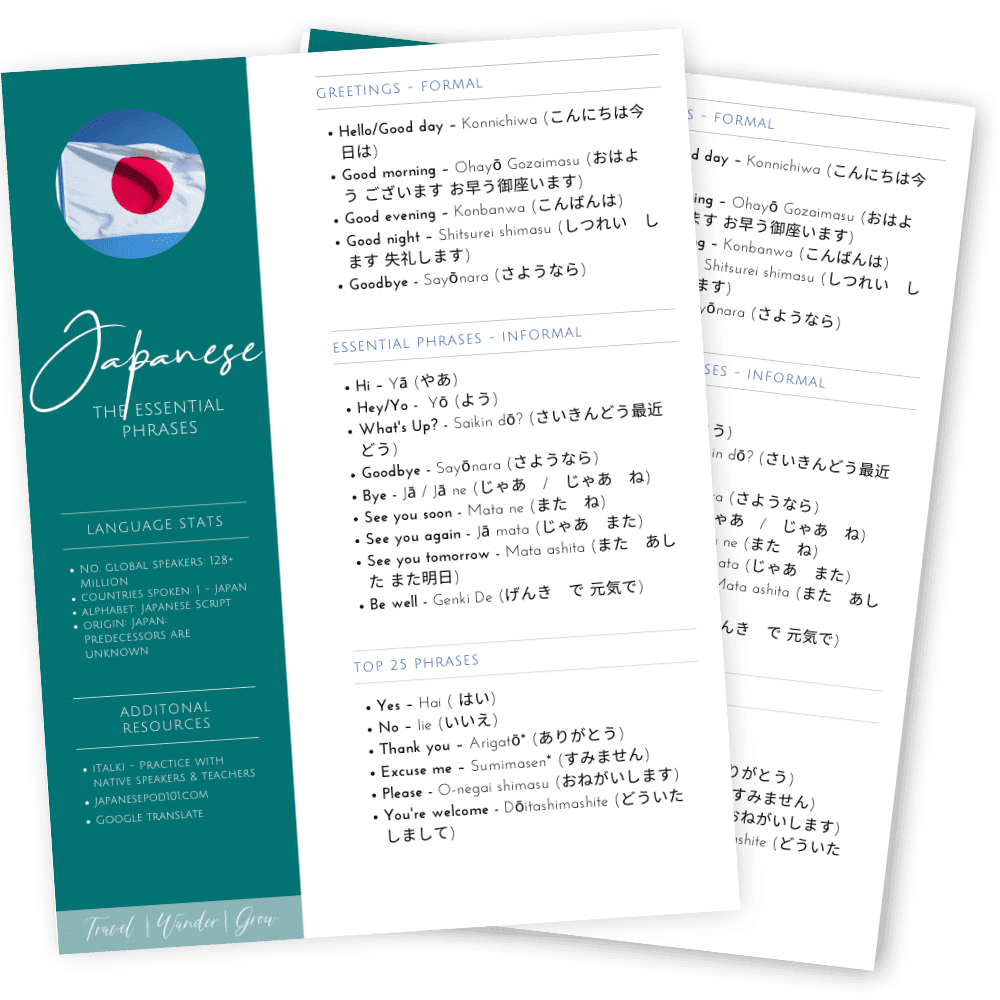
Get your free download!
Japanese phrases pdf.
This free download includes all the key Japanese phrases that you will need for your travels to Japan. In addition, get details on the best resources to improve your speaking and listening skills as well.
Japanese language history can be split into five main periods:
- Old Japanese (Prior to 8th Century)
- Late Old Japanese (9th – 11th Century)
- Middle Japanese (12th – 16th Century)
- Early Modern Japanese (17th-18th Century)
- Modern Japanese (19th Century – now)
Japanese has been a recognized language for the past 1200 years, from around the 8th century AD, where the earliest Japanese writings have been found. Some earlier evidence of the Japanese language has appeared in Chinese writings from as early as the 3rd century AD, but it is not known how long the language has existed on the island.
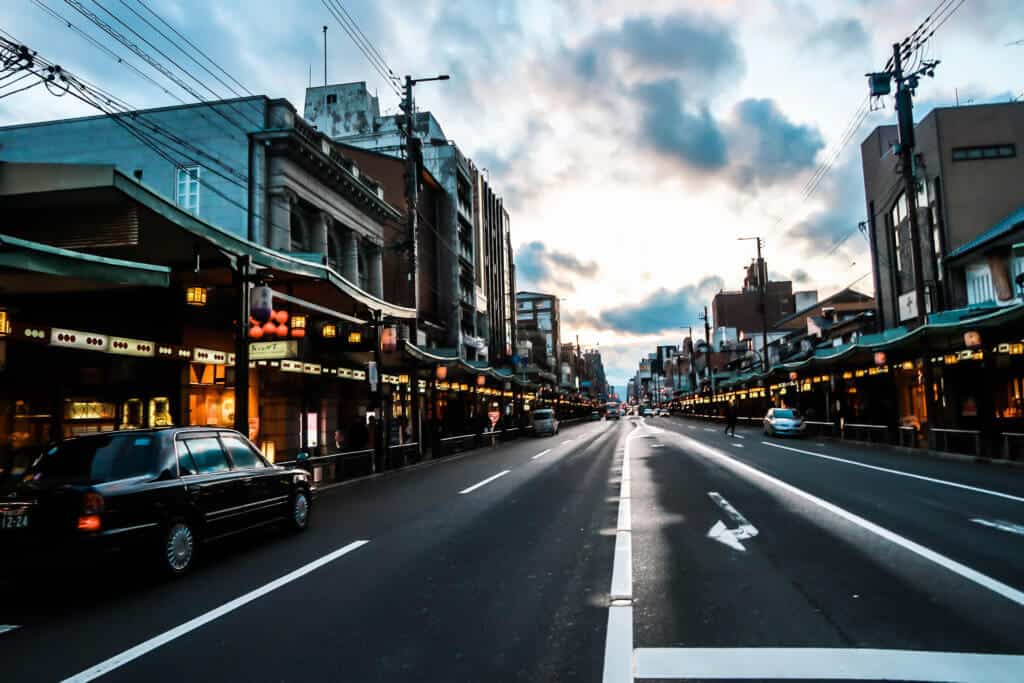
The Language Today
Today, Japanese is spoken by over 125 million people, most of whom reside in Japan. It is not the official language of Japan, but is the de facto national language of Japan. The standard form of the language is called hyojungo “standard Japanese or kyostugo “common language”. This is the variety of the language that is taught in schools and used in TV and official communications.
There are dozens of dialects spoken throughout Japan, as with many old languages. Some differences are more minor (e.g., changes to pronunciation or words used), while other dialects are so distinct from each other that they are mutually unintelligible. This is most often the case for dialects coming from peripheral regions, mountain villages, or isolated islands in the country.
I will also note, there are other languages spoken in Okinawa, as well as the Ryukyu and Amami Islands, known as the Ryukyuan languages. These languages are part of the Japonic language family, and some are considered endangered languages by UNESCO. Their decline is use is due to a shift in greater use of Standard Japanese and other dialects.
RELATED: Kyoto Travel Guide
Japanese Script
An interesting fact about Japanese that did not know until recently, is that Japanese has no genetic relationship to Chinese. Which was surprising to me because the language does use mostly Chinese characters in its written script. There have been two methods of using Chinese script – the first by using them as characters to represent an object or idea. The second method involves using the script to pronounce Japanese words phonetically – which is not widely done today.
Over time, the Japanese script has been modified from the traditional Chinese characters with the overall simplification of some characters. Additionally, there has been the incorporation of hiragana characters, which are also simplified and have a more rounded appearance.
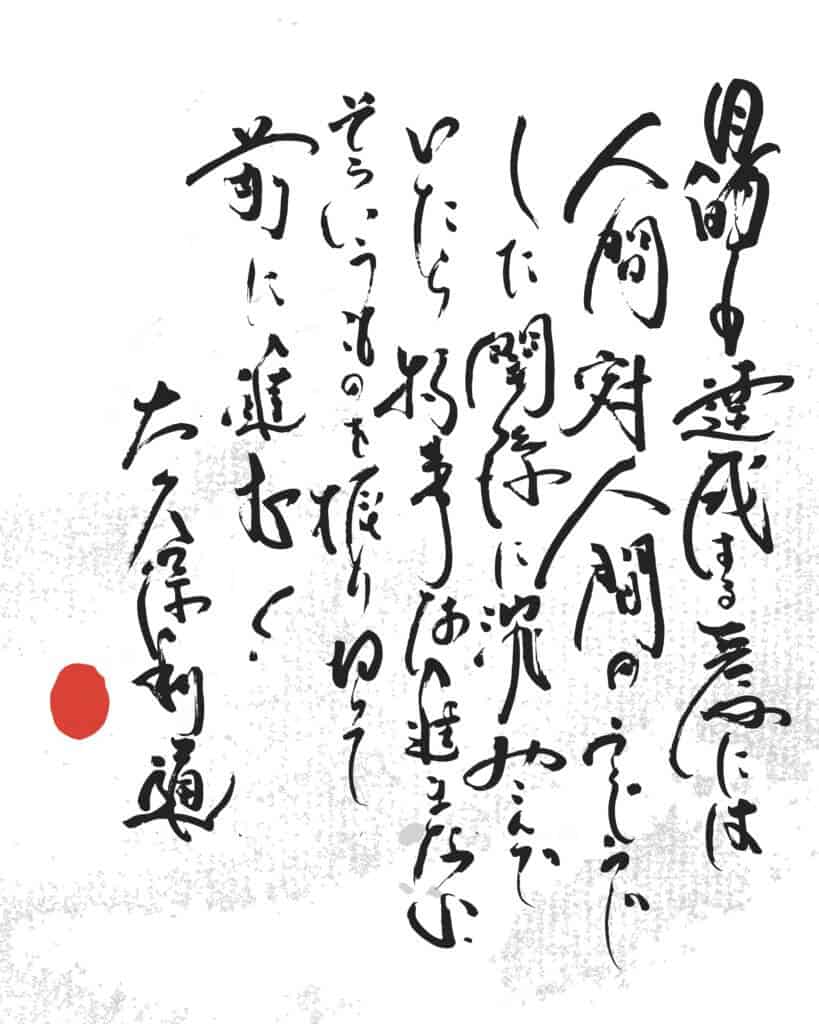
Additional Observations on Japanese
For the true language nerds out here are a few interesting facts about Japanese:
- There are no diphthongs in Japanese, only monophthongs, demonstrating that all Japanese vowels are “pure”
- Word order is classified as subject-object-verb, but the only strict rule there is that the verb must be at the end of the sentence
- The culture in Japan is VERY polite, and that is also represented in the spoken language as there is an extensive grammatical structure to express politeness, formality, and even differing levels of social status
Basic Japanese Words and Pronunciation
Japanese greetings – formal.
Here are some basic formal greetings (hi / goodbye) that you’d use on a regular day.
- Hello/Good day – Konnichiwa (こんにちは今日は)
- Good morning – Ohayō Gozaimasu (おはよう ございます お早う御座います)
- Good evening – Konbanwa (こんばんは)
- Good night – Shitsurei shimasu (しつれい します 失礼します)
- Goodbye – Sayōnara (さようなら)
Note, when greeting others in Japan be sure to accompany your words with a slight bow. This bow is often done again when saying goodbye as well.
Japanese Greetings – Informal
If you stay in Japan for a time and make friends, it may be appropriate for you to incorporate informal greetings into your vocabulary:
- Hi – Yā (やあ)
- Hey/Yo – Yō (よう)
- What’s Up? – Saikin dō? (さいきんどう最近どう)
- Bye – Jā / Jā ne (じゃあ / じゃあ ね)
- See you soon – Mata ne (また ね)
- See you again – Jā mata (じゃあ また)
- See you tomorrow – Mata ashita (また あした また明日)
- Be well – Genki De (げんき で 元気で)

Top 30 Japanese Phrases
Outside of Japanese greetings, here are the top 30 phrases that you should learn before visiting Japan:
- Hello – Kon’nichiwa (こんにちは)
- Yes – Hai ( はい)
- No – Iie (いいえ)
- Thank you – Arigatō* (ありがとう)
- Excuse me – Sumimasen* (すみません) – This phrase is important when trying to get the attention of your waiter in restaurants, and when passing people in tight quarters.
- Please – O-negai shimasu (おねがいします)
- You’re welcome – Dōitashimashite (どういたしまして)
- I’m sorry – Gomennasai (ごめんなさい)
- Do you speak English? – Eigo o hanasemasu ka (えいごをはなせますか。)
- I only speak a little Japanese – Watashi wa nihongo ga sukoshi shika hanasemasen. (わたしは にほんごがすこししか はなせません。)
- What is your name? – O-namae wa nan desu ka. (おなまえはなんですか。)
- My name is __ – Watashi no namae wa ___ desu. (わたしのなまえは かおりです)
- How are you? – O-genki desu ka. (おげんきですか。)
- I’m fine, thanks – Genki desu. (げんきです)
- I’m very glad to meet you – Oaidekite ureshī desu. (おあいできて うれしいです。)
- I don’t understand – Wakarimasen (わかりません。)
- What did you say? – Nante iimashita ka. (なんていいましたか。)
- Can you speak more slowly? – Motto yukkuri hanashite kudasai. (もっと ゆっくりはなしてください。)
- I understand you perfectly. – Yoku wakarimasu. (よくわかります。)
- How much is it? – Ikura desu ka? (いくらですか?)
- Do you have ___? – ______ wa arimasu ka? (はありますか)
- Help! – Tasukete (助けて。)
- I don’t need it. – Iranai (いらない)
- Great! / I’m glad! – Yokatta (良かった)
- Are you okay? – Daijoubu desu ka. (大丈夫ですか)
- What happened? – Doushitanda. (どうしたんだ)
- Welcome – Irasshaimase. ( いらっしゃいませ)
- How much does it cost? – Ikura kakarimasu ka? (いくらかかりますか?)
- It costs. .. – Hiyō ga kakarimasu (費用がかかります)
Note: I’ve put an asterisk by the phrases that I used the most while traveling through Japan.
Counting to 10 in Japanese
There are two methods of counting in Japanese: 1) Sino-Japanese and 2) Native Japanese. Sino-Japanese is used most often (by far), so this is what is demonstrated in the tabel below:
RELATED: The Link Between Languages and Travel
Pronouncing Japanese the Right Way
Check out this video from a native speaker that covers pronunciation for many of the phrases listed above. For best results, practice saying the words out loud so that you get used to speaking them.
Japanese Travel Phrases PDF
Keep your learning going by downloading this Japanese Phrases PDF. You will be able to practice as needed before your trip!
FAQs about Learning Japanese for Travel
Before your trip to Japan, some common phrases you should learn are “Arigatou gozaimasu” (Thank you very much), “Sumimasen” (Excuse me/I’m sorry), “Konnichiwa” (Hello), “O-genki desu ka?” (How are you?), and “Eigo o hanashimasu ka?” (Do you speak English?).
Japanese people often say “Ittekimasu” (I’ll go and come back) before leaving their home, which is a polite way of saying they are heading out. Similarly, upon returning, they say “Tadaima” (I’m back) to announce their arrival.
The Japanese word for travel is “tabi” (旅).
Some must-know phrases for Japanese travel include “Doko desu ka?” (Where is it?), “Ikura desu ka?” (How much does it cost?), “Eki wa doko desu ka?” (Where is the train station?), “Kudasai” (Please/give me), and “Osusume no o-sake wa arimasu ka?” (Do you have any recommended sake?).
Some cool Japanese phrases include “Yoroshiku onegaishimasu” (Please take care of it/Thank you in advance), “Kawaii” (Cute), “Oishii” (Delicious), “Ganbatte” (Good luck/Do your best), and “Natsukashii” (Nostalgic).
Learning Japanese for Travel | Final Recommendations
That wraps my list of essential Japanese phrases for travelers. Now that you know WHAT you need to learn, the next step is to take it into practice. I suggest that you do that by downloading the attached PDF of key Japanese phrases, and practice the phrases daily for at least a month before your trip.
To complement learning these phrases, there are a few additional resources that you may find helpful:
- iTalki – On this site you can practice with a tutor, formal teacher, or others just seeking to do a language exchange (for free!). The paid lessons have very cheap options, with some as low as $5 an hour. Check it out!
- LigoPie – Practice listening and reading Japanese with videos. You can make changes to the speed you are listening to as well. This is the best way to rapidly increase your comprehension skills!
- Japanese Pod – There are so many free resources on the website and through the podcast they offer. There are paid options as well.
- Duolingo – I don’t find this app useful for practicing spoken language, but it will help you remember key phrases through repetition.
Have you studied Japanese before? Let me know if you have any additional tips in the comments below!
Related Posts on Japan:
- 2 Days in Kyoto
- 4 Days in Tokyo
- Hakone Travel Guide
- The Best Samurai Experience in Kyoto
- Ninja Akasaka Review
Additional Travel Language Guides:
- Portuguese for Travel
- Spanish for Travel
- Italian for Travel
- Thai for Travel
- Greek for Travel
- Language and Travel
Don’t forget to pin this for later!
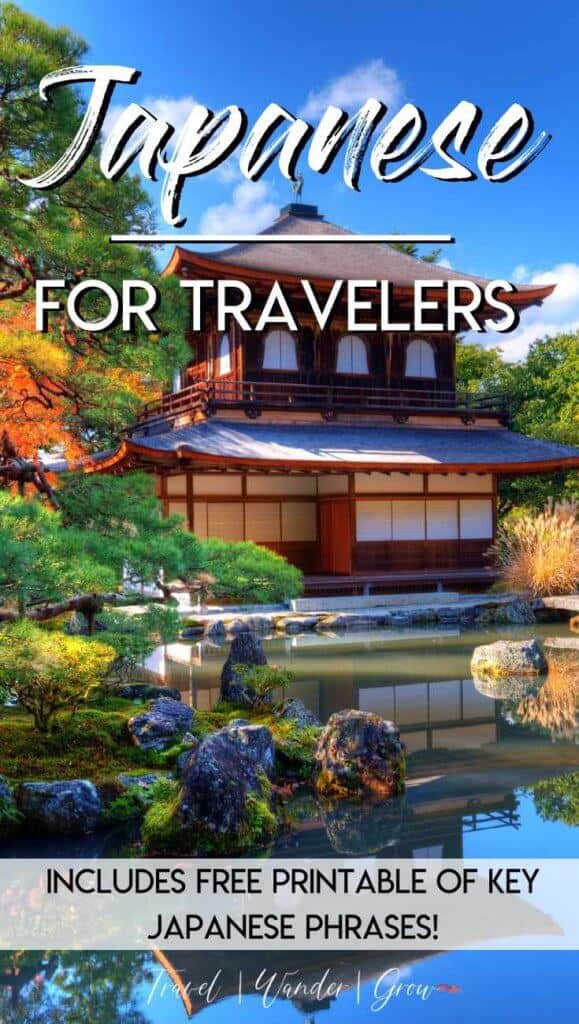
Christen Thomas is the founder of TravelWanderGrow, established in 2018. She has lived abroad and traveled extensively to over 30 countries. In addition, she is a certified Travel Advisor and is an expert in planning trips focused on city history and culture. As a frequent traveler, she also shares tips on how to prepare to travel well and how to save money while doing so.
Pinning this for later as we’re hoping to visit Japan in the next few years. Great breakdown of the common phrases. I had a Japanese roommate in high school so I’ve heard a lot of these phrases, but never knew how to spell them – so interesting!
Glad you have found the guide helpful, Emily! Hope you get to practice the phrases soon :).
I am Korean-American & can speak conversational Korean. I feel I would be able to easily pickup Japanese but they seem to talk so fast! Thanks for sharing this post! My husband & I hope to visit Japan later this fall…it will come handy!
Doesn’t it always seem that others speak so fast when you are learning a language? Hopefully you can put these to good use on your trip to Japan!
Very useful and interesting. Thank you! Keep it coming
Glad you found it helpful, Oliver!
Leave a Reply Cancel reply
Your email address will not be published. Required fields are marked *
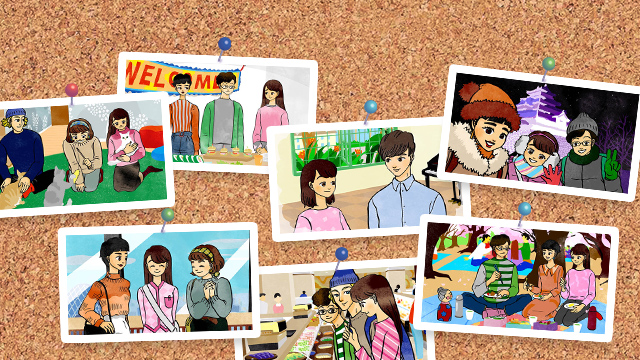
Link to Lessons
Click here to access all 48 lessons and learn the basics of Japanese conversation. Master daily greetings and travel phrases. The lessons also include sightseeing hints and cultural tips.
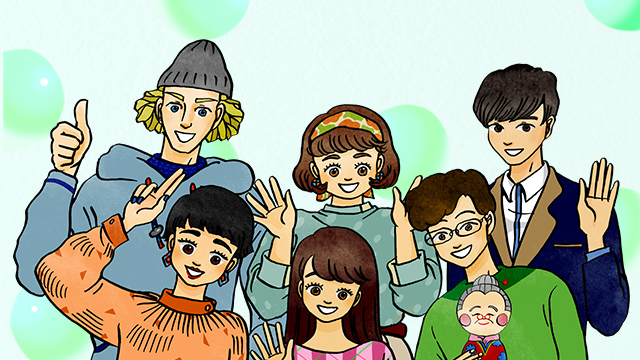
How to use this site
The website--with audio, animated video, and text--helps you learn the basics of Japanese. It offers 48 lessons. Here's how to use the site.
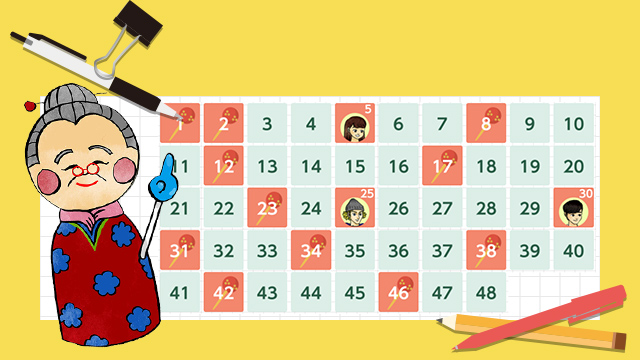
My Haru-san Track your progress
Keep track of your progress on your personalized My Haru-san page. Review your quizzes too, and register words and phrases you’d like to remember.

Resources for Downloading
MP3 audio files of the lessons and PDF files of the textbook can be downloaded free of charge (for personal use only).
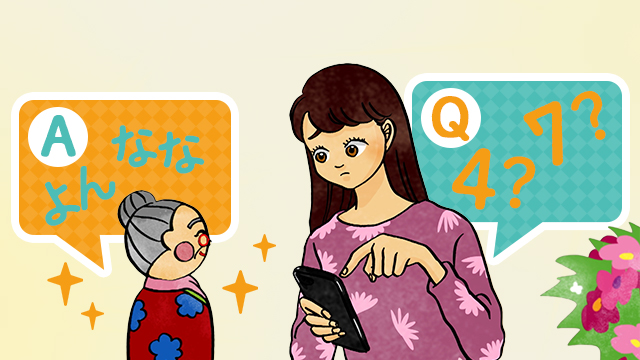
We'll Answer Your Questions
Program supervisors Fujinaga Kaoru and Isomura Kazuhiro respond to listeners' inquiries about the Japanese language.
Choose a Lesson

Japanese Letters

Key Phrases

See more…
50 Essential Japanese Phrases for Travel
- Everything About
- The Alphabet
- Common Phrases
- Best Resource Books
- Reading Hacks
- Learn with Games
- Pronunciation
- Guide to Particles
- How to Learn
- Chinese vs. Japanese
- Learn FASTER
- More Resources
By OptiLingo • 5 minute read

You Need to Know a Few Japanese Phrases
Japan is a tourist hot spot . And a lot of Japanese people speak English. But, not all. So, if you want to make sure you can communicate with all Japanese people you meet, you need to know at least a few phrases. Or have them in your pocket in case you need them. These 50 basic Japanese phrases are the perfect sentences for any traveler.
Speaking a little Japanese can get you further than you think. Even with these sentences, you can ask for directions, get better opportunities, and show that you appreciate Japanese culture. Japanese people will definitely appreciate your effort, and they’ll probably give you better customer service. Discover Japan better than normal tourists, and see this beautiful country through the eyes of its locals .
50 Common Japanese Phrases
The trick to reaching japanese fluency fast.
These 50 phrases are the perfect start to speaking Japanese. That’s because they’re very common. Japanese people use them every day. And Japanese locals don’t actually use a lot of their vocabulary.
In fact, they only use 20% of the words they know for 80% of their conversations.
It’s called the Pareto Principle , and it’s the trick you need to use to become fluent in Japanese fast. By focusing on only the most common Japanese words and phrases, you can cut your study time significantly, and still partake in most conversations with locals. Less study time, more benefits.

How to Learn Useful Japanese Phrases
You could always have these 50 survival Japanes phrases on a piece of paper. But, if you want to really impress people, you should definitely learn them. Luckily, it’s not difficult at all to master these. Here are a few tricks that can help you commit Japanese words and phrases to memory.
- Space them out : don’t try to learn all 50 phrases at once. Learn 5-10 every day instead. You won’t overwhelm yourself, and you’ll remember more the next day .
- Review them often : of course, by the time you wake up the next day, you’ll have forgotten most of your lesson. No worries, just repeat them. Then again the next day. The more you review, the more you’ll remember.
- Say them out loud : You need to speak to reach fluency . So, with these Japanese phrases, the more you say them when you practice, the more comfortable you’ll be. By the time you’ll have to say them to a Japanese local, you’ll be confident.

Psst! Did you know we have a language learning app?
- It teaches you useful words and phrases.
- Presented in a natural, everyday context.
- Spaced out over time, so you absorb your new language organically.
- It’s kind of like learning the words to your new favorite song!
You’re only one click away!
Learn More Japanese Easily
These 50 phrases will definitely help you as you’re traveling Japan. And, who knows? Maybe you’ll fall in love with the people and the culture, and you’ll continue learning Japanese. If so, you need the most useful Japanese phrases to get you to fluency fast. Much like these ones. You can find them all on OptiLingo.
OptiLingo helps you get to Japanese fluency the fastest. This app won’t waste your time with unnecessary vocabulary. With guided pronunciation practice, OptiLingo can surely help you communicate with locals effortlessly. Achieve your dream of speaking Japanese by downloading OptiLingo !
Related posts
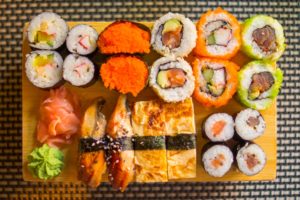
Japanese Numbers and Counting System

How Long Does It Take to Learn Japanese?

The Japanese Alphabet and Writing System
Many people believe they aren’t capable of learning a language. we believe that if you already know one language, there’s no reason you can’t learn another..

Descargate tu Planificador de Viajes
Touristear Travel Blog
Síguenos en Instagram!
50 Important Japanese Travel Phrases for Traveling to Japan
Welcome to your essential guide to Japanese phrases for traveling to Japan!
If you are planning a trip to Japan, learning some basic Japanese phrases will not only enhance your experience but will also help you connect with the local culture and people.
In this post, we will introduce you to simple but useful phrases that will make it easier for you to communicate in everyday situations, from asking for directions to shopping. Let’s get started!

Basic Phrases in Japanese
Greetings and basic phrases in japanese.
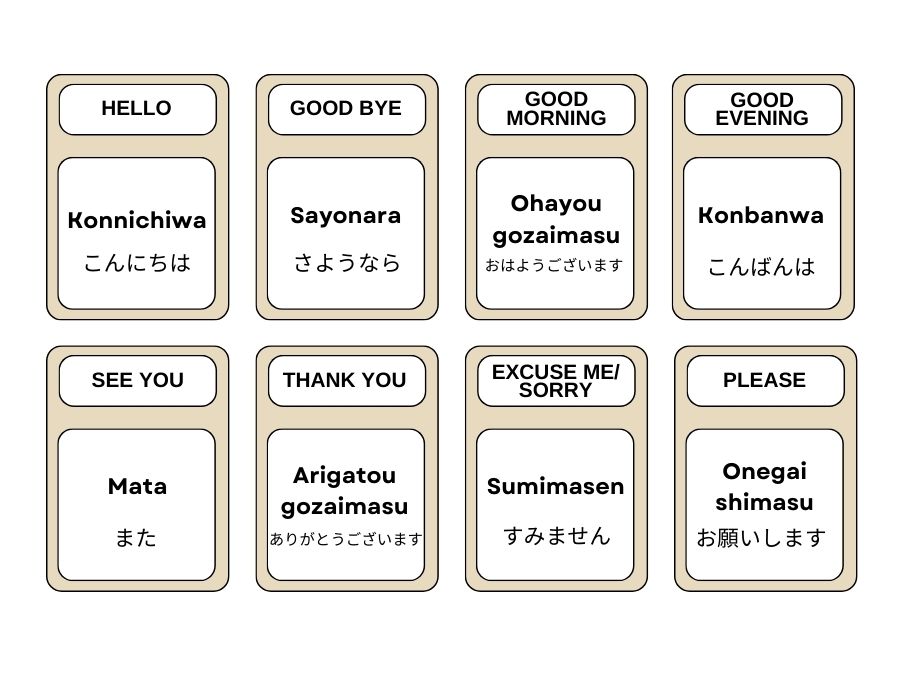
- Hello : Konnichiwa (こんにちは)
- Goodbye : Sayonara
- Good morning : Ohayou gozaimasu
- Good afternoon/evening: Konbanwa
- See you later : Mata
- See you tomorrow : mata shita
- Thank you politely : Arigatou gozaimasu (ありがとうございます). .
- Excuse me/Sorry : すみません (Sumimasen). It is used both to apologize; for example, if you bump into someone while walking, you say sumimasen; it is also used to call the waiter (as excuse me.
- Sorry : Gomenasai (ごめんなさい)
- Please : onegai shimasu (お願いします)
- You are welcome : Doo itashimashite.
- Nice to meet you : Hajimemashite (初めまして)
- I am Veronica : Veronica desu
How to say yes or no
Yes : hai! .
No : iie (you must extend the i and pronounce both).
Common Questions
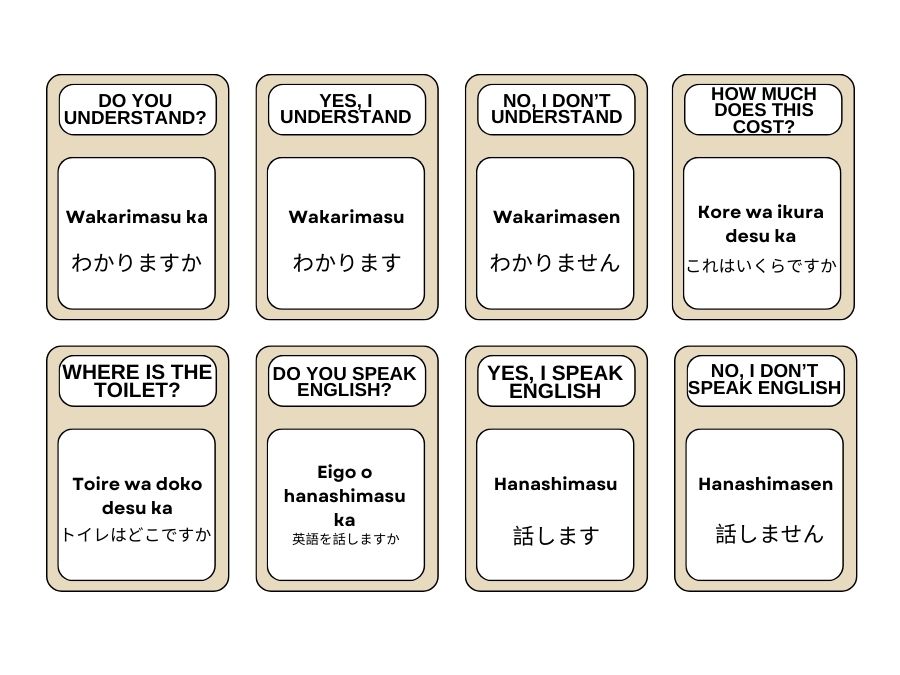
- Do you understand? : Wakarimasu ka (わかりますか)
- I understand : Wakarimasu (わかります)
- I don’t understand : Wakarimasen (わかりません)
- How much does this cost? : Kore wa ikura desu ka (これはいくらですか)
- Where is the bathroom? : Toire wa doko desu ka (トイレはどこですか)
- Do you speak English? : Eigo o hanasemasu ka (英語を話せますか)
- Yes, I speak English : Hanashimasu (話します)
- No, I don’t speak : Hanashimasen (話しません).
- I don’t understand Japanese : Nihongo ga wakarimasen.
More vocabulary
- How cute : Kawaii
- Yummy : Oishii!
- Cheers : Kanpai!
- Wait a minute : Chotto matte kudasai!
Address and Location Questions
When visiting Japan, needing help with directions and finding locations is natural. Here are some key phrases to ask for directions and locations:
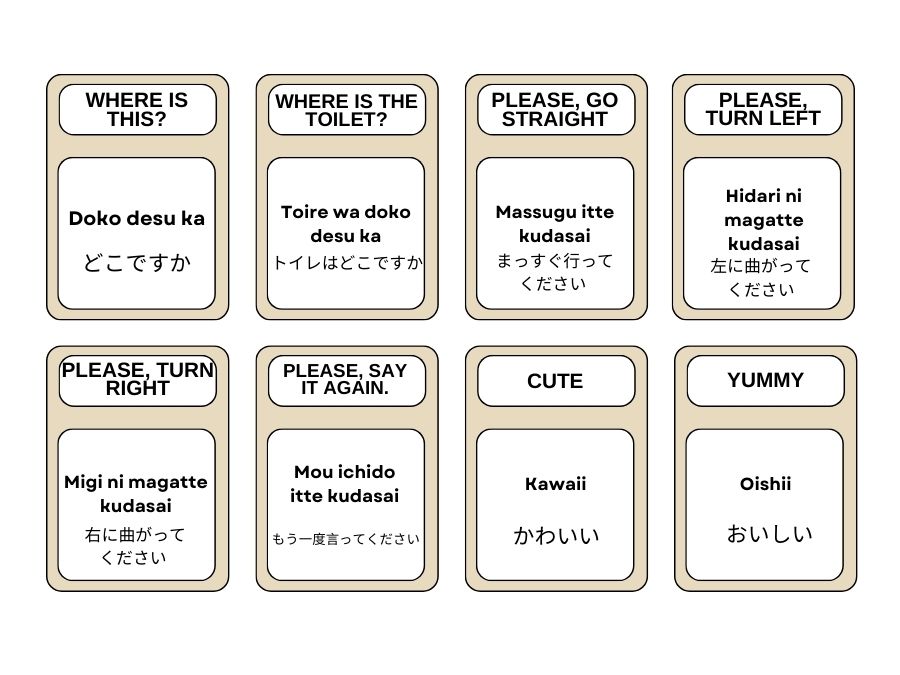
- Where is this? : doko desu ka (どこですか)
- Where is the bathroom? otearai wa doko desu ka, or toire wa doko desu ka (トイレはどこですか)
- Please go straight : massugu itte kudasai (まっすぐ行ってください )
- Please turn left : hidari ni magatte kudasai (左に曲がってください )
- Please turn right : migi ni magatte kudasai (右に曲がっってください )
- Please say it again : mou ichido itte kudasai (もう一度言っってください )
山手 (yamanote) – A major train line in Tokyo, often used as a landmark for directions.
While using these phrases, keep a map handy to understand better the directions the locals give. By learning these essential Japanese phrases, you will be better equipped to ask questions and communicate effectively during your trip to Japan.
Basic Japanese numbers
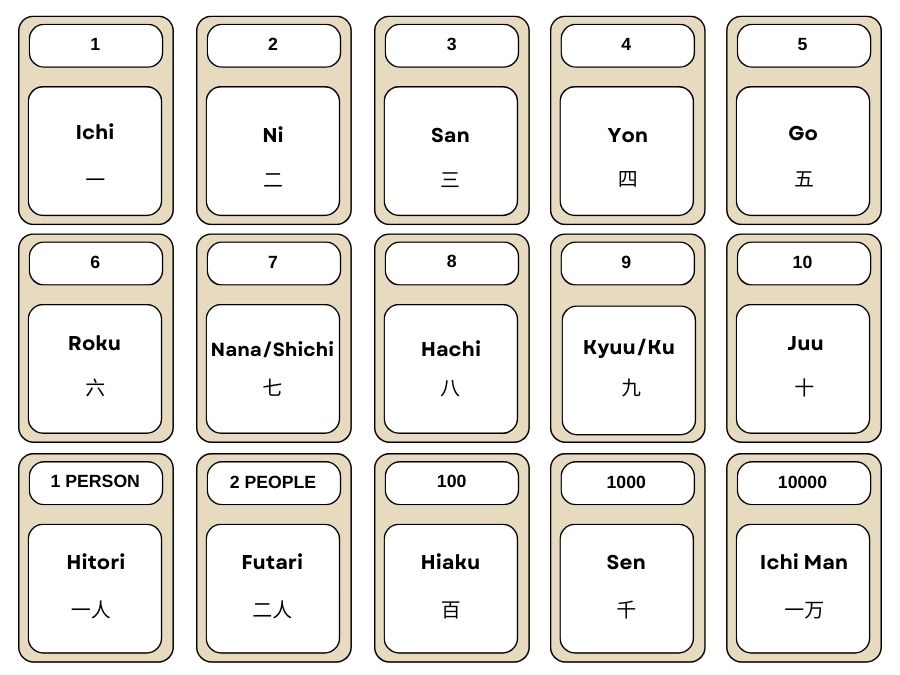
- One : Ichi: 一
- Two : NI: 二
- Three : San: 三
- Four : Shi/Yon: 四
- Five : Go: 五
- Six : Roku: 六
- Seven : Shichi/Nana: 七
- Eight : Hachi: 八
- Nine : Kyu/Ku: 九
- Ten : Juu: 十
- Twenty : Nijuu: 二十
- Thirty : Sanjū: 三十
- Forty : Yonjū/Shijū: 四十
- Fifty : Gojū: 五十
- Sixty : Rokujū: 六十
- Seventy : Shichijū/Nanajū: 七十
- Ochenta : Hachijū: 八十
- Ninety : Kyūjū/Kujū: 九十
- Hundred : Hyaku: 百
These numbers are fundamental in Japanese and are used to construct other larger numbers. For example, 21 would be “二十一” (nijū ichi), literally “twenty-one”.
In the case of the number of persons, there are exceptions for one person and two persons.
- One person : Hitori
- Two people : Futari
If someone asks you how many people are, for example in a restaurant (何人ですか? (Nan-nin desu ka?))
- You can answer hitori desu, and it means 1 person.
- If you are two: futari desu
- If three: san nin desu (3 people)
- If there are four: yon nin desu (4 people)
At the restaurant
Restaurant reservations:.
I would like to make a reservation at a restaurant : Resutoran o yoyaku shitai desu (レストランを予約したいです). You can ask the hotel reception to make the reservation for you.
Ask if there is availability: do you have a table for two for tonight: Konya, futari-yō no seki wa arimasu ka (今夜、二人用の席はありますか)
Specify time: I would like to book for 7: Shichi-ji ni yoyaku shitai desu (7時に予約したいです).
Arriving at the Restaurant: Confirm a reservation . I am Yamada, I have a reservation: Yoyaku or shita Yamada desu. (予約をした山田です)
If you don’t have a reservation: Do you have tables available: Seki wa aite imasu ka (席は空いていいますか)
Ordering and Eating
Look at the menu : Please show me the menu: menyū o misete kudasai. (メニューを見せてください)
Ordering food: Once you have decided what to order, you can say “Chuumon wo onegaishimasu” (注文をお願いします) followed by Kore or onegaishimasu.
This, please: Kore o onegaishimasu. (これをお願いします)
Asking for recommendations: What is the recommendation: Osusume wa nan desu ka (おすすめめは何ですか).
Before starting to eat
Itadakimasu : いただきます。 It is said before eating, similar to saying “bon appetit” in French. However, its meaning goes beyond these phrases.
Meaning and Use
Gratitude for Food : “Itadakimasu” expresses gratitude for the food to be consumed. This includes appreciation not only for the food itself but also for the effort and resources needed to prepare it.
Respect for Nature : In Japanese culture, there is a strong sense of respect for nature and all it has to offer. Saying “itadakimasu” acknowledges and thanks all life forms and natural elements that contribute to the creation of food.
Cultural Awareness : It is an expression of the harmonious relationship between humans and nature, a concept deeply rooted in many Japanese practices and traditions.
Everyday Use : Commonly said at home before meals, in restaurants, and at gatherings where food is shared.
During Lunch
- Water, please: Mizu o kudasai. (水をください)
- Tea, please: Ocha o kudasai.(お茶をください)
- Beer, please: Bīru o kudasai.(ビールをください)
Food Preferences and Requests
When ordering food, you may need to express your preferences or make specific requests. Here are some phrases to help you do just that:
To ask if a particular type of alcohol is available, e.g. sake, say, “Osake wa arimasu ka?” (お酒はありますか?).
If you want your dish to be prepared in a specific way, such as making it a little spicier, say, “Mou sukoshi karakushite kudasai” (もう少し辛くしてください).
After Eating
Thank for food : Gochisōsama deshita (ごちそうささまでした). Thank you for the food, it is said after eating.
Ask for the account
Account, please : Okanjō onegaishimasu (お会計お願いします)
To ask if they accept credit cards , you can use: “Kurejitto kaado de haraemasu ka” (クレジットカードで払えますか).
Useful Vocabulary
- Restaurant : Resutoran (レストラン)
- Reserve : Yoyaku (予約)
- Seat/Table : Seki (席)
- Menu : Menyū (メニュー)
- Please (when you ask for something): Onegaishimasu (お願いします).
- Account (in a restaurant): Okanjō (お会計).
- Mizu : water
- Green tea : Ocha
- Coffee : coohii
- Coffee with milk : kafe ore
- Black coffee : burakku koohii
- Juice : juusu
Common questions in the restaurant
- How much does this cost? : Kore wa ikura desu ka? ( これはいくらですか)
- Where is the bathroom? : Toire wa doko desu ka? (トイレはどこですか)
The Lodging
Check-in : I would like to check-in: Chekku-in or onegaishimasu. (チェックインをお願いします).
Say How Many People Are:
- We are two people: Futari desu (二人です)
- I made a reservation for one person: yoyaku shimashita’s Hitori (一人で予約しました).
Asking for Room: What is my room number: Heya bangō wa nan-ban desu ka (部屋番号は何番ですか).
Request Wifi Information: What is the Wi-Fi password: Wi-Fi no pasuwādo wa nan desu ka (Wi-Fiのパスワードは何ですか).
Ask for Help or Information: Excuse me, [tu pregunta]: Sumimasen, [tu pregunta] (すみません、[tu pregunta])
Check-Out: I would like to check-out: Chekku-auto or onegaishimasu. (チェックアウトをお願いします)
Ask Check-Out Time: What time is check-out: Chekku-auto no jikan wa nan-ji desu ka? (チェックアウトの時間は何時ですか)
Thank you when leaving: Thank you for everything (said as a token of appreciation for the attention received): Osewa ni narimashita. (お世話になりました)
Getting around the city
Ordering General information
- (Place) wa doko desu ka: general phrase to ask where something is; it can be a destination, a station, or even the toilet.
- (Place) e ikitai no desu ga : I would like to go to …
- Where is the subway station? Chikatetsu no eki wa doko desu ka. (地下鉄の駅はどこですか)
- Where is the train station? : Densha no eki wa doko desu ka (電車の駅はどこですか)
- Ask Hotel Directions: Where is the hotel [Nombre del Hotel]?: Hoteru [Nombre del Hotel] wa doko desu ka: ホテル [Nombre del Hotel] はどこですか
- Ask How to Get to a Tourist Site: ([Nombre del Sitio Turístico] wa doko desu ka. [Nombre del Sitio Turístico] はどここですか)
- Ask for the Bus Stop: Where is the bus stop? Basu tei wa doko desu ka. (バス停はどここですか)
- Ask if a Train/Bus goes to a Specific Destination: Does this train/bus go to [Destino]? Kono densha/basu wa [Destino] ni ikimasu ka (この電車/バスは[Destino]に行きますか)
- Ask to be advised where to get off: I would like to get off at [Destino], could you please let me know. [Destino] de oritai no desu ga, oshiete itadakemasu ka. ([Destino]で降りたいのですすが、教えていただけますか)
- Confirm Address: Is this going to [Destino]?: Kore wa [Destino] e mukatte imasu ka. (これは[Destino]へ向かっていますか)
Other interesting phrases to learn or print
- Where is this place? : Koko wa doko desu desu ka? (ここはどこですか)
- Please look at this map: Kono chizu wo mite kudasai (この地図を見てください)
- How can I get to this place? : Koko ni iku ni wa dou sureba ii desu ka? (ここに行くにはどうすればいいですか)
- How can I get to this location? : Kono basho ni wa douyatte ikemasu ka? (この場所にはどうやって行けますか)
- How far away is it? : Dono kurai tooi desu ka? (どのくらい遠いですか)
- Where can I look for information about transportation in this area? : Kono chiiki no koutsuujouhou wa doko de shiraberaremasu ka? (この地域の交通情報はどこで調べられますか)
In case you need any clarification or additional information:
- Sorry, can you tell me one more time: Moushiwake arimasen ga, mou ichido oshiete itadakemasu ka? (申し訳ありませんが、もう一度教えていただけますか?)
- Does this bus go to ….? Kono basu wa (destination) yuki desu ka? (このバスは○○行きですか?)
- Where can I take the bus? Doko de basu ni noremasu ka? (どこでバスに乗れますか?)
- Can I get to the station… with this? Kore de …-eki ni ikemasu ka? (これで….駅に行けますか?)
- I plan to get off at the next station. Tsugi no eki de oriru yotei desu (次の駅で降りる予定です) –
- Is the track northbound or southbound? Nanboku-me desu ka? (南北目ですか?)
- Where is the station? Eki wa dochira desu ka? (駅はどちらですか?)
- Which platform is this train on? Kono densha wa nanbansen desu ka? (この電車は何番線ですか?)
Directions by Taxi
Taking a cab in Japan is convenient and comfortable. To ensure clear communication with your driver, learn these phrases:
- I want to take a cab. Takushii wo hirotai no desu ga (タクシーを拾いたいのですが) –
- Please go to “destination”: “destination” ni itte kudasai (…に行ってください).
Useful vocabulary
- Input : iriguchi (入口)
- Exit : deguchi (出口)
- Subway : chikatetsu (地下鉄)
- Subway stop/subway station : chikatetsu no eki (地下鉄の駅)
- Airport : kuukoo (空港)
- Cab : takushii (タクシー)
- Bus : basu (バス)
- Map : chizu (地図)
- Itinerary : Ryotei (旅程)
Shopping in Japan
- Japanese banknotes are 1000 (千円: sen-en), 5000 (五千円: go sen en and 10000 (一万円: ichi man en) yen.
- Yen in Japanese is said en and this is its kanji: 円
- Coins: 1 yen, 5 yen, 10 yen, 50 yen, 100 yen and 500 yen. They are very useful, especially in villages, temples, markets, etc.
- Ask where there is an ATM: ATM wa doko ni arimasu ka, o
- There is an ATM nearby: Chikaku ni ATM wa arimasuka.
- ATM is pronounced almost like in English but with the u at the end.
Order a Specific Size: Do you have this clothing in size [M Talla]?: Kono fuku no [M Talla] saizu wa arimasu ka? (この服の[M Talla]サイズはありますか)
Ask for a Specific Color: Do you have this in this color: Kono iro no mono wa arimasu ka? (この色のものはありますか)
How much does it cost: Kore wa ikura desu ka (これはいくらですか).
Asking to Try Something on: Can I try this on: Kore o shichaku shite mo ii desu ka? (これを試着してもいいですか)
Ask for Local Souvenirs: Do you have local souvenirs: Jimoto no omiyage wa arimasu ka? (地元のお土産はありますか)
Asking for a Bag: Do I need a bag: Fukuro wa irimasu ka? (袋はいりますか)
Methods of Payment: Can I use a credit card: Kurejittokādo wa tsukaemasu ka? (クレジットカードは使えますか)
If You Need Help: Excuse me, could you help me: Sumimasen, tetsudatte itadakemasu ka? (すみません、手伝っていただけますか)
Vocabulary: Colors in Japanese
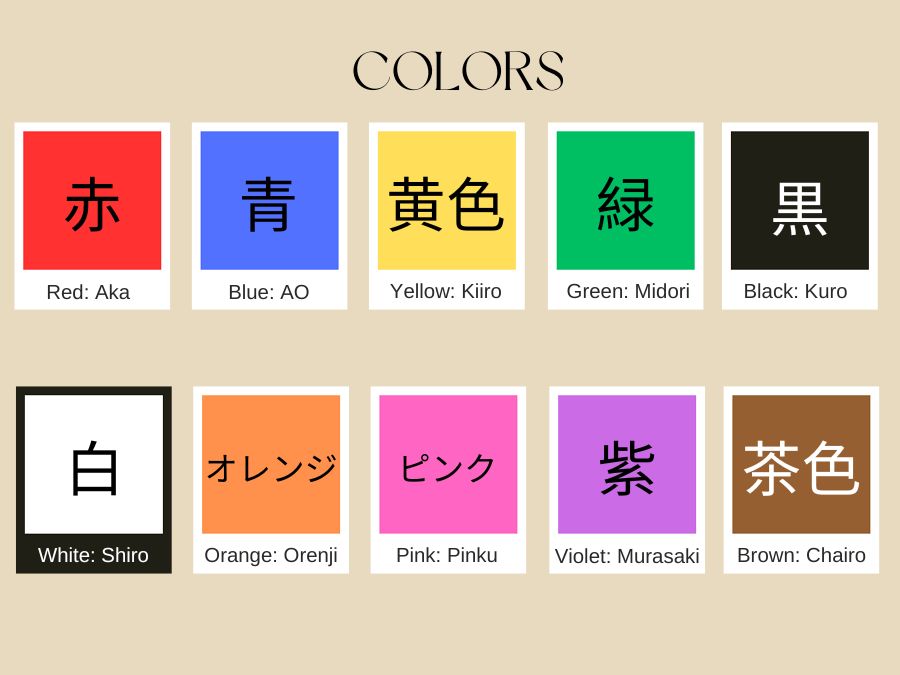
- Red : 赤 (Aka)
- Blue : 青 (Ao)
- Yellow : 黄色 (Kiiro)
- Green : 緑 (Midori)
- Black : 黒 (Kuro)
- White : 白 (Shiro)
- Orange : オレンジ (Orenji)
- Pink : ピンク (Pinku)
- Purple : 紫 (Murasaki)
- Brown : 茶色 (Chairo)
Ask for help
- Can you help me, please? Tasukete itadakemasu ka. (助けていただけますか)
- I’m lost : Michi ni mayoimashita (道に迷いました)
- Can you take me or accompany me to … (Place) made onegaishimasu.
- Do you speak English? Eigo o hanasemasu ka (英語を話せますか)
- I need a doctor : Isha ga hitsuyō desu (医者が必要です)
- Could you show me on the map? Chizu de oshiete itadakemasu ka (地図で教えていただけますか)
- How did I get to [destino] ? [Destino] e wa dō ikeba ii desu ka ([Destino]へはどう行けばいいですか)
- I need to call the police : Keisatsu o yobu hitsuyō ga arimasu. (警察を呼ぶ必要があります)
- Can you call me a cab? Takushī o yonde itadakemasu ka. (タクシーを呼んでいただけますか)
Here is a summary of etiquette and customs in Japan, which are fundamental to understanding and respecting Japanese culture:
Greetings : Japanese people usually bow their heads (bowing). Handshakes are less common and are reserved more for international situations.
Removing Shoes : It is customary to remove shoes when entering houses and certain places such as temples and ryokans (traditional inns). Slippers are often available for indoor use.
Punctuality : Punctuality is very important in Japan. Being late is considered disrespectful.
Behavior in Public Places : People are expected to be calm and respectful in public places. Talking loudly, especially on public transportation, is considered impolite.
Do not eat or drink while walking , as you may stain another person. Keep in mind that there are a lot of people.
Do not stand suddenly in the middle of the sidewalk , since there are so many people, it is better to stand on a side where you do not disturb the people walking.
Handling Chopsticks : Never stick chopsticks in your food, especially rice, as it is associated with funeral rituals. Also, do not pass food from chopsticks to chopsticks.
Gifts : Gift-giving is an important part of Japanese culture, especially when visiting someone in their home. Gifts are usually carefully wrapped and given and received with both hands.
Money : When paying in stores and restaurants, use the small tray provided to place money. Handing the money directly into the hand is not usual.
Meals : It is customary to say “itadakimasu” before eating and “gochisousama deshita” after eating. This shows respect and appreciation for the food.
Business Cards : In professional environments, the exchange of business cards is a ritual. Receive and hand out business cards with both hands, and take a moment to read the card before putting it away.
Photographs : Ask permission before photographing people, especially geisha or maiko in places like Kyoto.
This etiquette reflects the importance of respect, harmony and consideration for others in Japanese society. Knowing and following these rules can help make your experience in Japan smoother and more respectful.
Language Learning Tips
To begin learning Japanese for travel, start with some basic greetings such as “konnichiwa” (こんにちは; hello) and “ohayou gozaimasu” (おはようございます; good morning).
In addition to greetings, be sure to learn important phrases such as “sayounara” (さようなら; goodbye), “arigatou gozaimasu” (ありがとう; thank you), and “sumimasen” (すみません; excuse me).
Keep these tips in mind as you learn:
Practice regularly : Spend a few minutes every day reviewing and practicing your Japanese phrases to retain them in your memory.
Learn phonetically : Write down phrases in a way that helps you remember the pronunciation. Fortunately, for those of us who speak Spanish or Italian, pronunciation is not a problem, you just need to know some basic rules.
Carry a phrasebook or have a language app handy: Use them as a reference during your trip to look up phrases or practice while on the go.
Make flashcards : Write the Japanese phrase on one side and the English translation on the other.
Cultural Immersion : Try to immerse yourself in Japanese culture through movies, music, television programs and books in Japanese. This not only improves your understanding of the language, but also familiarizes you with Japanese culture and customs.
Interactive Learning Applications : Use applications that offer interactive and playful learning, such as Duolingo, Rosetta Stone or Babbel. These applications can make learning more engaging and fun.
Use Translation Tools and Dictionaries: Tools such as Google Translate or electronic dictionaries can be useful for quick translations and for helping users better understand new words and phrases.
Plan Your Trip to Japan
- How to plan a trip to Japan
- Itinerary of 11 full days in Japan
- How to use JRPass
- The best airport to get to Tokyo
- What to see in Tokyo
- What to see in Hakone
- What to see in Osaka
Last Updated on 29 January, 2024 by Veronica
Disclosure: Some of the links on this post are affiliate links, meaning at no additional cost to you, I may earn a small commission if you click through and make a purchase.
Author: Veronica
Vero, a seasoned traveler, has explored 25 countries and lived in five, gaining a rich perspective and fostering an infectious passion for travel. With a heart full of wanderlust, Vero uncovers the world’s hidden gems and shares insights, tips, and planning advice to inspire and assist fellow adventurers. Join Vero and let the shared passion for travel create unforgettable memories.
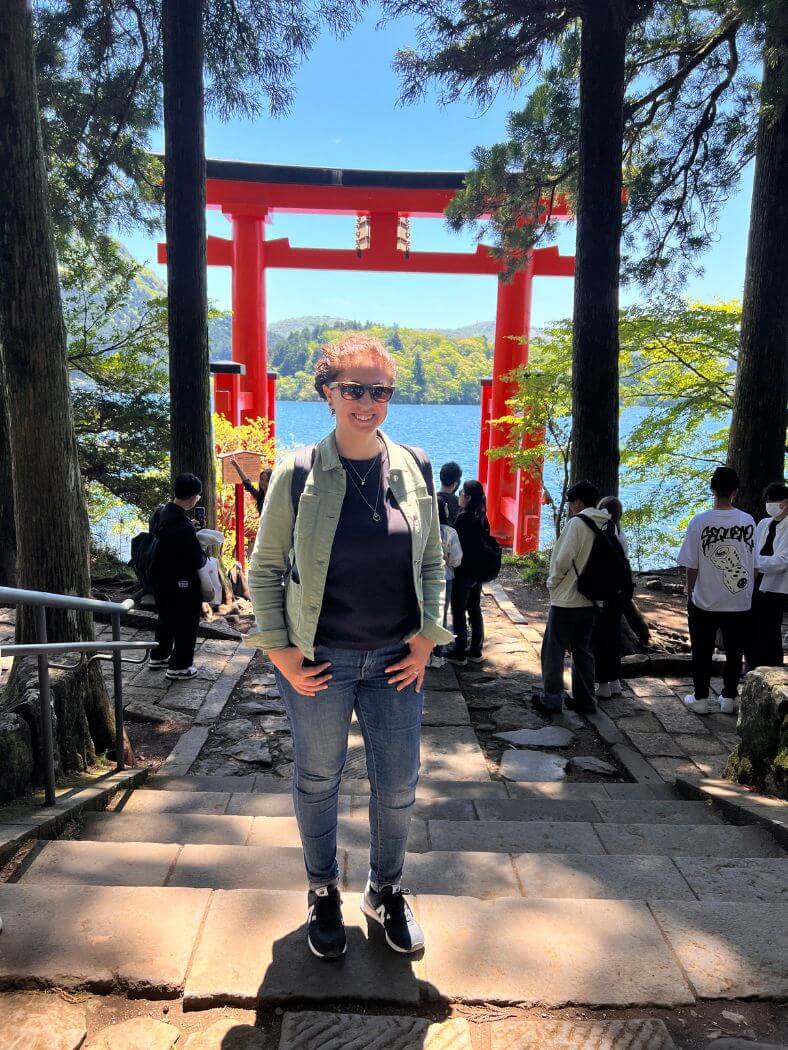
Soy Verónica, una apasionada de los viajes, me gusta compartir mis experiencias viajeras en mi blog. He estudiado Empresas y actividades turísticas y ando metida en el mundo del Marketing Digital. Me gusta aprender algo nuevo cada día, conocer nuevos lugares y culturas diferentes.
Similar Posts
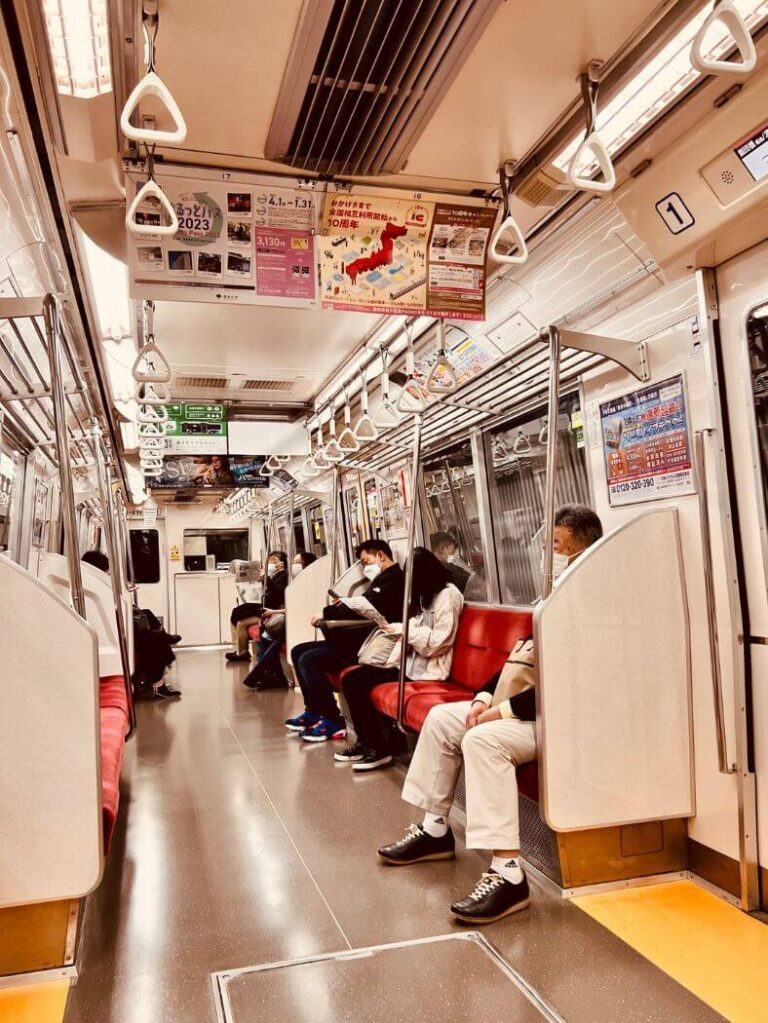
How is the Transport in Japan: Efficiency and Options
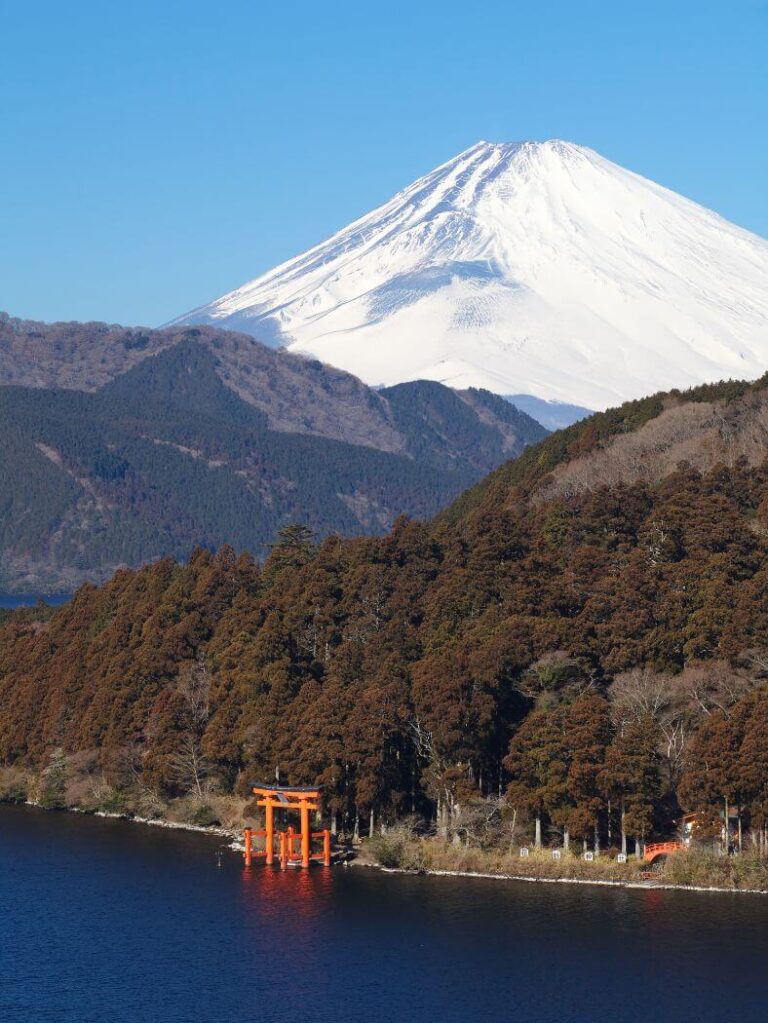
Best Things to Do in Hakone, Japan: Your Visit Guide
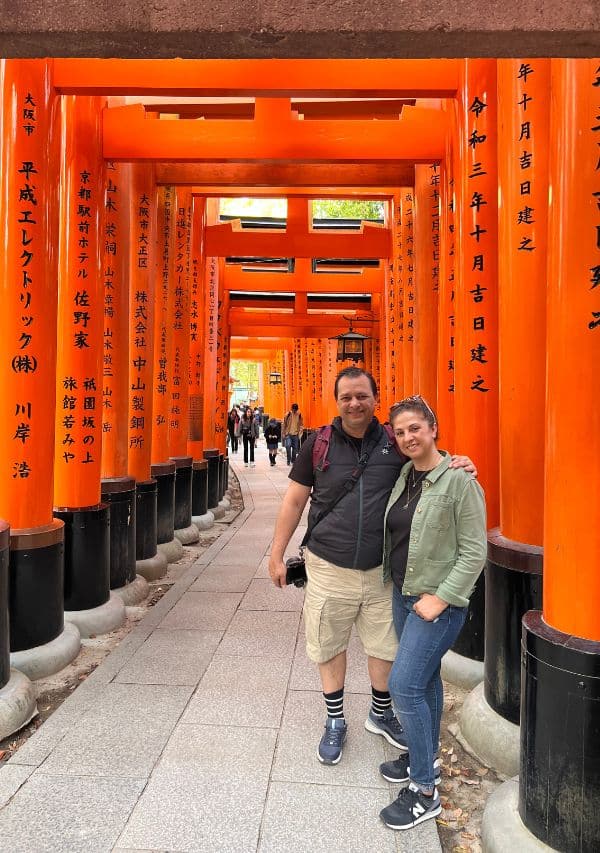
Kyoto 4 Day Itinerary: Explore the City’s Unmissable Highlights
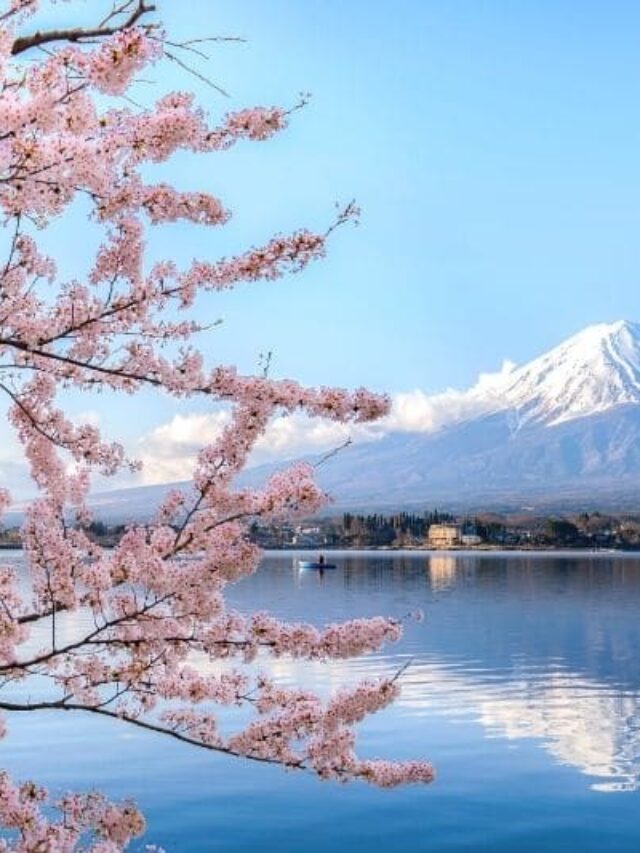
11 days in Japan Complete Itinerary
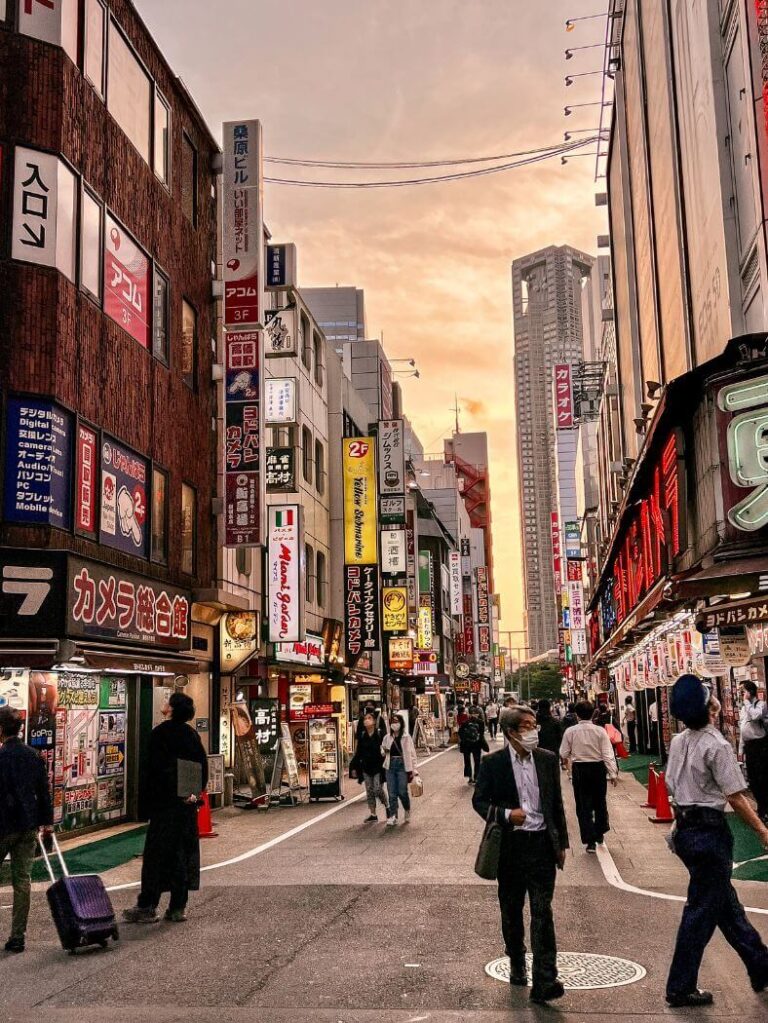
The Best 50 Things To Do in Tokyo, Top Attractions
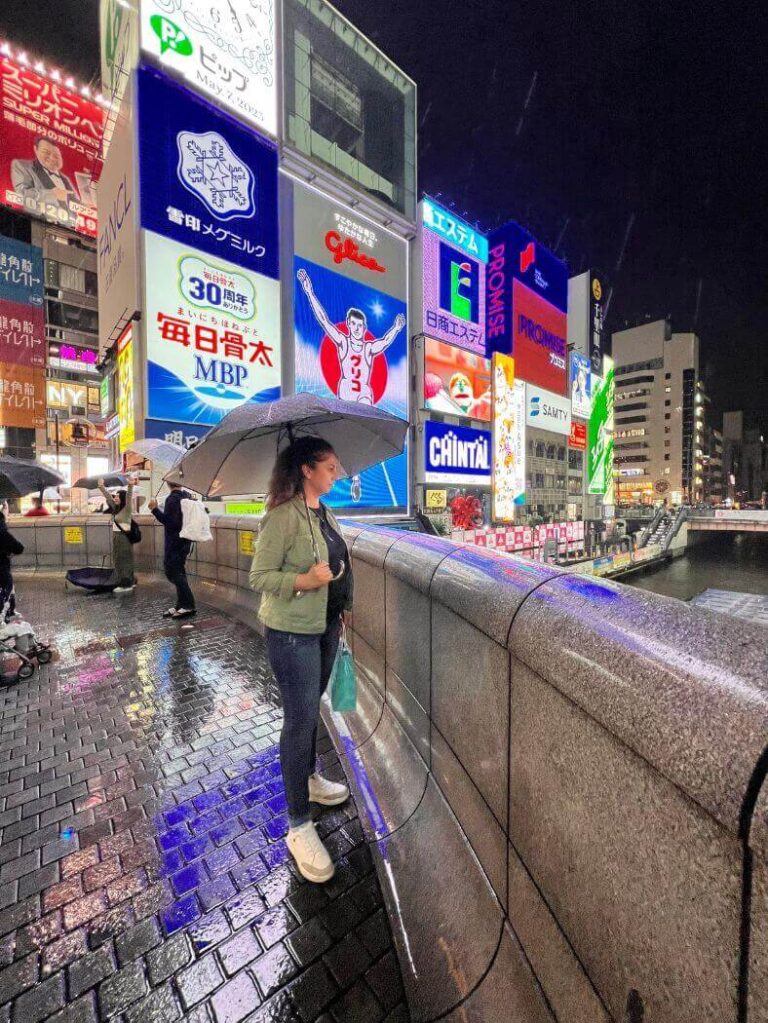
Best Things To Do in Osaka in 1-Day Itinerary
Leave a reply cancel reply.
Your email address will not be published. Required fields are marked *
Save my name, email, and website in this browser for the next time I comment.
This site uses Akismet to reduce spam. Learn how your comment data is processed .

50+ Basic Travel Phrases in Japanese (with Etiquette)

Irasshaimase! (いらっしゃいませ), or "welcome!" to your guide to Japanese travel phrases.
If you're planning a trip to Japan or simply interested in learning Japanese , this guide to using and understanding Japanese travel phrases is a must-read.
You don't need to learn the entire language before you make the trip of a lifetime. Still, knowing some key phrases, cultural differences and mannerisms will make Japan more accessible for English speakers.
Related: Saying Hello in Japanese: Pronouncing Japanese Greetings
First, we'll discuss the Japanese language and writing styles. Then, we'll cover some essential Japanese travel phrases, including "please", "thank you", "excuse me" and "I don't understand Japanese". Formality in Japanese will be explained, followed by restaurant vocabulary and etiquette.
Next, we'll cover certain phrases related to transport and travel, followed by pronunciation tips for common phrases used in Japan. Finally, we will answer frequently asked questions about Japanese phrases and travel to Japan.
The Japanese Language
Japanese words can be written in symbols or in Romanized characters, so beginners can still read and write before they learn the Japanese script.
However, when you learn Japanese characters you can better understand the nuances of the language.
Kanji are Chinese characters taken from the Chinese script and used in Japanese writing. This writing system was introduced to Japan in the 4th or 5th century, as Japan had a talking system but no means to write it down. Kanji are complex symbols that represent words or ideas.
However, Kanji characters are used along with the more recently created syllabic scripts of Hiragana and Katakana, which represent sounds.
Some people find these scripts easier to read as the symbols are simpler. Hiragana is generally used to represent Japanese words, while Katakana represents foreign words imported into the Japanese language.
While it is possible to write everything in Hiragana or Katakana, i t w o u l d l o o k l i k e t h i s . So, it is better to replace words with Kanji when possible. Japanese people use the three scripts interchangeably, as they are needed.
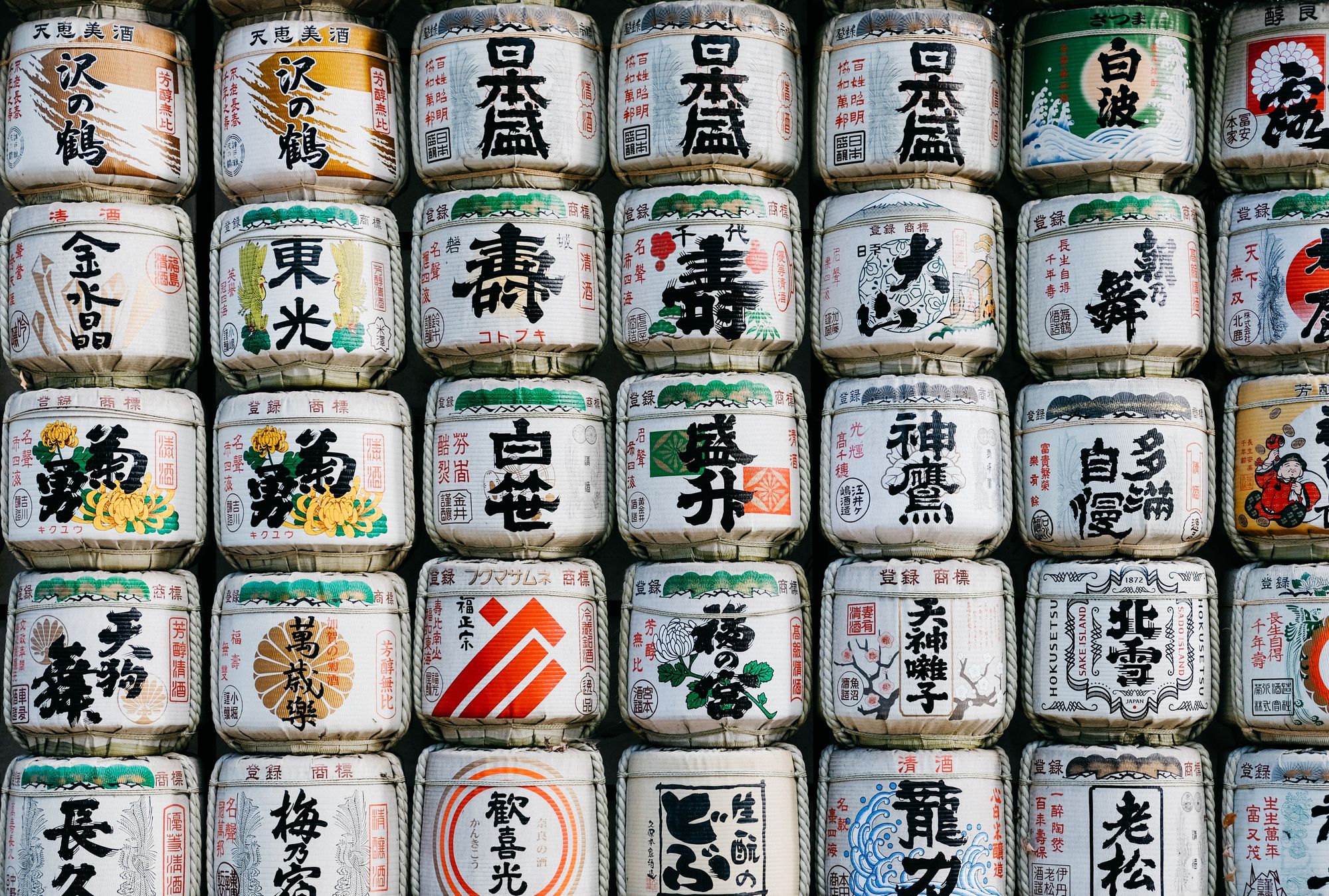
10 Essential Japanese Words And Phrases
When starting to learn Japanese, it's helpful to familiarize yourself with some essential words and phrases. These basic expressions can help you navigate common social situations, communicate politely, and express yourself in simple ways.
- Konnichiwa (こんにちは) – Hello/ good afternoon
- Ohayo Gozaimasu (おはよう ご ざ い ます) - Good morning
- Konbanwa (こんばんは) - Good evening
- Arigatou (Gozaimasu) (ありがとう (ご ざ い ます)) – Thank you (polite way).
- Onegaishimasu (お願い し ます)/ Kudasai (くだ さい) - Please
- Sumimasen (すみません) – Excuse me
- Hai (はい) - Yes/ I understand
- Iie (いいえ) - No
- Nihongo ga wakarimasen (日本語がわかりません) - I don't understand Japanese
- Gomen nasai (ごめんなさい) - I'm sorry
From greetings and gratitude to requests and acknowledgments, the following Japanese phrases are fundamental building blocks for beginner learners. Let's explore their meanings and contexts:
Konnichiwa (こんにちは)
A basic greeting used during the day. Suitable for use with strangers or casual acquaintances.
Ohayo Gozaimasu (おはようございます)
A polite way to greet someone in the morning. Useful for more formal situations or when addressing elders/superiors.
Konbanwa (こんばんは)
The evening greeting counterpart to konnichiwa. Appropriate for use from around sunset onwards.
Arigatou (Gozaimasu) (ありがとう(ございます))
Arigatou is the basic way to express thanks. Adding gozaimasu makes it more polite for formal situations.
Onegaishimasu/Kudasai (お願いします/ください)
Onegaishimasu is more formal, while kudasai is slightly more casual. Both express requests politely.
Sumimasen (すみません)
A versatile phrase used to apologize, get attention politely, or ask for a favor humbly.
The most basic way to express agreement or acknowledge something.
A simple, polite way to express negation or disagreement.
Nihongo ga wakarimasen (日本語がわかりません)
Useful for communicating language limitations politely when first learning Japanese.
Gomen nasai (ごめんなさい)
An important phrase to apologize sincerely in both formal and informal contexts.
Formality In Japanese
Social hierarchy, or your rank compared to others, determines how you will talk to someone in Japanese.
The generally accepted pecking order puts parents above children, teachers above students, customers above shopkeepers, bosses above employees, and elders above younger people.
Moreover, familiarity plays a part in how formal or informal you are with someone. Families will speak more casual Japanese with one another, while strangers use formal terms. Good friends drop formalities entirely and use slang to communicate.
Japanese words are conjugated based on formality. Formal Japanese can be divided into three categories: polite language, honorific language, and humble language.
There is also an informal way of communicating in Japanese, but when you learn Japanese, you often learn the formal first as the conjugation is easier.
Gozimasu and Arigatou
You do not need to worry too much about this as an absolute beginner. Just remember that you can make simple adjustments such as adding gozimasu (ご ざ い ます) to ohayō (おはよう) when saying "good morning" to make it more formal, or to arigatou (ありがとう) to say "thank you" the formal way.
Domo arigato (共 ありがとう) "thank you so much" is also formal. This is a phrase many westerners are familiar with due to the song Mr Roboto by Styx!
Arigato or domo used in isolation are two ways to say "thanks", informally. Use the latter two with friends and family.

Onegaishimasu and Kudasai
Finally, let's revisit when we use Onegaishimasu (お願い し ます) and Kudasai (くだ さい) for "please".
- Kudasai is the more familiar term, while onegai shimasu is more polite and honorable.
- So, you can ask for water, for instance, by using Kudasai (ください) or onegai shimasu ( を お願い し ます), depending on who you are talking to. For example:
- Mizu o onegai shimasu ( 水を お願い し ます) - I would like water, please (formal)
- Mizu o kudasai (水 お ください) - Give me water, please (informal)
Kudasai is a familiar request word that you use when you know you are entitled to something.
For instance, asking a friend or peer for something, or making a request from someone of a lower rank than you. Take a look at the following phrases:
- Mō yamete kudasai (もう やめて くだ さい ) - Please stop
- Chotto matte kudasai (ちょっと 待って くだ さい) - Wait a minute, please
- Kutsu o nuide kudasai (靴を脱いで くだ さい) - Please remove your shoes
- Shio o watashite kudasai ( 塩を渡して くだ さい) - Pass the salt, please
If you are speaking to a teacher, elder, or boss in Japan and don't understand something, you can ask: Mou ichido onegai shimasu (もう一度お願いします) - Could you repeat that, please?
As well as language, gestures also play a part in formality and respect in Japanese culture. One such gesture is the bow, and it matters how deep you bend!
A short bow at 15° is appropriate for a casual greeting. A 30° bow is good for greeting strangers and bosses, while a 45° bow conveys deep respect or an apology.
10 Food & Drink Basic Phrases in Japanese
- Menyū (メニュー) - Menu
- O-sake (お酒) – General term for alcohol (not to be confused with the below)
- Nihonshu (日本酒) – Japanese saké (rice wine)
- Bīru (ビール) - Beer
- Mizu (水) - Water
- Gohan (ご飯) - Rice
- Misoshiru (みそ汁) - Miso Soup
- Sushi (すし) - Sushi
- Mochi (餅 ) - Mochi (a traditional Japanese glutinous rice cake)
- ___ o Kudasai ( をください) – I would like __, please ___ o onegai shimasu (を お願い し ます) - I would like ___ please
In addition to food and drink, you might want to know how to ask for other specific services in a Japanese restaurant.
- Kin'en seki (禁煙席) - Non-smoking seat
- Kurejittokādo wa tsukaemasu ka? (クレジットカードは使えますか) - Do you accept credit cards?
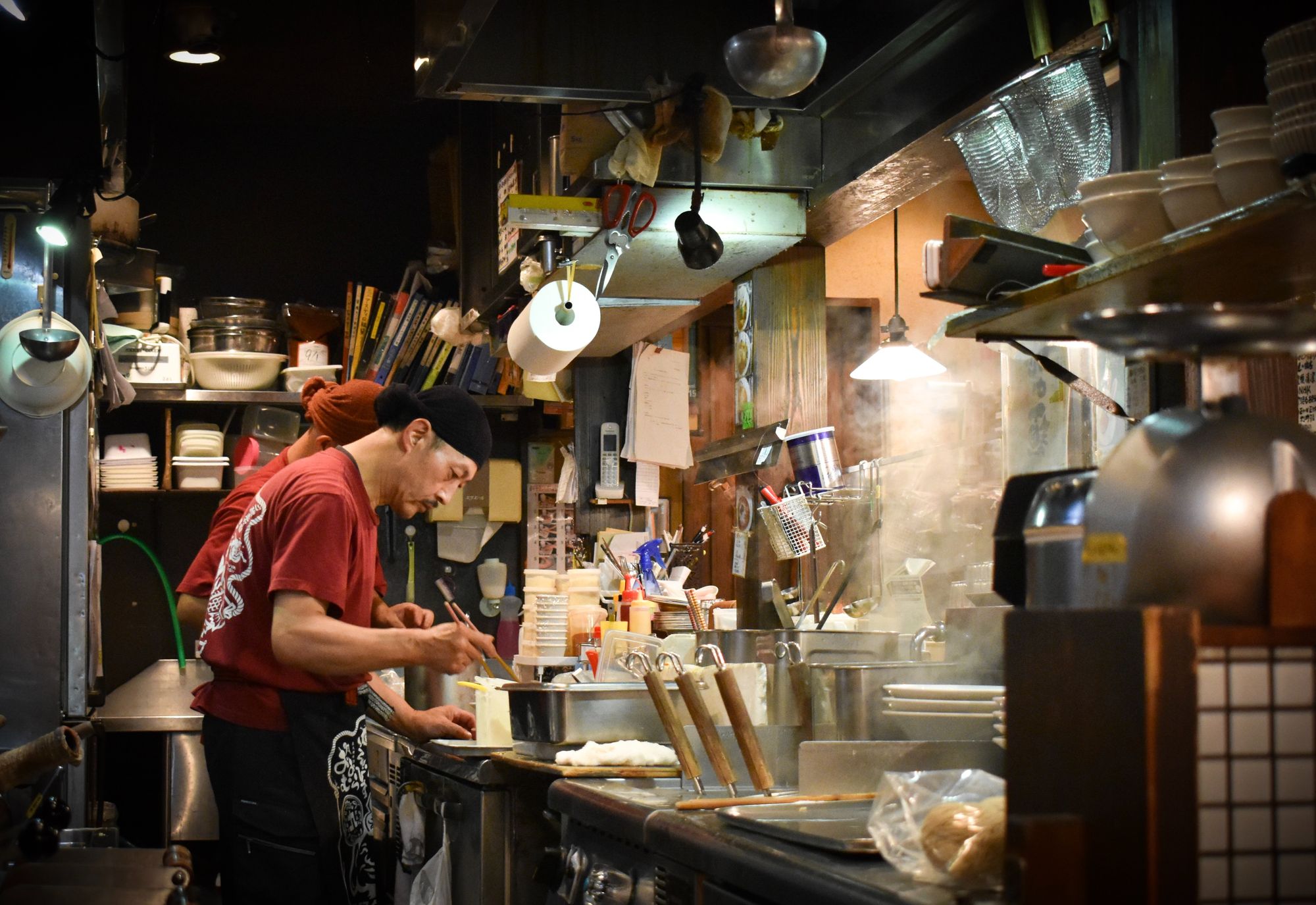
Japanese Restaurant Etiquette
It is not enough simply to know a few polite phrases in Japanese. You will also need to understand a bit about restaurant etiquette.
In many Japanese restaurants, there are low tables with cushions, rather than or in addition to western-style tables and chairs.
Cushions will be placed on tatami floors, which are a traditional kind of mat flooring in Japanese restaurants. You should never wear shoes or slippers on tatami flooring, and avoid stepping on anyone's cushion except your own.
Japanese Restaurant Vocabulary in Context
When the food comes, it is customary to wait for everyone's meals to arrive, then say:
- Itadakimasu (いただきます) - "I gratefully receive (this meal)"
You should say this before starting to eat. This is similar to the French "bon appetit".
However, if a dish is best eaten hot and it arrives before the others, the following phrase can be used:
- Osaki ni douzo (お先 に どうぞ) - "Please go ahead"
Other useful Japanese resturant phrases include:
- Daijyoubu Desu (だいじょうぶです) - "I'm fine now" (this is a polite way to decline something from a waiter offering you more water or food).
You can conclude the meal by saying the phrase:
- Gochisousama deshita (ごちそうさま でした) - "Thank you for the feast."
This expresses gratitude to the chef and for the ingredients of the meal.
At the end of your meal, you should use the following:
- Okaikei wo onegaishimasu (お会計 を お願いします) - "The check, please."
Manners in Convenience Stores
The following piece of vocaulary will be useful:
- Konbini (コンビニ) - Convenience store
In Japan, simple things like unfolding your bills before you hand them over to the cashier and not throwing down your coins are considered polite as they make the worker's job easier.
Customer service in Japan is famously excellent, so treat the clerk with respect and kindness, as you should in any other foreign country.

10 Transportation-Related Phrases In Japanese
- ___wa doko desu ka ( は どこ です か) – Where is __?
- Eki (駅) - Train station eg. Eki wa doko desu ka (駅 は どこ です か) - Where is the train station?
- Basu noriba (バスのりば) - Bus stop
- Dono Densha (どの電車)/ Dono basu (どのバス) – Which train?/ Which bus?
- (Tōkyō) ni ikitai ( ([東京) に行きたい) – I want to go to (Tokyo)
- Kippu (切符) – Ticket
- Katamichi kippu (片道切符)/ Kaeri no kippu (帰りの切符) - One-way ticket/ return ticket
- Hoteru (ホテル) - hotel
- Toire ( = トイレ) - Bathroom / toilet
- Ikura desu ka (いくら です 化) - How much is it?
Japanese travel phrases in context
Now, you can start to put some of the words we have learned together to create a proper phrase.
- Hiroshima e no kaeri no kippu o onegai shimasu, ikura desu ka (広島への帰りの切符をお願いします、いくらですか) - "I would like a return ticket to Hiroshima, how much is it?"
These essential Japanese travel phrases will come in handy when visiting Japan, as an estimated 70% of the population does not speak English.
You'll find more people with some level of English in the top destinations, such as Tokyo, Kyoto, and Osaka, while you might hit a language barrier in smaller towns.
10 Time-Related Phrases In Japanese
Whether you're inquiring about the current time, referring to specific times of the day, or discussing dates, these Japanese time phrases will prove invaluable. Let's explore 10 essential time-related words and expressions in Japanese:
- Ima Nanji Desu ka? (今何時ですか) – What time is it now?
- Asa (朝) – Morning
- Kyou (今日) – Today
- Ashita (明日) – Tomorrow
- Nanji ni? (何時に?) – At what time?
- Gogo (午後) - Afternoon
- Yoru (夜) - Night/Evening
- Kinou (昨日) - Yesterday
- Itsudemo (いつでも) - Anytime/Whenever
- Jikan ga arimasen (時間がありません) - I don't have time
Basic Japanese Phrases and Pronunciation in Japanese
An important phrase you will likely say a lot is desu ka ( です か).
This indicates a question when placed at the end of a sentence. So, let's make sure you can say it correctly, as it may not be pronounced as you'd expect.
You want to pronounce desu like “dess.” Remember, the “u” sound at the end is dropped.
This happens a lot with words that end with “u” sounds, including:
- Arigatou Gozaimasu (ありがとう ご ざ い) - "thank you" (which is pronounced "arigatou gozaimas").
We have already seen desu ka in the phrase ikura desu ka, " how much is it?", and wa doko desu ka , "where is it?".
It is also used in the following key Japanese phrases:
- O genki desu ka (お元気 です 化) - How are you? (Pronounced "o genki dess ka").
- Nani desu ka (何ですか なにですか) - (polite) What?
- Sou desu ka (そうですか) - Is that so?/ Really? The response, Sou desu (そうです), pronounced "so dess", means "that is so" or "yes, really".
- Kore wa na ndesu ka (これ わ なん です か) - What is this?
You can create many more Japanese phrases for asking questions by using desu ka , so try to remember this pronunciation as it will get you a long way.
Basic Greetings Tourists Should Know in Japan
If you only have a short time before your trip to Japan, at the very least learn these simple greetings and make sure you know the dos and don'ts of public affection.
- Kon'nichiwa, watashinonamaeha ___ (こんにちは、私の名前は) - "Good afternoon, my name is ___"
- Konbanwa, hajimemashite (こんばんは、はじめまして) - "Good evening, nice to meet you."
- Namae wa nandesu ka? (名前はなん です か) - "What is your name?"
Making Friends in Japan
Now that you know how to greet Japanese people appropriately, you can start to build a relationship with them.
Generally, when you meet people while traveling abroad, you ask:
- Eigo o hanashimasu ka? (英語を話せますか) - "Can you speak English?"
- Anata wa doko no kuni no shusshindesu ka (あなたはどこの国の出身 です か) - "Which country are you from?"
- Doko no shusshindesu ka? ( どこの出身 です か) - "Where are you from?" (more simple phrase).
- Anata wa doko ni sun deru nodesu ka? (あなたはどこに住んでるの です か) - "Where do you live?"
If you would like to become friends or make a date, you might want to gauge the person's interests:
- Anata wa (eiga ga) sukidesuka? (あなたは (映画が) 好き です か) - "Do you like (the cinema)?"

Travel Tips for Japan
Remember Japanese manners! This includes restaurant etiquette, limiting public displays of affection, using polite language, and respecting the culture.
You cannot expect everyone in the world to speak your language, but by using a simple Japanese phrase here and there you can show that you are willing to try and meet them halfway.
Choose the season wisely. Visit Japan in Winter for the ski season, or in Spring for unforgettable views of cherry blossoms.
Or, choose an Autumn trip to avoid tourist crowds and peak travel seasons. The same applies to Summer, though this is typhoon season, which puts a lot of tourists off.
What is Ryokou?
Ryokou (旅行) is a Japanese noun meaning "travel" or "trip".
Broken down, 旅 is the kanji character meaning "travel", "trip", or "journey", and 行 is the kanji character used to express the act of going or visiting.
Use this next phrase if you want to impress your new Japanese friends by using their local language:
- Watashi wa ryokou ga sukidesu (私は旅行が好きです) - "I love traveling".
If you're studying Japanese so you can take a trip to Japan, this is undoubtedly true!
How to Learn Japanese Naturally
If you are looking for additional resources for learning Japanese, check out Lingopie .
This is an online streaming platform that is designed to get you speaking Japanese and learning Kanji with ease through immersion in Japanese TV and movies.
Lingopie provides an authentic and natural way to learn other languages and makes learning Japanese fun.
This is a great tool for busy people who cannot sit through hours of Japanese classes every week.
Simply relax in the evening and watch half an hour of Japanese TV. Allow your brain to absorb the language naturally and pick up useful phrases and pronunciation.
And if you want to keep binge watching awesome shows check out our other Japanese articles. We listed 9 Japanese Movies on Netflix that can help your studies and we also did a guide to learning Japanese with anime ! We also recommend you to check out our free guide " Best way to learn Japanese ".

Summing up: Basic Travel phrases in Japanese
Now you can travel to Japan armed with some useful Japanese phrases and a basic understanding of the culture and mannerisms of the country.
You will be able to conduct yourself appropriately while dining, make your way around train stations, and if you speak slowly and clearly, begin to build relationships.
Remember, nobody will expect you to speak Japanese fluently, but if you can use these simple phrases, your travels will be simplified.
The average Japanese native speaker is unlikely to speak English fluently. You may hit a language barrier, but if you remember your polite gestures and restaurant etiquette, you can still do very well in Japan and impress the locals.
Hopefully, this guide has given you some travel inspiration. Have a wonderful time on your trip and good luck on your path to learning Japanese!

Lorena Macedo

How To Learn Spanish On Your Own?

20 English Expressions You Heard In Bridgerton
You might also like.
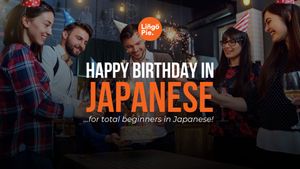
How To Say Happy Birthday In Japanese In 7+ Easy Ways
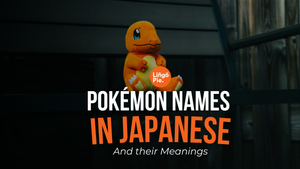
Pokémon names and their meanings in Japanese

6 Books and Textbooks to Learn Japanese

20 Iconic Anime Quotes In Japanese With Their Meanings
Get the secret guide to language learning with tv and music for free, browse posts by popular tags.
Learn Japanese for Travel
Prepare for your next trip with busuu’s japanese travel course. learn essential japanese travel vocabulary and phrases to open new doors.
If you’re planning a trip to Japan, it’s smart to learn Japanese for travel. But where to start? It can be overwhelming to tackle a whole new language!
Fortunately, you’ve come to the right place. In this guide, we’ll take a closer look at why it’s important to learn basic Japanese for travel before you jet off to Tokyo, the best way to learn Japanese, and start to tackle some important Japanese words and phrases for travel.
How to learn Japanese for travel
Learning basic Japanese for travel is actually easier than you might think.
Sure, the language as a whole is considered one of the hardest languages for English speakers to learn, thanks to the three Japanese writing systems and the complexity of formal Japanese and honorifics . But if you’re simply heading to an onsen in Hokkaido for a week, you’re probably not looking to do business in Japanese or read entire novels.
Instead, you can focus on Japanese phrases for travelers and other elements of basic Japanese, which is not nearly as challenging.
Discover the best way to learn Japanese for your next trip
Lessons on your schedule
Learn at your own pace with Busuu! Whether you have a free hour to study or just a few minutes, you can make progress toward your goals with bite-sized lessons designed by experts.
Tackle basic Japanese for travel first
Start learning with Japanese basics in the Complete Japanese Course or focus on the Japanese travel vocabulary you’re most likely to need first with our Japanese Travel Course.
Learn Japanese from anywhere
Study on the go with the Busuu app, and download lessons to learn offline! With Busuu Premium , you can keep learning even when your adventures take you out of WiFi range.
Why learn Japanese before you travel to Japan?
Before taking a closer look at how to learn basic Japanese, you might want to know why you should! After all, learning a language can be tough. You might be wondering what the benefits are of learning Japanese at all and whether it’s worth the bother.
Well, there are many excellent reasons to learn Japanese if you’re heading off to Japan! Learning a language makes your travel experiences so much better. Here are our top 5 reasons you should learn Japanese for travel.
1. Simplify your trip
When you take a Japanese Travel Course ( like this one! ), you’ll learn essential Japanese phrases for travel. The ability to ask for directions, buy train tickets, find a restroom, or order at a restaurant in the local language can make a huge difference in your experience of Japan. When you understand more, you can navigate new places and experiences more smoothly and with less stress.
2. Take roads less traveled
Another good reason to learn Japanese for travel? Many Japanese people simply don’t speak English. It’s not as common to learn English in Japan as it is in other countries that rely more heavily on tourism or that have had long relationships with English-speaking nations. If you don’t speak any Japanese, it may be hard to navigate the country unless you stick to more touristy locations. And what fun is that?
3. Connect with locals
In Japan, a little politeness can go a long way. Even if mastering advanced Japanese grammar isn’t in the cards for you, a few basic Japanese travel phrases – like learning to say yes and no in Japanese or understanding Japanese table manners – can help you better connect with the people you meet on your travels. Learning basic Japanese can help you learn to introduce yourself, ask other people basic questions about themselves, and so much more.
4. Understand more
If you’re heading off to Japan, one of the best things you can do to prepare is learn hiragana and katakana – two of the three Japanese writing systems. While the third system, kanji , can take years to master, hiragana and katakana alone can give you a huge boost when it comes to navigating around Japan. Reading these two syllabaries can help you sound out Japanese menus, signage, and product labels, which can be a huge help when it comes to getting around day-to-day.
5. Get a sense of accomplishment!
The simple truth is, learning to speak a new language and putting it to use can be fun!
Even if your Japanese isn’t perfect by the time the plane lands, it’s thrilling to buy a snack or check into a hotel in a new language and be understood.
Everyone needs a win sometimes! And the local Japanese folks you encounter will likely appreciate the effort you made in learning.
Pro tip : When you go into a store in Japan, you’re likely to hear someone call out, “Irasshaimase!” Find out what it means – along with 17 other Japanese greetings – right here .
In short? Learning to speak Japanese before traveling to Japan is sure to improve your experience!
There are tons of good reasons to learn a little Japanese before you go, and – since you can start learning with Busuu for free – it’s hard to find a reason not to.
Best of all? When you learn with Busuu, you can focus on learning the Japanese travel phrases you’ll need most, right from day one.
Why is Busuu the best app to learn Japanese for travel?
Busuu’s Complete Japanese Course is the perfect entry point to start learning Japanese. When you supplement it with Busuu’s Japanese Travel Course, you’ll learn the basics you need plus most useful Japanese phrases for travel. And if you want to keep learning, once the Travel Course is through, you can work on learning hiragana and katakana, or continue at your own pace from the basics all the way up to Upper Intermediate (B2) Japanese.
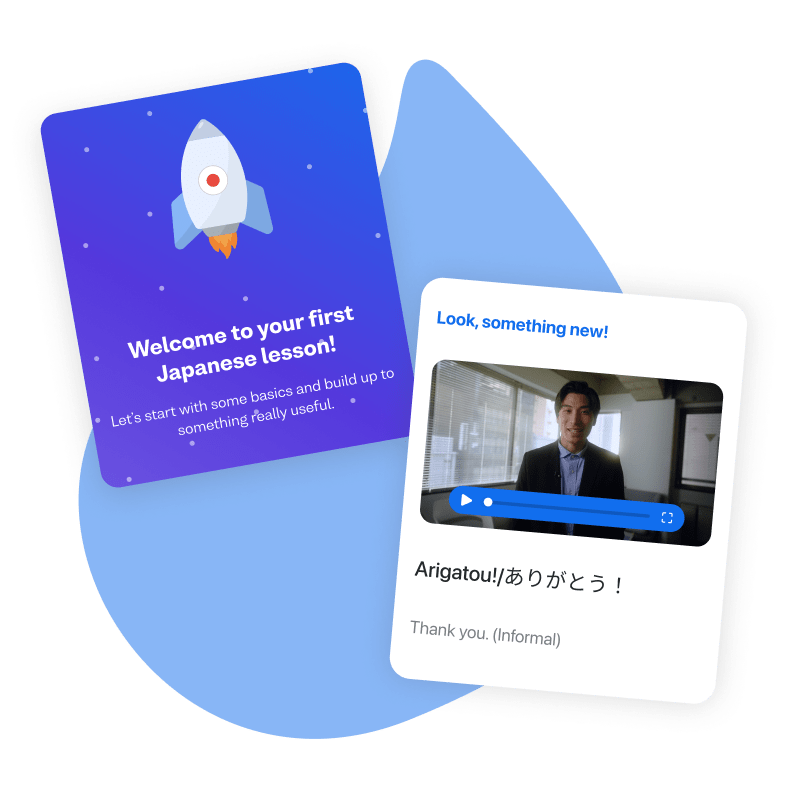
Actually speaking a new language out loud in the real world can be daunting! That’s why Busuu’s courses encourage you to practice speaking Japanese out loud from the first lessons. In Busuu’s Japanese courses, you’ll get exercises that challenge you not just to listen and repeat but to come up with your own answers to prompts based on what you’ve learned. That means you won’t just learn Japanese for travel – you’ll practice actually putting what you’ve learned to use.
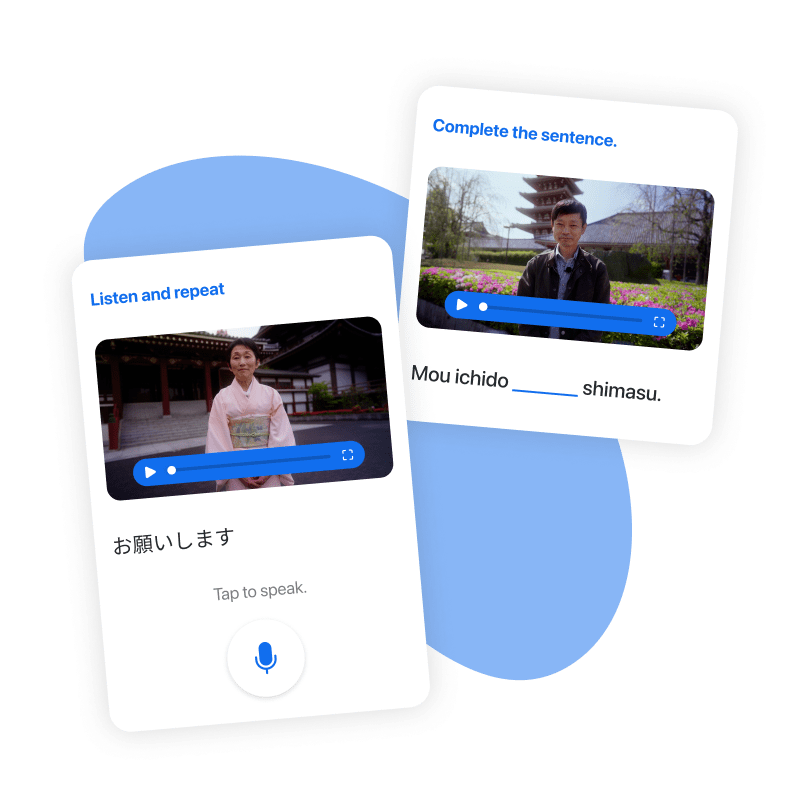
One of the things that makes Busuu the absolute best app to learn Japanese for travel? The Conversations feature! You’ll share some of your exercises with native Japanese speakers on the app for encouragement and feedback. Learning from native speakers can help with your pronunciation, show you how the language is actually used in practice, and lift your confidence so you’re ready to say "konnichiwa" from the moment you land.
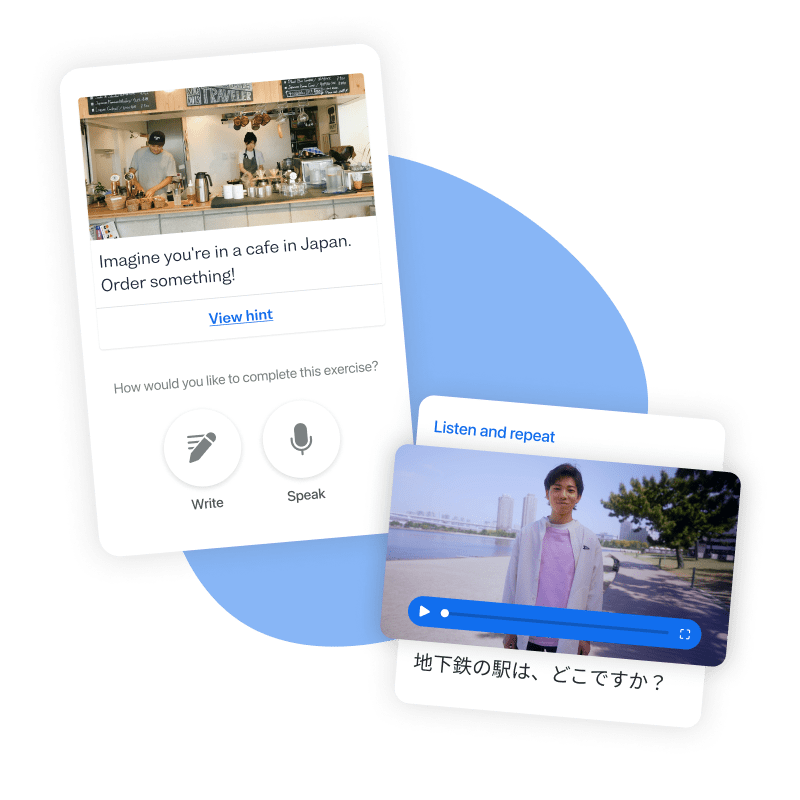
Learn Japanese phrases for travelers
Why not get started right now? Let’s take a look at some of the vocabulary and phrases you’ll learn in your first few lessons with Busuu’s Travel Course!
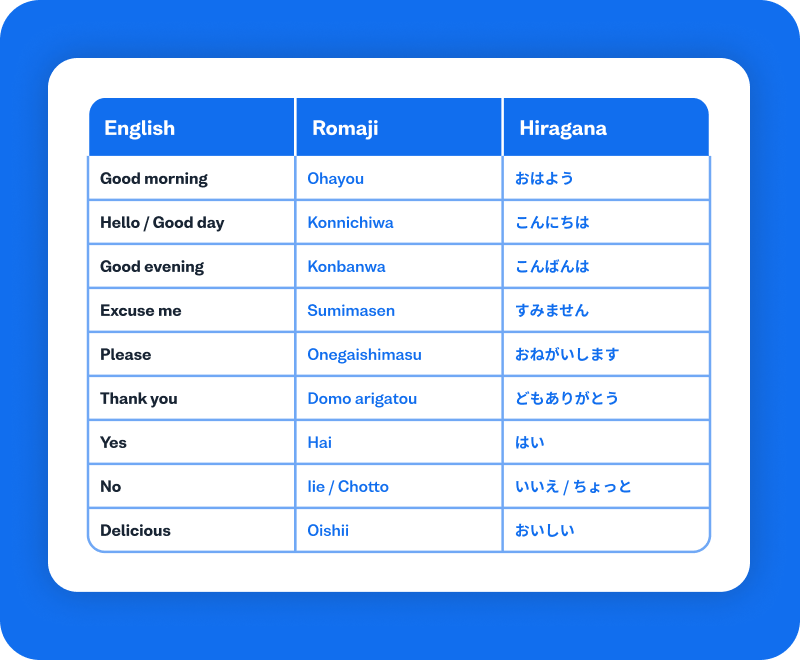
Pro Tip : There are many different ways to say no in Japanese – learn which one to use and when right here .
10 Essential Japanese words for travel
Learn more japanese for travel with busuu premium.
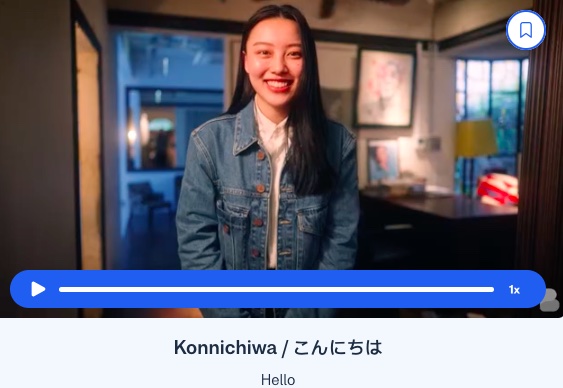
With Busuu Premium, you can set goals with a Study Plan, connect with Japanese speakers through Conversations, and so much more. Premium makes learning to use Japanese travel vocabulary a breeze, so you’ll be saying, Konnichiwa / こんにちは– “Hello!” with confidence to the people you meet on your travels!
3 Basic Japanese phrases for travel
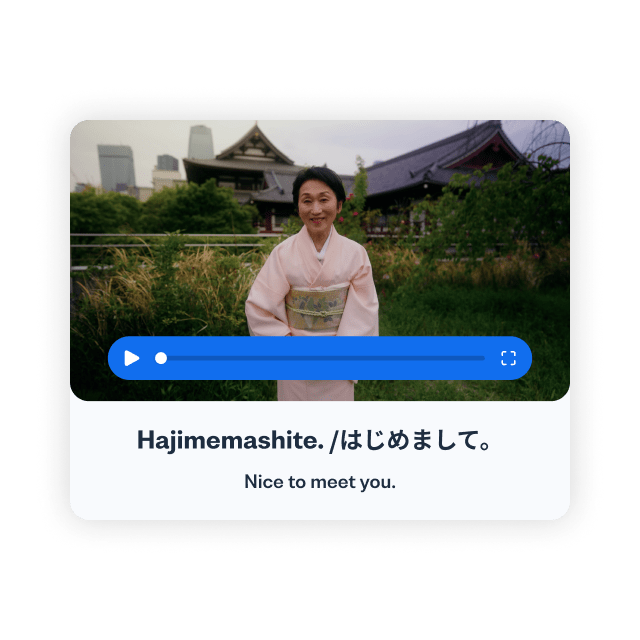
1. Hajimemashite
Hajimemashite (始めまして) is a Japanese greeting that means “Nice to meet you”. We say this phrase when we meet someone for the first time.
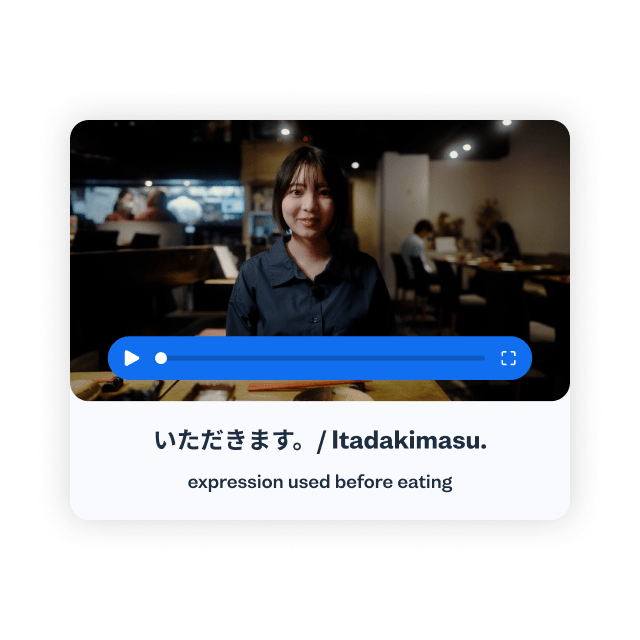
2. Itadakimasu
Taken literally, itadakimasu (いただきます) means, “I humbly receive.” It’s good manners to say this before you eat and is a way to say thank you for the whole preparation of the meal.
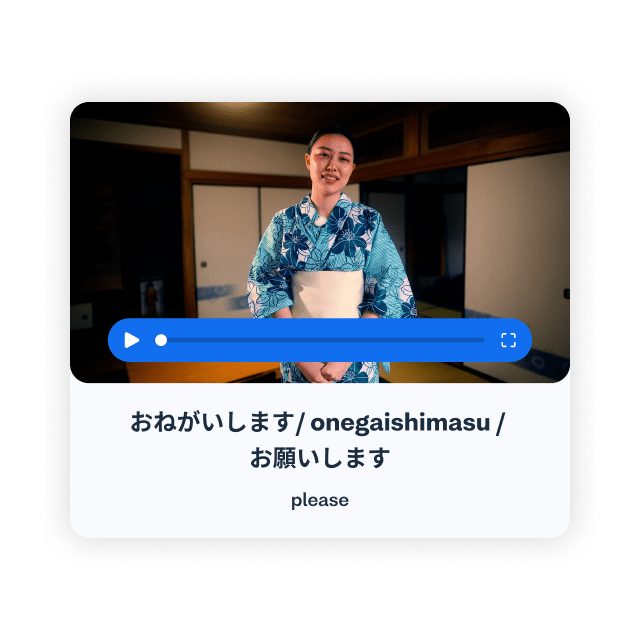
3. Onegai shimasu
Onegai shimasu (お願いします) is a polite Japanese phrase that translates to "please" or "I humbly request." It is commonly used in various contexts to make a request or ask for a favor politely.
And now you’ve learned a few handy Japanese phrases to know when traveling!
Of course, you’ll need to learn a bit more Japanese before you can strike up a conversation in an izakaya or seamlessly order gyoza – but don’t worry, you’ll learn all that and more when you learn via Busuu’s Japanese Travel Course.
Start learning with Busuu
Don’t wait, start to learn Japanese for travel now and discover all the doors that learning Japanese can open for you.
Japanese for Beginners
- Japanese alphabet: The 3 writing systems explained
- Japanese numbers
- Time in Japanese: Your guide to telling time
Japanese Grammar Topics
- Japanese verb conjugation made easy
- 14 Useful Japanese phrases you need to know
- Japanese pronunciation for beginners
New Articles
- 5 Top tips on how to learn Japanese
- 18 Ways to say hello in Japanese like a native speaker
- How to say “No” in Japanese
The Ultimate Guide to Learning Japanese
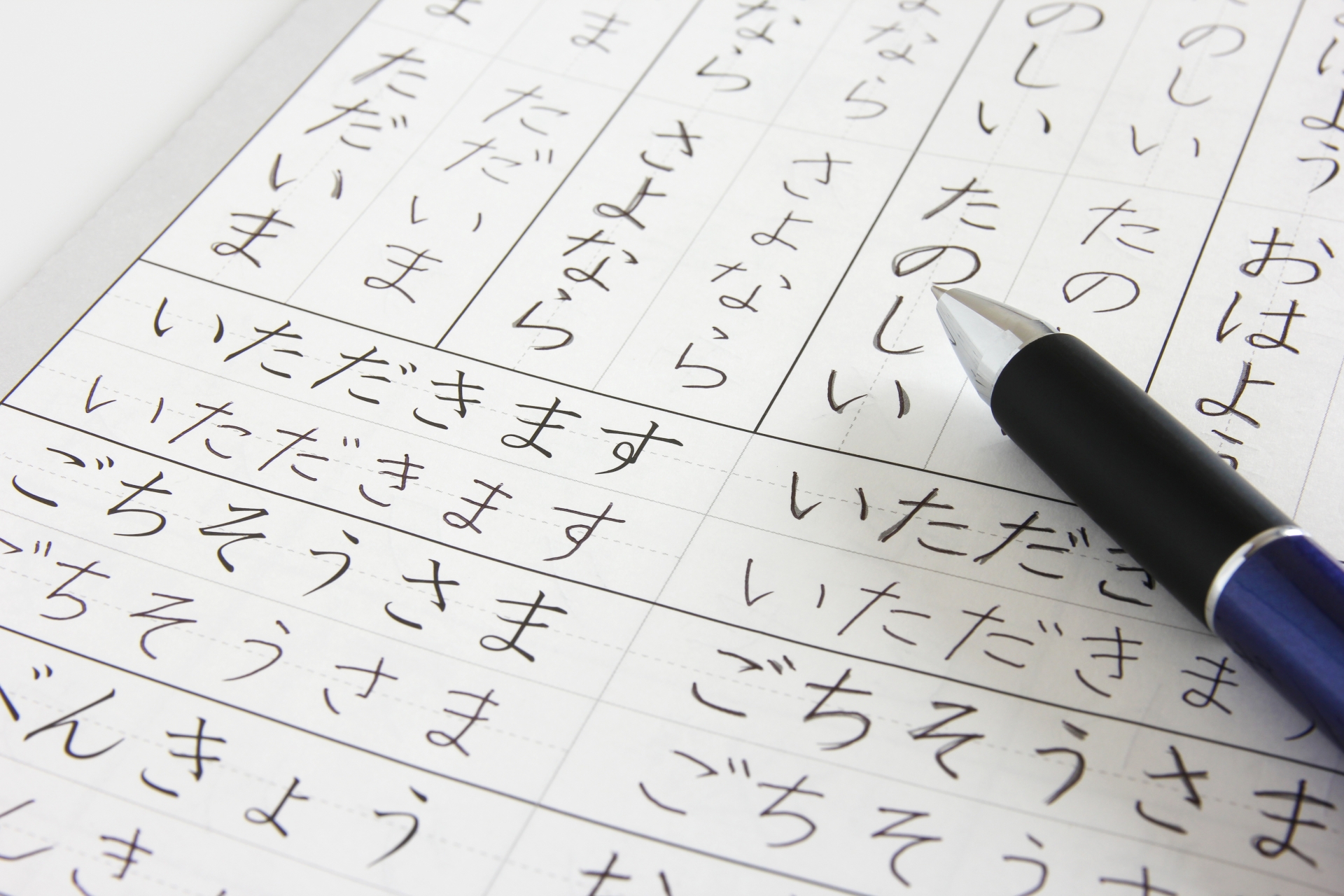
Bryce was born in California, but raised from the age of 3 near Seattle, Washington. He’s been living in Tokyo for about 7 years, and graduated from Temple University, Japan with degrees in economics and international business. He loves traveling of course, but also cooking, snowboarding, some video games as well. His biggest interest is songwriting/music production, more specifically electronic music… (think Skrillex, Marshmello, Daft Punk, etc.) He also has terrible humor as you’ll notice, but he hopes you’ll enjoy it!
This post may contain some affiliate links. When you click through and make a purchase we may receive some commission, at no extra cost to you.
Surely after checking out all of our great recommendations for activities , sightseeing , food , or other opportunities you’re already planning your trip here. Haven’t seen them? Go check them out after you’re done reading this! But if you already have and you’re here to figure out how to get started with learning Japanese, read further and find some great info to help you begin your journey.
1. Why you should learn Japanese
2. basic concepts of japanese, 3. how to start a conversation in japanese, 4. useful japanese phrases for hotels, 5. useful japanese phrases at restaurants, 6. useful japanese phrases for work, 7. interesting facts about the japanese language, 8. best ways to learn japanese, 9. japanese language schools , 10. taking the jlpt(japanese language proficiency test), japan wonder travel tours , other articles you might be interested in.

If you want to live in Japan, it’s no question that being able to speak Japanese will increase almost any aspect of your life there. In some social settings it could be said that fumbling your way through a conversation may be endearing and grant you a bit of attention that the fluent speakers may not get. In general, some endeavors will be a bit easier because a kind individual sympathizes with your lack of fluency and will guide you along. But, these scenarios are truly not sustainable in the long run, and the benefits of understanding and conveying yourself in Japanese far outweigh these temporary graces whether you’re there for 5 weeks or 5 years! Being able to take yourself on adventures, speak with locals, find things off the beaten path, and to be independent overall will significantly increase your enjoyment in Japan . And if you want an impressive job, speaking Japanese at a business level makes it many times easier to land!

Let’s assume that you will be learning Japanese as an English speaker, take note of the primary differences and important points you’ll be focusing on at the beginning. Firstly, compared to just the one alphabet for English, Japanese has three! Shocking, right? Not only do two of them have 46 characters each, but one has a whopping 49,000. Respectively, they are called Hiragana , Katakana , and Kanji . The first 2 are phonetic and don’t exactly carry meaning on their own, while Kanji all have their own meanings, hence the amount. But dont worry- not even native speakers know even close to all of them! To reach a solid level of fluency , you’ll “only” need to know about 2,000. Another thing you may notice right off the bat is the generally backwards or highly rearranged (in comparison to English) sentence structure; words at the end of English sentences often are found at the beginning of Japanese ones. And surely you speak to your boss a bit differently than your best friend, but it’s just a matter of word choice and tone that’s relatively loosely defined. In Japanese, the levels of politeness are very clearly separated/defined and have their own names, such as Keigo which is used for speaking to superiors or customers. Unfortunately, further summarizing it wont yield any significant results, so go ahead and take your first step and check out the basics in more detail !

Keigo is also a good way, if not the main way, to begin interactions or first-time meetings. Basically, it’s common to start things off by being polite to each other- sounds pretty standard for most cultures! So, to maintain this in Japanese, you can do this by selecting the right words for the occasion while also being very mindful of your body language . Shaking hands is much less common (perhaps mainly in international business interactions) and is something to allow a Japanese person to initiate; the common gesture is bowing, as you may already know! While situations can vary, “sumimasen”, which is a very polite and somewhat apologetic way to say “excuse me”. Keep in mind, this is not the direct translation (as are a multitude of other phrases); it is more to convey humbleness and to not be a bother and be polite. This is moreso used if you might have a follow-up statement or question. “konnichiwa” is the standard greeting for hello and is also polite but a bit more friendly. “ohayou” and “konbanwa” are the morning and evening equivalents, respectively. To learn a bit more about how to use these phrases, check out this article that offers more detail!

So, let’s take a look at some examples of phrases in context now that we’ve got some of the essentials noted down! This would certainly be a good opportunity to make use of “sumimasen” to preface your phone call or begin talking to the staff at the front desk! We have a great article that goes in depth about common phrases you’ll want to know before you head to your hotel or Ryokan , but let’s take a look at some examples. Making a reservation can be daunting on the phone, but so many online services bypass this so lets focus on checking in. You’ll notice that Japanese actually uses a lot of words from English and other languages, and this is a good example. To check in you’ll say: “Chekku in wo onegai shimasu”. Japanese uses “I”, “me”, “we” quite a bit less than English, so this phrase literally means “do check in please”. And as you may have already guessed, to check out you would say “Chekku auto wo onegai shimasu”. There are plenty of other phrases you’ll want to know of course so be sure to check out that article!

Moving on to another situation where you’ll be using “sumimasen” even more: dining at restaurants. Why more? Well, it’s the primary word to call the staff over to your table or get their attention to take your order. While in some English speaking countries it may be expected that your waiter/waitress will check in on you periodically, this is often not the case in Japan; if you need something, just call them over! It may seem rude and you’ll be surprised by the stage fright you’ll get when having to shout “sumimasen”, but it’s not rude and you’ll get used to it. Head over to this article to learn more useful phrases for asking where the toilet is, what kind of food is offered, and how to order!

This article goes over a few words and phrases we’ve already touched on so far in a work setting; it’s very useful and if you plan to work in Japan you’ll want to know how to use these, even if they dont require you to know Japanese. One particular phrase we haven’t gone over yet and is arguably the most important for a work setting is “otsukaresama”. This is another Japanese word that has no direct translation, but it is primarily used after the day’s work is done and basically means “you must be tired [from working so hard]”. You can use it for yourself and towards others, and you definitely should!

Where do we begin! Japanese is quite the language; as if 3 alphabets wasn’t enough! Some other notable facts about Japanese that aren’t right in front of your eyes (or ears) can be found here , but let’s touch on a couple. The amount of onomatopoeia is incredible, and surprisingly useful. Despite sentences often omitting “I” and similar words, there are many different ways to refer to yourself and often carry your intended tone. And the most “fun” fact: there are no plurals! But there is a way around this… just wait!
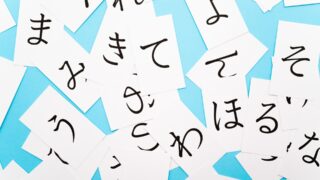
Now that you know a little more about the Japanese language, you are probably wondering how to best learn it. Well there are a number of answers to that question, and it can often depend on what your main objective for learning the language is. Of course everyone will learn differently and have their own best methods for studying, but we highly recommend joining a language school to get the most out of your studies in the shortest period of time. Find out more about the best language schools in the next section.
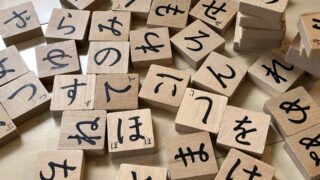
Even though you can find a lot of information and ways to learn Japanese here on our site, you’ll have the best results with your Japanese studies by attending a Japanese language school. This will give you the best opportunity to truly immerse yourself in the language and improve your skills at a rapid rate. There are plenty of great schools around and we have a great list of recommendations for you! Be sure to check them out and find one that suits your needs.
Sign up now: Tokyo Central Japanese Language School Classes

If you have already started studying Japanese, chances are you’ve heard of a test called the JLPT, or Japanese Language Proficiency Test. For those of you who haven’t, it’s the most well known and recognized test for foreigners studying Japanese or looking for work in Japan among other things. The test is given in 5 different levels of difficulty, from N5 to N1, with N1 being the hardest. Find out all about the test and the best ways to study for it with our article here .

Japan Wonder Travel is a travel agency that offers guided tours throughout Japan. From private walking tours to delicious Food and Drink tours, we can help you organize the best tours just for you! If you want to explore Japan and learn more about the history and backstories of each area you are visiting, our knowledgeable and friendly English speaking guides will happily take you to the best spots! In addition, we can provide you with any assistance you may need for your upcoming trip to Japan, so please feel free to contact us if you have any questions or need some help!
▶ Tokyo Tsukiji Fish Market Food and Drink Tour Explore the most lively and popular fish market in Tokyo and try some of the local’s favorite street foods and sake with one of our friendly and knowledgeable English speaking guides!

▶ Tokyo 1–Day Highlights Private Walking Tour (8 Hours) There’s no better way to explore an area than taking a tour with a knowledgeable local guide. You will have the chance to learn about the history and interesting background stories of Tokyo, as well as discover some hidden gems which can be hard to do without a guide.

▶ Mt. Fuji Day Trip Bus Tour from Tokyo Experience the breathtaking views of Mt. Fuji by visiting the highlights of the area on our guided sightseeing bus tour! Departing from Shinjuku in central Tokyo, you can travel comfortably to all of the best spots in the area by bus.

▶ Kyoto Private Full Day Walking Tour On this full-day private tour of Kyoto, you will be able to see the highlights of Kyoto in just one day and at the same time develop a deeper understanding of both the culture of the area and Japan as a whole.

Follow us on Instagram , Facebook , Twitter , and TikTok for more travel inspiration. Or tag us to get featured!
Happy traveling!
Stay informed of the best travel tips to Japan, the most exciting things to do and see, and the top experiences to have with the Japan Wonder Travel Newsletter. Every week we will introduce you to our latest content.

- Popular destinations
- Hidden places in Japan
- Tours and workshop
- Food and drink in Japan
- Itinerary in Japan
- Places to visit in Tokyo
- Food and drink in Tokyo
- Seasonal events
- Tours & workshops
- Tokyo This Week
- Day trip from Tokyo
- Itinerary in Tokyo
- Places to visit in Kyoto
- Food and drink in Kyoto
- Itinerary in Kyoto
- Day trip from Kyoto
- Travel tips
- Accommodation
- Cultural tips
- Transportation
- Tokyo Tours
- Kyoto Tours
- Kimono Rental
- Fukushima Tours
- Mount Fuji Tours
- Tour Package
- Travel Concierge Service
- Media Kit(English/日本語)
Learn Japanese.
Thousands of lessons. no credit card needed., short audio & video lessons for fast and easy learning.

Want to start speaking Japanese from your first lesson? You will! Our lessons take you by the hand and guide you through real Japanese conversations. Our teachers slow down and explain every word and phrase. Just imagine... you’ll finally understand every Japanese word you hear. Learning for travel or love? Want to focus on reading, writing, grammar or culture? You get lessons based on your goals and needs.

Study Tools for Rapid Learning
Worried you won’t remember the words? You get the word lists , slideshows and flashcards that re-quiz you on words so you never forget them. Worried you won’t “understand” native conversations? You get slowed down audio and line-by-line breakdowns so you pick up every word. What about pronunciation? You can practice and compare yourself with natives with voice-recording tools. And that’s just a small taste of what you’re about to unlock!
Personalized Guidance from Your Own Teacher

Yes! You can even learn 1-on-1 with your own Japanese teacher. Want to introduce yourself in perfect Japanese? Or speak up to 3 minutes of conversation within the first week? Your personal teacher will provide you with personal feedback , corrections and answers to any questions you may have via private messenger. Your teacher will also give you a personalized program to follow. (Available with the Premium PLUS subscription)
The journey is the reward
A Basic Guide for Learning Japanese in Japan

If you are planning a trip to Japan, congratulations! You are about to embark on an amazing adventure. Not only is Japan a fascinating country with a rich culture and history, but it is also home to some of the best food in the world.
One thing that can make your trip even more enjoyable is being able to speak Japanese . While not required , being able to communicate with the locals will definitely enhance your experience in Japan.
If interested in learning Japanese while traveling in Japan, read on about 5 easy things you can do to improve your Japanese while traveling in Japan. We’ll also address some related questions you may have about learning Japanese in Japan. Now read on if interested!
Table of Contents
5 easy ways to improve Japanese while traveling in Japan
Being in Japan already exposes you to the Japanese language and culture a lot. While you can easily access translation services to understand everything quickly, it would be a shame if not use the chance to pick up some Japanese phrases and level up your Japanese skills.
So here are 5 easy things you can do while traveling in Japan to increase your Japanese skill. Let’s take a look!
Go on a guided tour
There are many guided tours available in Japan that are conducted in English. While these tours are great for learning about the country and its attractions, they can also be a great opportunity to practice your Japanese.
Attend a Japanese language school
If you are serious about learning Japanese or plan to stay in Japan for a long time, it’s a great idea to attend a Japanese language school to learn Japanese systematically. Besides you can also use online resources like Japanese learning apps for the same purpose.
Attend a Japanese Cooking Class
Japan has a unique food culture that is very different from the west. What’s a better way to learn about a culture than through its cuisine?
In Japan, there are many cooking classes available that cater to foreigners. If you love sushi, ramen, or tempura, don’t miss these opportunities! Not only will you learn how to make some delicious dishes, but you will also pick up some valuable Japanese language skills.
Watch Japanese TV Shows and Movies
While you can do this anywhere in the world with the internet, watching TV channels in Japan is a different experience. Channels like NHK are live 24/7 with entertaining and informative content. You can also pick up useful everyday phrases and vocabulary.
Some of the best Japanese TV shows and movies to watch include “Doraemon”, “Spirited Away”, “Your Name”, and “Your Lie in April”. We also have collected a few great Japanese YouTube channels to learn Japanese if interested.
Join a Language Exchange Program
A great way to practice your Japanese while also meeting new people is by joining a language exchange program. There are many of these programs available online and in major cities across Japan.
By participating in a language exchange program, you will be paired up with a Japanese person who is also interested in learning English. You will then take turns practicing each other’s language.

How much does it cost to learn Japanese in Japan?
The cost of learning Japanese in Japan can vary depending on many factors, such as the type of institution you attend, the length of your program, and your location.
In general, however, you can expect to spend anywhere from a few hundred to several thousand dollars on tuition and other fees. If you are on a tight budget, you can also use language apps like LingoDeer that only cost less than a hundred dollars to get fluent in Japanese by yourself.
Additionally, living expenses in Japan are relatively high, so you will need to factor in the cost of food, housing, and other basic necessities when budgeting for your Japanese language program.
With all of these costs in mind, it is important to do some research and compare different programs before making a decision.
Do you need to know Japanese to travel in Japan?
While knowing Japanese is not a must if you just plan to be in Japan for a short time, learning even a little bit of Japanese before your trip is always a good idea. It will help you better understand the culture and make new friends while you’re here. For example, knowing how to order food in Japanese can save you a lot of time and better enjoy Japanese cuisine. Plus, it’s just plain fun!
If you can’t speak any Japanese, don’t worry. There are plenty of resources available to help you get by. For example, many museums and tourist attractions have English-language signage and pamphlets. And in larger cities, there are often English-speaking staff members working in hotels, restaurants, and shops. You can also use LingoDeer ‘s free travel phrasebook to learn the most travel phrases on the go.
Top places to visit in Japan
When learning a new language, it’s a good idea to get acquainted with the culture and tradition of the country where it is spoken. In Japan, there are many places you can visit to do just that. Here are some of the best:
- Tokyo – As the capital of Japan, Tokyo is a great place to start your cultural journey. There are many museums and temples to visit, as well as countless restaurants and shops.
- Kyoto – Kyoto is considered to be the cultural heart of Japan. It is home to numerous historical sites, such as the Kiyomizu-dera Temple and the Fushimi Inari Shrine.
- Nara – Nara was once the capital of Japan and is now a UNESCO World Heritage Site. It is known for its large number of deer which roam freely around the city.
- Hakone – Hakone is a popular hot spring resort town located in the mountains west of Tokyo. It is a great place to relax and enjoy some of the beautiful scenery Japan has to offer.
- Sapporo – Sapporo is the capital of the northernmost prefecture of Japan, Hokkaido. It is famous for its snow festival, which takes place every February.
- Okinawa – Okinawa is a group of islands located southwest of mainland Japan. It has a unique culture and history, as well as beautiful beaches and clear blue waters.
No matter where you go in Japan, you are sure to find something interesting and unique. So why not start exploring today?
Japanese customs and traditions you should know before visiting
Japan is a country with a long history and rich culture. There are many customs and traditions that have been passed down through the generations. Here are some of the most important ones to be aware of:
- Bowing – Bowing is a way of showing respect in Japanese culture. When you meet someone new, it is customary to bow to them. The deeper the bow, the more respect you are showing.
- Slippers – In Japan, it is not considered polite to walk around inside someone’s home with your shoes on. Instead, you should take them off and wear slippers. You will often find slippers near the entrance of homes and businesses.
- Taking Off Your Shoes – In addition to wearing slippers inside, you should also take your shoes off when entering places such as temples and shrines. This is done out of respect for the deities that are worshipped there.
- Gift Giving – Gift giving is an important part of Japanese culture. When you are invited to someone’s home or given a gift, it is customary to give one in return. Gifts are usually wrapped in beautiful paper and often include items such as food, clothes, or books.
- Tattoos – Tattoos are generally seen as taboo in Japan. This is because they were once associated with criminals and the yakuza (Japanese mafia). As a result, many public places such as pools, hot springs, and beaches do not allow people with tattoos to enter.
These are just a few of the many customs and traditions you will encounter in Japan. By being aware of them, you can avoid making any cultural faux pas during your visit.
How to learn the Japanese lettering system
One of the first things you will need to learn when studying Japanese is the lettering system. There are three different scripts used in Japanese: Kanji , Hiragana , and Katakana .
Kanji are the most complex of the three scripts and represent whole words. They are typically used for nouns, adjectives , and verbs. Hiragana and Katakana are both phonetic alphabets that represent individual sounds. Hiragana is used for native Japanese words, while Katakana is primarily used for foreign words.
It is important to learn all three scripts in order to be able to read and write in Japanese. However, if you are just starting out, you may want to focus on Hiragana and Katakana first. Once you have a basic understanding of these, you can then start learning Kanji.
There are many resources available to help you learn the Japanese lettering system. You can find books, websites, apps, and even podcasts that will teach you everything you need to know. So what are you waiting for? Start learning today!
How to pronounce Japanese words
One of the hardest things about learning Japanese is understanding its pronunciation . This is because there are many sounds in Japanese that do not exist in English.
In addition, the way words are written in Japanese does not always match the way they are pronounced. For example, the word for “tree” is written as 木 (ki), but it is pronounced as “ko”.
The best way to learn proper pronunciation is to listen to native speakers and imitate their speech. There are also many helpful resources available online, such as pronunciation guides and audio files.
With a little practice, you will be able to pronounce Japanese words like a native speaker in no time!
Is Learning Japanese Worth It?
Learning Japanese can be a challenging but rewarding experience. It will open up a whole new world of opportunity and allow you to appreciate the rich culture and history of Japan.
If you are dedicated and willing to put in the effort, learning Japanese is definitely worth it! So what are you waiting for? Start learning today. Stay safe and have a good one, folks!
Published by Guest Author
View all posts by Guest Author
Leave a comment Cancel reply
Discover more from lingodeer.
Subscribe now to keep reading and get access to the full archive.
Type your email…
Continue reading
101 Basic Japanese Words and Basic Japanese Phrases for Travel in Japan

Elaina Robbins
Travel in Japan is the ultimate goal of many Japanese students. Not only is it a fascinating and eye-opening experience; it’s a great opportunity to practice using basic Japanese words and basic Japanese phrases in a setting other than the classroom.
Having a selection of basic Japanese phrases ready to use as you travel in Japan will help you get around and improve your pronunciation as you interact with native speakers. After all, there is no better way to learn any new language than practical application!
We have assembled a list of practical, basic Japanese phrases that will make your journey through this ancient culture even more educational and memorable. Speechling has many tools to help with comprehension and pronunciation as you prepare for your trip and commit these basic Japanese phrases and words to memory.
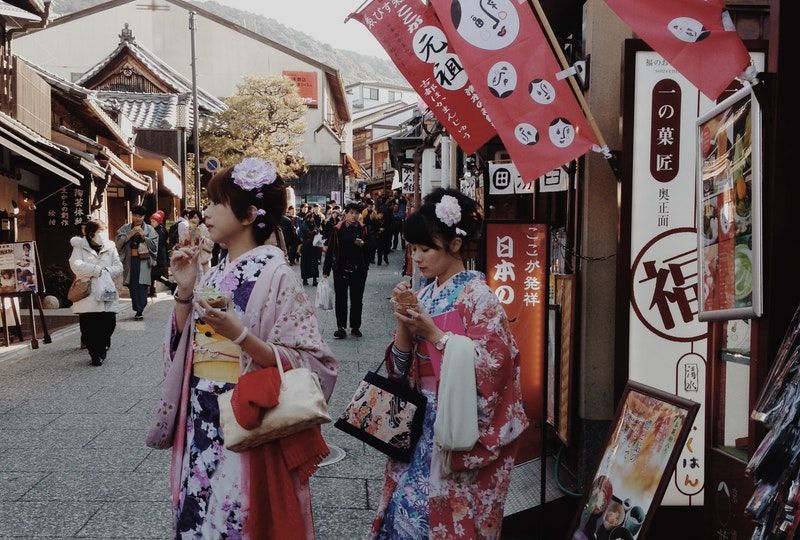
These basic Japanese words and phrases allow you to greet people and interact throughout the day. As you use them, remember what you’ve learned about the high premium placed on respect in this culture! When in doubt, err on the side of too much deference.
- Hello: Konnichiwa. こんにちは
- Good morning: Ohayo- gozaimasu. おはようございます
- Good afternoon: Konnichiwa. こんにちは (yes, this is the same as “hello”!)
- Good evening: Konbanwa. こんばんは
- Goodbye: Sayo-nara. さようなら
- Please: Kudasai. ください
- Thank you: Arigato- gozaimasu. ありがとうございます
- How are you?: Ogenki desu ka? お元気ですか?
- Yes: hai. はい
- No: EE-eh. いいえ
- My name is __ : Watashi no namae wa __ desu. 私の名前は __ です
- What’s your name?: Onamae wa nan desu ka? お名前は何ですか? (おなまえは なんですか?)
- It’s nice to meet you: Hajimemashite. 始めまして (said at the beginning of a conversation, not when parting)
- Sorry: Gomen-nasai. 御免なさい
- Excuse me: Sumimasen. すみません
- Where is the?: __ wa doko desu ka? __ はどこですか?
- I don't understand. Wakarimasen. わかりません
- I do not speak Japanese: Nihongo o hanashimasen. 日本語を話しません (にほんごを はなしません)
- Do you speak English?: Ehgo o hanashimasu ka? 英語を話しますか?(えいごを はなしますか?)
- Please repeat that: Mo- ichido itte kudasai. もう一度言ってください (もういちど いってください)
- Please speak slowly: Yukkuri hanashite kudasai ゆっくり話してください (ゆっくり はなしてください)
- Would you please help me?: Tetsudatte moraemasuka? 手伝ってもらえますか? (てつだって もらえますか?)
- I want to go: (Koko) ni ikitai no desu. (ここ)に行きたいのです ((ここ) に いきたいのです)
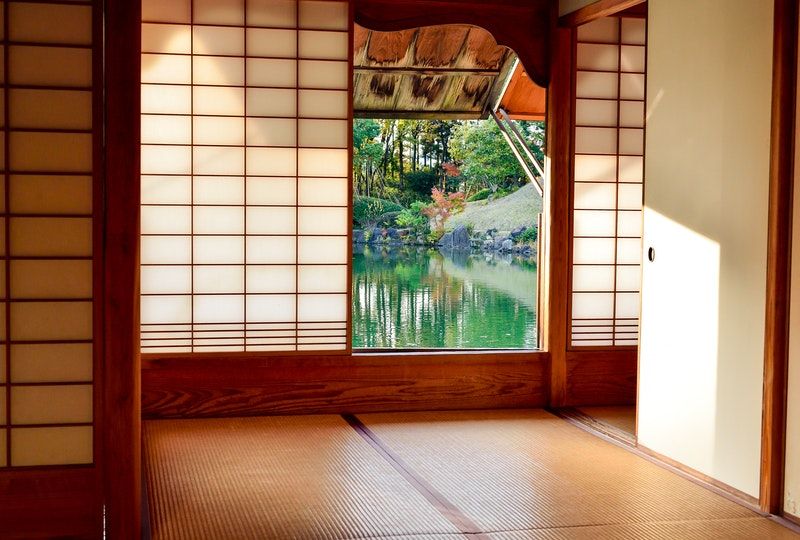
Transportation and Lodging
As in most countries, Japanese transit and hotel staff seem to have a language of their own. Do some reading online before your trip, just to acquaint yourself with some of the quirks you may encounter in Japanese hotels (for example, you’re expected to tidy your own hotel room). Here are some basic words and phrases that will be helpful.
- How much is a ticket to __ ?: ___ madeh ikura desu ka? ___ までいくらですか ?
- A ticket to__, please: ___ madeh ichimai onegaishimasu. __ まで一枚お願いします
- Where does the train/bus go?: Kono densha/basu wa doko yuki desuka? この(電車/バス)はどこ行きですか ?
- Where is the train/bus to (a location)?: ___ yuki no densha/basu wa doko desuka? ___ 行きの(電車/バス)はどこですか?
- Does this train/bus stop in __ ?: Kono densha/basu wa ___ ni tomarimasuka? この(電車/バス)は ___ に止まりますか ?
- When does the train/bus for ___ leave?: ___ yuki no densha/basu wa nanji ni shuppatsu shimasuka? ___ 行きの(電車/バス)は何時に出発しますか?
- When will the train/bus arrive in __ ?: Kono densha/basu wa nanji ni ___ ni tsukimasuka? この(電車/バス)は何時に _____ に着きますか?
- Do you have rooms available?: Aiteru heya arimasuka? 空いてる部屋ありますか?
- How much does lodging for one/two cost?: Hitori/futari-yō no heya wa ikura desuka?一人/二人用の部屋はいくらですか?
- Is the room Japanese/Western style?: Washitsu/yōshitsu desuka? 和室/洋室ですか?
- Does the room come with __ ?: Heya wa ___ tsuki desuka? 部屋は ... 付きですか?
- May I see a room first?: Heya o mitemo ii desuka? 部屋を見てもいいですか?
- I'll take it: Kore de ii desu. これで良いです
- I would like to stay for ___ night(s): ___ haku onegaishimasu. ___ 2泊お願いします
- Do you know another place to stay?: Hoka no yado wa gozonji desuka? 他の宿はご存知ですか?
- What time is breakfast/supper?: Chōshoku/yūshoku wa nanji desuka? 朝食/夕食は何時ですか?
- Please wake me at___: __ ni okoshite kudasai.__ に起こしてください
- I would like to check out: Chekku auto (check out) onegaishimasu. チェックアウトお願いします

As soon as you walk into a retail business or restaurant in Japan, you will be greeted with, “Irrashai maseh” (いっらしゃいませ)! It is a general welcome by employees to all customers, so all you need to do is nod in acknowledgement, if anything. You’ll probably hear the following phrases from the store clerk as you shop:
- Are you looking for something?: Nani ka osagashi desu ka? 何かお探しですか?
- Is that everything?: Ijyou de yoroshii desu ka? 以上でよろしいですか?(いじょうで よろしいですか?)
- Here you go: Hai, douzo. はい、どうぞ
Your responses may include phrases such as: 45. I would like this item: Kore o onegai shimasu. これを おねがいします 46. I would like one of those: Sore o hitotsu onegai shimasu. それを一つお願いします (それを ひとつ おねがいします) 47. How much does it cost?: kore wa ikura desu ka?これは いくらですか? 48. Do you accept a credit card?: Kureditto kaado (credit card) o tsukaemasuka? クレジットカードを使えますか?

Dining out provides lots of opportunity to practice your Japanese, but it is also an activity that can be quite different in Japan. Do some research before you go to learn as much as you can, and then enjoy Japan’s world-famous food!
- Space for one person/two people, please: Hitori/futari desu. 一人/二人です.
- Please bring a menu: Menu o kudasai. メニューを下さい。
- Is there a house specialty? O-susume wa arimasuka? お勧めはありますか?
- Fixed-price meal: Teishoku. 定食
- A la carte: Ippinryōri. 一品料理
- Breakfast: Chōshoku. 朝食
- Lunch: Chūshoku. 昼食
- Light meal: Keishoku. 軽食
- Supper: Yūshoku. 夕食
- Beverage: Nomimono. 飲み物
- I want a dish containing __ : __ ga haitteru mono o kudasai. __ が入ってるものを下さい。
- Chopsticks: ohashi. お箸
- It was delicious: Oishikatta desu. おいしかったです
- Excuse me: Sumimasen. 済みません
- May I have the check, please? Okaikeh onegai shimasu. お会計お願いします
- Do you serve alcohol? Osakeh arimasuka? お酒ありますか?
- Sake: Nihonshu. 日本酒
- Japanese liquor: Shōchū.焼酎
- Whiskey: Wiskii. ウイスキー
- Water: Mizu. 水
- Club soda: Sōda: ソーダ
- Coffee: Co-hii. コーヒー (こーひー)

Time and Numbers
You may encounter military time in Japan, or the terms “gozen” 午前 for a.m. and “gogo” 午後 for p.m. Check out this resource for some additional explanation; this topic can get tricky. Also, remember that the Japanese readings “yon” and “nana” are often used for 4 and 7 due to superstition about the translation (“shi,” used in another reading for both those numbers, translates as death).
- Six o'clock a.m.: Asa rokuji. 朝6時
- Noon: Shōgo. 正午
- One o'clock p.m.: Gogo ichiji. 午後1時
- Midnight: Yoru jūniji: 夜12時
- ___ minute(s): ___ foon or poon. 分
- ___ hour(s): ___ jikan. 時間
- ___ day(s): ___ nichi. 日
- ___ week(s): ___ shūkan. 週間
- ___ month(s): ___ kagetsu. ヶ月
- ___ year(s): ___ nen. 年
- 4: Yon or shi. 四
- 7: Nana or shichi. 七
- 8: Hachi. 八
- Now: Ima. 今
- Later: Atodeh. 後で
- Before: Maeh ni. 前に
- Morning: Asa. 朝
- Afternoon: Gogo. 午後
- Evening: Yūgata. 夕方
- Night: Yoru. 夜
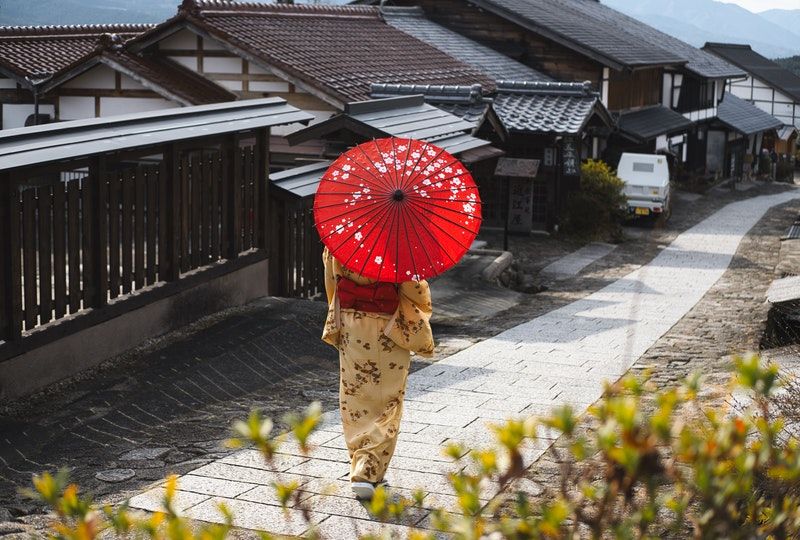
Words or Phrases to Avoid
These phrases can convey disrespect. You don’t want to offend anyone, especially people you don’t know, so make sure to avoid these terms, even if you hear them being tossed around in your favorite anime.
- Doing something untimely: Manuke. まぬけ
- Drop dead!: Kutabare. くたばれ
- Move out of the way!: Doke. どけ
- Noisy!: Urusai.うるさい
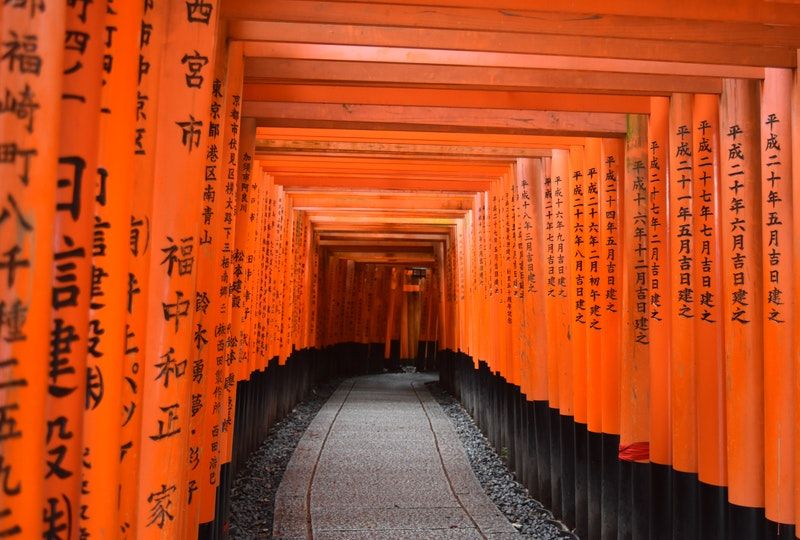
Enjoy Your Trip!
As you prepare to travel in Japan, use Speechling’s pronunciation tools to master the phrases provided on this list. Review The Top 5 Pronunciation Mistakes English Speakers Make in Japanese Lessons , too, and then the Top 100 Basic Japanese Words for Beginners for additional words that weren’t included in this list. Native speakers will appreciate the effort you took to use Japanese words and phrases, even if they aren’t perfect!
Speechling is a nonprofit app and website that combines human coaching with technology to improve your foreign language speaking.

14 recommended reads for those traveling to Japan
For anyone planning a trip to japan or looking for some armchair travel.
- BY Holly Wielkoszewski
- IN Book Lists , Books & Reading , Literary Tourism
- 83 Comments | Comment

Japan is a dream destination for so many travelers, due to its incredible food, fascinating history, and unique culture. I was fortunate enough to spend two months traveling in Japan in 2023, and since then I’ve frequently returned to the country via the pages of a book. Today I’m excited to share a selection of my favorite books set in Japan with you!
Japan has a flourishing domestic publishing industry and a growing list of globally recognized authors like Yu Miri ( Tokyo Ueno Station ), Banana Yoshimoto ( Kitche n ), and Haruki Murakami ( 1Q84 ). If you do find yourself journeying to Japan soon, you’ll want to make sure that Tokyo’s Jimbōchō Book Town is on your itinerary. With everything from rare book collections to a bookshop devoted to cats, it’s a reader’s dream destination. In the meantime, keep an eye out for your closest branch of the global Japanese bookstore Kinokuniya , which has locations across the U.S. and around the world.
Yet despite their love of books, Japan’s literary scene remains less accessible to western readers than that of many other countries, in part due to the challenges of translation. Only a small number of titles are translated from Japanese to English each year: the Publisher’s Weekly Translation Database listed 14 titles from Japan in 2023, although this notably did not include manga (Japanese comics or graphic novels.) Many of the books I discovered while scouring the library and bookstores for Japanese reads that fit my tastes were simply unavailable or much more expensive than I was willing to pay. For example, I hope to read Kayano Shigeru’s Our Land Was A Forest: An Ainu Memoir someday but it sells on Bookshop for $207 and is $36 to rent on Kindle!
However, with the growing success of Japanese authors and interest in English translations of their books, I’m excited to see more and more Japanese titles in translation on American bookshelves. This 2022 interview with a publisher in Japan helped me understand some of the more recent trends in publishing and translation.
If your travels don’t take you to Japan anytime soon, you can still immerse yourself in the Japanese experience through the words on the page. Today, I’m sharing two non-fiction picks that are on my all time favorites shelf, along with an assortment of fiction titles from Middle Grade to philosophical thriller and everything in between. I’d love to know your favorite books that are set in Japan or by Japanese authors. Please leave a comment and share your suggestions with me and the rest of your fellow armchair travelers!
Literary Tourism: Japan
Some links (including all Amazon links) are affiliate links. More details here .

The Aosawa Murders

Tokyo Ever After

Across the Nightingale Floor (Tales of the Otori #1)

Fault Lines

Shōgun (The Asian Saga Part One)

Water, Wood, and Wild Things: Learning Craft and Cultivation in a Japanese Mountain Town

Kokoro: Japanese Wisdom for a Life Well Lived

Just Enough: Lessons from Japan for Sustainable Living, Architecture, and Design

Red Winter (Red Winter Trilogy #1)

Kiki’s Delivery Service

Sweet Bean Paste

Four Seasons in Japan

The Kamogawa Food Detectives

The Easy Life in Kamusari (Forest #1)
Do you have any favorite books set in or about Japan? Please share in the comments.
P.S. 14 recommended reads for those traveling to South Korea , 11 recommended reads for those traveling to Spain , and more literary tourism .
About the author

Holly Wielkoszewski is our What Should I Read Next Media Production Specialist. Her go-to genres are Fantasy and Sci-Fi. You can find Holly on Instagram @hollyfromthebigsky .

83 comments
Pachinko by Min Jin Lee – The book was one of the top 10 fiction books of 2017 on the New York Times list and a finalist for the National Book Award. It was praised as an accurate historical account of the lives of a downtrodden people, forced from their homeland and exiled as Korea and Japan were torn apart by war.
Thanks for the recommendation, Carole – I love Pachinko, too, and that’s a great addition to this list!
Pachinko is primarily a story about Korea and Koreans who are displaced in Japan. I would not recommend that novel as “Japan Literary Tourism”.
Thank you for this list. I’ve always wanted to visit Japan and never will, but I love going there in my imagination. BTW I would also recommend ‘Miss Happiness and Miss Flower’ and ‘Little Plum’ by Rumer Godden. They are children’s books but will appeal to the little girl in all of us.
Thank you Cheryl, I haven’t read either of those and will have to go check them out!
I got a chance to spend 2 weeks in Japan last fall and it was beautiful. Kyoto, Nara, Fukui prefecture- I’m glad we went into Osaka and saw smaller towns instead of Tokyo. Maruzen bookstore in Kyoto had a large English language section. I really liked the Devotion of Suspect X and Strange Weather in Tokyo.
Laura, isn’t it a beautiful country? I haven’t actually read Strange Weather in Tokyo yet so thank you for reminding me to put it on my priority TBR 🙂
I loved Pico Iyer’s The Lady and The Monk. The non-fiction book revolves around a budding relationship, as he falls for both a woman and Japan itself. His words paint lovely pictures of Kyoto and Japanese culture.
I’ve heard great things about this title, Angela—thanks for sharing it here!
The Roads to Sata by Alan Booth follows the author’s walk from one end of Japan to the other and is both insightful and funny. Gaijin is another by James Clavell, this one set in the 1860s. He is top notch on the history and culture, as well as being a compelling story teller.
Andrea, I bought The Roads to Sata but haven’t had the chance to read it yet! I look forward to it!
A friend of mine who many years ago lived in Japan teaching English recommended one to me recently and I really enjoyed it. A Guest Cat by Takashi Hiraide.
Oh, I haven’t heard of this one. I love how much cats feature in Japanese fiction! Thanks for the recommendation.
For some reason I found myself reading a lot of japanese books this year. If you like cats, Hiro Arikawa’s books The Travelling Cat Chronicles and The Goodbye Cat were great reads. There are some themes of dying, but they were treated respectfully and sensitively. If you like mysteries, Susan Spann’s series the Shinobi mysteries was also a great read. The main characters, Hiro Hattori and Father Matteo solve whatever mystery comes their way, usually at risk to their lives. It is set in feudal Japan and features the Shinobi/ninja culture. If you loved Crouching Tiger, Hidden Dragon back in the day, this might be for you!
I loved the Traveling Cat Chronicles! I’ll definitely check out the Shinobi mysteries- those sound right up my alley. Thanks for sharing!
Excellent, just added the Shinobi mysteries to my Storygraph. Thanks Susan!
My book club recently read ‘What you are looking for is in the library’ by Michiko Aoyama (translated by Alison Watts). It is a lovely story about this librarian in Tokyo who senses what people are searching for and recommends the right book to help them find it. The book follows five people as they are all at a crossroads in their life.
I second this recommendation and would add ‘Before the Coffee Gets Cold’ for a similarly satisfying blend of wistfulness and hope.
I’ve seen this one everywhere, Kelly, and it sounds fantastic!
I really enjoyed What You Are Looking For Is In the Library!
This stunner by Oswald Wynd. There was also a wonderful tv adaptation by either PBS or BBC. The Ginger Tree
Yes! I thought of that one, too!
Oh, I will have to check that out. Thank you Beverly!
I’m currently listening to Abroad in Japan and laughing out loud in various parts. The narrator is the author and took part in the JET program where he taught English in a Japanese high school. He is British and has that wonderful dry sense of humor that I love about my British friends and colleagues.
I always enjoy British humor – this sounds like a great audiobook option!
Thank you so much for these books! I lived in Japan for 3 years and while I absolutely love manga, here are some other books about Japan or by Japanese authors that I also adored. The Road Through Miyama by Leila Philip (author’s memoir about her apprenticeship in a Japanese Pottery studio), Before the Coffee Gets Cold book series by Tochikazu Kawaguchi (short stories set in contemporary Tokyo around a cafe that can send you back in time), The River Ki and The Doctor’s Wife by Sawako Ariyoshi (both are about women in Japan from around the Meiji era and are classics in Japanese Literature), Kokoro by Natsume Soseki (a book exploring loneliness, love and friendship in Meiji Japan, though TW suicide is involved), and The Traveling Cat Chronicles by Hiro Arikawa (about a young man who adopts a cat and their travels together). I’ve found a lot of Japanese stories to be bittersweet and sad because that’s a huge part of their culture so many of these books have that.
And while a lot of people here probably don’t read much Manga, Barakamon by Satsuki Yoshino is a manga series about a young Tokyo calligrapher exiled to a rural island in southern Japan for punching a critic and learns about Rural Life. It’s cute and comedic and there’s a lot of Southern Japanese cultural history. Himawari House by Harmony Becker is a graphic novel about 3 girls who came to Japan to study abroad (one from the States, one from Korea, and one from Malaysia) and their year living together in a boarding house.
Putting the Manga on my TBR – thank you!
Thank you for these wonderful recommendations, Jen—by TBR just got a lot longer!
Thank you for this excellent list. Two additional books I enjoyed in anticipation of my spring trip to Japan were Convenience Store Woman by Sayaka Murata, and Diary of a Void by Emi Yagi.
Yes! Two great suggestions, Lisa. I will admit that Convenience Store Woman wasn’t to my tastes, but I know so many readers love that story!
I also enjoyed those two books.
These are two of my favorite books from Japan! Thanks for mentioning them. ☺️
We just visited Japan for the first time in June, and I read a lot of Japanese books before, during, and after our trip. My favorite by far was What You Are Looking for is in the Library. I love a weird little Japanese book. 🥰
So glad you were able to make that trip, Lee!
50 Words for Rain is a fabulous book for Japanese culture. This list is so timely as I am travelling to Japan in a few weeks.
Have an amazing trip, Kristen!
Just a friendly reminder from a small town librarian that that expensive book you want to read is probably available for free through your local public library. I live in Minnesota and it’s available through our state wide system. Thank you for this list!
Thanks Kim – always a great reminder. I recently moved and just got my new library card so I will run this down!
Nobel Prize winner Yasunari Kawabata- I love all of his books. Haruki Murakami Hiromi Kawakami Teru Miyamoto’s KINSHU Autumn Brocade Plum Wine by Angela Davis-Gardner The Commoner by John Burnham Schwartz Memoirs of a Geisha Arthur Golden
Thank you for these additions, Rebecca!
I loved Lady Joker by Kaoru Takamura. It is a 2 book series. I believe it is based on a real crime that was never solved. It’s long but very good.
Oh, that sounds fascinating. Thanks Becky!
This is perfect, I’m taking a trip to Japan in a couple months! I just added a number of books to my TBR from this post and the comments. I love that that so many of the (few) books translated from Japanese into English involve cats and books.
Over the past year I’ve been making an effort to read books set in Japan and by Japanese authors. Many have already been mentioned, but here is my list of recommendations:
Really Liked The Housekeeper and the Professor, Yono Ogawa Sweet Bean Paste, Durian Sukegawa The Travelling Cat Chronicles and The Goodbye Cat, Hiro Arikawa Convenience Store Woman, Sayaka Murata What You Are Looking for is in the Library, Michiko Aoyama The Guest Cat, Takashi Hiraide Confessions, Kanae Minato (dark and disturbing but well crafted) Diary of a Void, Emi Yagi
Liked Tales from the Cafe (series), Toshikazu Kawaguchi The Kamogawa Food Detectives, Hisashi Kashiwai The Cat Who Saved Books, Sosuke Natsuwaka The Turtle House, Amanda Churchill Days at the Morisaki Bookshop, Satoshi Yagisawa
I hope you have a wonderful trip, Melanie. Thanks for sharing all of your suggestions!
Agreed on Shogun! I’ve read it before 2 of my trips to Japan (and many other times) and it never disappoints.
I also just started Butter by Asako Yuzuki which I haven’t gotten far into yet but it’s great so far.
If you’re into comics/Manga there are so many that would be a fun primer for traveling to Japan – whether for the nerd culture or the tourism. There is so much background ambiance that is distinctly Japanese that you unconsciously learn – there was so much I recognized about culture, etc once I was there!
I based quite a few day trips off of Laid Back Camp – a Manga/anime about a group of girls who have a camping club and they go on countless beautiful trips to see Mount Fuji, etc. I also learned about the seasonal and regional food specialties to eat/get souvenirs (which is a must do if you ever get to travel there). There’s so much subject matter out there – basically you can find a subject you’re interested in and there is a Manga for it 🙂
Keren, thanks for the Manga suggestions. That’s a genre I’ve not yet explored and Laid Back Camp sounds like a great entry point.
Earlier this summer I read The Housekeeper and the Professor by Yoko Ogawa — a very sweet story about friendship and memory that also explores the wonder and weirdness of math and numbers. A bonus for me was learning a bit about Japanese professional baseball.
This one is definitely on my list, Elise! Thanks so much.
My family and I are going to Japan in October, so this is a timely list. We’ll have to add the bookstores to our Tokyo itinerary.
Yesterday I read The Hole by Hiroko Oyamada, a short Alice-in-Wonderland-type mindbender set in small-town Japan. I enjoyed the insights into Japanese culture. In addition to many books mentioned in the post and comments, I hope to read Pico Iyer’s A Beginner’s Guide To Japan before our trip.
Have a wonderful trip, Shauna!
Being a big fan of historical fiction, I loved Shogun. A more recent read that I very much enjoyed was Fifty Words for Rain, by Asha Lemmie.
Colleen, I’m so glad Shogun was a good pick for you, too.
Oh yeah! I read Shogun back in the day and fell in love with Japan, the language, the culture, everything! Shogun is responsible for it all! And, wait, you mention the 2024 series, but what about the original?? With Richard Chamberlain and Yoko Shimada?? Soo good. I memorized some of the Japanese dialogue (we learned right along with Richard Chamberlain) and I remember it to this day!
Thank you for your list, I wrote down several to look for. After Shogun, I found very few books about Japan, which included: Gaijin by Clavell, Japanese Inn by Oliver Statler, The Lovely World of Ricki-San by Allan Bosworth Sayonara by James Michener Before the Blossoms Fall by Agnes N Keith ~~~None written by Japanese! Since then, Memoirs of a Geisha by Arthur Golden Geisha, A Life, by M. Iwasaki Before the Coffee Gets Cold by T. Kawaguchi Fifty Words for Rain by Asha Lemmie Convenience Store Woman by S. Murata Chronicles of a Travelling Cat by H. Arikawa Pachinko by Min Jin Lee ~~But these are the ones I enjoyed best (after Shogun!): Tales for the Time Being by Ruth Ozeki Japan took the J. A. P. out of me! by Lisa Fineberg Cook The Devotion of Suspect X by Keigo Higashino and Fault Lines, that you listed!
Tales for the Time Being by Ruth O
I’ve not seen the original, Suzy, but now I think I need to!
I agree with another commenter that Diary of a Void by Emi Yagi is a unique and quick read. It offers a fascinating window on what it’s like to be a woman in the workplace in Japan. The Cat Who Saved Books by Sosuke Natsukawa is charming, too.
I need to read both of these, so many have suggested them. Thanks for sharing, Paige!
My son has been living and working in a small town, Utsunomiya, about 100km north of Tokyo. He loves it. This has aroused my interest in Japanese literature. These are some of the books I’ve enjoyed: 1. The Bookshop Woman, by Nanako Hanada – Nanako works at the eccentric Village Vanguard Bookshop in Tokyo. As Nanako’s life falls apart, reading books is the only thing giving her life. 2. Days at the Morisaki Bookshop, by Satoshi Yagisawa – A young woman discovers the joy of reading. 3. What I Talk about when I talk about Running, by Haruki Murakami- part memoir, part training log.
Thanks so much for the books you have recommended – There look like some great reads there. Take care and keep up the great work.
Thanks so much Mark, glad you enjoyed and appreciate your recommendations as well!
What You Are Looking for is in the Library! One of my top books. So charming.
I loved reading Memoirs of a Geisha before visiting Kyoto.
Kyoto’s such a beautiful place, I am definitely looking for more books set there.
We read this for book club and I (a grownup Navy brat who lived in Japan)loved it!
The Woman in the White Kimono by Ana Johns Japan, 1957. Seventeen-year-old Naoko Nakamura’s prearranged marriage to the son of her father’s business associate would secure her family’s status in their traditional Japanese community, but Naoko has fallen for another man—an American sailor, a gaijin—and to marry him would bring great shame upon her entire family. When it’s learned Naoko carries the sailor’s child, she’s cast out in disgrace and forced to make unimaginable choices with consequences that will ripple across generations.
America, present day. Tori Kovač, caring for her dying father, finds a letter containing a shocking revelation—one that calls into question everything she understood about him, her family and herself. Setting out to learn the truth behind the letter, Tori’s journey leads her halfway around the world to a remote seaside village in Japan, where she must confront the demons of the past to pave a way for redemption.
In breathtaking prose and inspired by true stories from a devastating and little-known era in Japanese and American history, The Woman in the White Kimono illuminates a searing portrait of one woman torn between her culture and her heart, and another woman on a journey to discover the true meaning of home.
That sounds fascinating, Debbie. Thank you for sharing!
I just finished the Rei Shimura mystery series by Sujata Massey. They definitely introduce you to the seamy side of present day Japan and some of the incidents are a little far fetched, but over all it was a fun series.
I love Massey’s Perveen Mistry series but haven’t yet read her Rei Shimura series. Glad that you enjoyed it!
The Traveling Cat Chronicles!
I’ve heard such great things about this one!
Thank you for these great recommendations. Our son has lived in Japan for 26 years and we go there often. I am going to add many these titles to my TBR list. While the authors isn’t Japanese, The Thousand Autumns of Jacob de Zoet by David Mitchell is set in Nagasaki: “The year is 1799, the place Dejima in Nagasaki Harbor, the “high-walled, fan-shaped artificial island” that is the Japanese Empire’s single port and sole window onto the world, designed to keep the West at bay; the farthest outpost of the war-ravaged Dutch East Indies Company; and a de facto prison for the dozen foreigners permitted to live and work there. hen the West was the period in Japanese history when the rest of the country was closed to foreigners.”
And if you like long epics (970 glorious pages!), I highly recommend Musashi by Eiji Yoshikawa. “The classic samurai novel about the real exploits of the most famous swordsman. Musashi is a novel in the best tradition of Japanese story telling. It is a living story, subtle and imaginative, teeming with memorable characters, many of them historical. Interweaving themes of unrequited love, misguided revenge, filial piety and absolute dedication to the Way of the Samurai, it depicts vividly a world Westerners know only vaguely.
Liz, Musashi is now on my holds list and I think it’s going to be a perfect fall/winter read. Thank you for the recommendations!
Absolutely must add is The Housekerper and the Professor by Yoko Ogawa 💕
A Song for Nagasaki by Paul Glynn tells the story of Dr. Takashi Nagai, a radiologist who survived the bomb. At the sam time the author tells the history of the “hidden Christians/Catholics” in Japan. It is a beautiful story and I highly recommend it.
Wow, that sounds like an incredible account. Thanks for sharing, Martha.
I have lived in Japan for the last 14 years, so I love this list! I’m always looking for books set in Japan or by Japanese authors that have been translated into English. I love many of the books already mentioned, so let me add a few Middle Grade titles to the discussion. I am a Literacy teacher at an International school, and these are books I use with my students but recommend to adults all the time. 🙂
All the Ways Home by Elsie Chapman- about a Japanese boy who has mainly grown up in Canada but goes back to Japan to reconnect with his long lost father and brother. It has so many great descriptions of cultural differences and themes of fitting in and finding home.
Soul Lanterns by Shaw Kuzki- translated from Japanese. This follows a group of Middle schoolers in Hiroshima 25 years after the atomic bomb.
Grenade by Alan Gratz- The Battle of Okinawa told from the perspective of an American soldier and Okinawan boy.
The Girl with the White Flag by Tomiko Higa- true account of the Battle of Okinawa.
And these are not middle grade, but Above the East China Sea and The Yokota Officers Club by Sarah Bird are great historical fiction books.
The Secrets of Mariko: A Year in the Life of a Japanese Woman and her Family by Elisabeth Bumiller- an American journalist spent a year observing a Japanese woman and her everyday life. This is a fascinating look at Japanese culture.
Julie, I love these recommendations which are nearly all new to me. Thank you for sharing!
I love all of these suggestions. I was in Japan in June 2024 and read many of the suggestions to prepare for the trip. We took the Bullet train a few times, and I listened to A Tale for the Time Being by Ruth Ozeki. The author narrates it, and it is an excellent listen. There are two narratives, and one primarily takes place in Japan (Tokyo and a remote mountain town). The other takes place in Canada.
Jennifer, what a great suggestion—I’m going to use one of my Libro.fm credits to get the audiobook. Thanks and so glad you enjoyed your trip to Japan!
Silence is the best book I’ve read that’s set in Japan. Not sure it would work for literary tourism — not particularly uplifting!
Thanks for the suggestion, Mary!
Have you read Untangling My Chopsticks: A Culinary Sojourn Into Kyoto by Victoria Abbott Riccardi? I actually borrowed it from my library but ended up purchasing it on Amazon I enjoyed it so much.
Victoria, I haven’t read that one yet but it sounds great. Appreciate the suggestion!
I’m currently reading The Full Moon Coffee Shop by Mai Mochizuki. It’s about a magical coffee shop run by talking cats who solve customers’ problems with astrology. Need I say more?
That sounds so delightful, Caroline!
Leave a Comment Cancel reply
Your email address will not be published. Required fields are marked *
We appreciate a good conversation in the comments section. Whether we’re talking about books or life, differing opinions can enrich a discussion when they’re offered for the purpose of greater connection and deeper understanding, which we whole-heartedly support. We have begun holding all comments for moderation and manually approving them ( learn more ). My team and I will not approve comments that are hurtful or intended to shame members of this community, particularly if they are left by first-time commenters. We have zero tolerance for hate speech or bigotry of any kind. Remember that there are real people on the other side of the screen. We’re grateful our community of readers is characterized by kindness, curiosity, and thoughtfulness. Thank you for helping us keep it that way.

Modern Mrs Darcy® participates in affiliate marketing programs, where we receive a small commission when products are purchased through links on the site. We have an affiliate relationship with the following retailers: Amazon Services LLC Associates Program, Bookshop, Libro.fm, Target.com, and others. We appreciate it so much when you support Modern Mrs Darcy® by clicking on these links to make your purchases.
© 2023 Anne Bogel | Website by Contemplate Design
summer reading starts May 16th

Grab your Summer Reading Guide and join us for the best book party of the year!
Find your next read with:
100 book recommendations for every mood.
Plus weekly emails with book lists, reading life tips, and links to delight avid readers.

IMAGES
VIDEO
COMMENTS
Asa (朝) - Morning. This one is fairly self-explanatory: asa means morning. While it's no surprise that a food-loving culture like Japan has multiple words for breakfast, one of the most common is asagohan ( gohan literally means rice, but is more generally used to mean food ). 14. Kyou (今日) - Today.
The Japanese language program FluentU has a little bit of everything in the media, with interactive subtitles and customizable flashcards for a well-rounded learning experience.. Maybe this seems like a lot, but learning Japanese travel phrases for tourists will make your trip run more smoothly, and the people you meet will appreciate your effort.
Travel. Reviews. Interviews. Podcast Search Learn Japanese. I want to learn Japanese! If you follow the instructions in this over the top, step-by-step guide, you will reach your goal of Japanese fluency. However, this journey is going to take a lot of effort and hard work on your part. Anyone who tells you learning a language is going to be ...
If you spend time learning any basic Japanese phrases and words, start with these 83 Japanese travel phrases so that you can head into Japan on the right foot! Regardless of where you are or what you're doing, two of the most important words you'll need to know are arigatou gozaimasu and sumimasen. Arigatou (gozaimasu) means "thank you ...
Top 30 Japanese Phrases. Outside of Japanese greetings, here are the top 30 phrases that you should learn before visiting Japan: Excuse me - Sumimasen* (すみません) - This phrase is important when trying to get the attention of your waiter in restaurants, and when passing people in tight quarters.
Best books to learn Japanese phrases for tourists. If you're a book lover like me, you may want to use a phrasebook instead of Google Translate to study some extra travel phrases in Japanese. The following books are my top 3 that helped me learn Japanese language basics for my first trip to Japan and subsequent visits. You definitely don't ...
Japan's public broadcaster, NHK, offers this fun and reliable Japanese language course to beginners. Download MP3 audio and PDF text lessons for free, and learn phrases you'll use right away.
Then again the next day. The more you review, the more you'll remember. Say them out loud: You need to speak to reach fluency. So, with these Japanese phrases, the more you say them when you practice, the more comfortable you'll be. By the time you'll have to say them to a Japanese local, you'll be confident. Psst!
Greetings and basic phrases in Japanese. Hello: Konnichiwa (こんにちは) Goodbye: Sayonara. Good morning: Ohayou gozaimasu. Good afternoon/evening: Konbanwa. See you later: Mata. See you tomorrow: mata shita. Thank you politely: Arigatou gozaimasu (ありがとうございます). . Excuse me/Sorry: すみません (Sumimasen).
This is your ultimate compilation to learn how to travel in Japan! And if you want to study more, click here https://goo.gl/XYPYDg and get the best resources...
Irasshaimase! (いらっしゃいませ), or "welcome!" to your guide to Japanese travel phrases. If you're planning a trip to Japan or simply interested in learning Japanese, this guide to using and understanding Japanese travel phrases is a must-read.. You don't need to learn the entire language before you make the trip of a lifetime.
To learn Japanese travel phrases and words for those, please refer to specific write-ups on the subject. Belt: Beruto (ベルト). This differs from obi (帯), the waist sash used when wearing kimonos. Blouse: Burausu (ブラウス). Cap/Hat: Boshi (帽子). Coat: Uwagi (上着). This could mean jacket too.
English Translation: English, please. This is another important Japanese travel phrase. De is the particle, and in this case it means "by" or "by means of.". The phrase literally translates as "English by please.". You can also say M saizu de onegai shimasu (Mサイズでお願いします) which means "Medium size, please.". 2.
• • • • •Acquire Japanese. Sentence by Sentence Start your 7-day free trial nowhttps://ai.glossika.com/language/learn-japanese• • • • •Here are ...
Here are our top 5 reasons you should learn Japanese for travel. 1. Simplify your trip. When you take a Japanese Travel Course ( like this one! ), you'll learn essential Japanese phrases for travel. The ability to ask for directions, buy train tickets, find a restroom, or order at a restaurant in the local language can make a huge difference ...
The Ultimate Guide to Learning Japanese. Bryce was born in California, but raised from the age of 3 near Seattle, Washington. He's been living in Tokyo for about 7 years, and graduated from Temple University, Japan with degrees in economics and international business. He loves traveling of course, but also cooking, snowboarding, some video ...
The fastest, easiest, and most fun way to learn Japanese and Japanese culture. Start speaking Japanese in minutes with audio and video lessons, audio dictionary, and learning community! ... you'll finally understand every Japanese word you hear. Learning for travel or love? Want to focus on reading, writing, grammar or culture? ...
If interested in learning Japanese while traveling in Japan, ... You can also use LingoDeer's free travel phrasebook to learn the most travel phrases on the go. Top places to visit in Japan. When learning a new language, it's a good idea to get acquainted with the culture and tradition of the country where it is spoken. In Japan, there are ...
Pick up some essential words and phrases, and get comfortable with the sounds and the three writing systems. Make learning fun by surrounding yourself with Japanese media and culture. Find support to help you on your language learning journey. The best way to learn a language is through cultural immersion. Doing a language study or homestay in ...
As you use them, remember what you've learned about the high premium placed on respect in this culture! When in doubt, err on the side of too much deference. Hello: Konnichiwa. こんにちは. Good morning: Ohayo- gozaimasu. おはようございます. Good afternoon: Konnichiwa. こんにちは (yes, this is the same as "hello"!) Good ...
Want to learn to speak even more Japanese the fast, fun and easy way? Then sign up for your free lifetime account right now, click here https://bit.ly/2Lf9pl...
One of my coworkers here in Japan shared it with me. It contains three PDFs "for people who are living in Japan, or who will be living in Japan in the future. It teaches Japanese for different daily situations in Japan, including working, shopping, having fun, eating, and interacting with other people.".
In Japanese, the word sake actually means alcohol. Any alcoholic drink is technically sake. That's why you'll hear Japanese people refer to it as nihonshu, or Japanese sake. Since most of the world calls this beverage sake, I'm going to follow the status quo and refer to it as either sake or Japanese sake throughout this article.
For anyone who is planning a trip to Japan and wants to read books set there or is simply looking for some armchair travel. a lifestyle blog for book lovers. Read. MMD Blog; 2024 Summer Reading Guide; 2023 Summer Reading Guide ... A bonus for me was learning a bit about Japanese professional baseball. Reply. Holly Wielkoszewski says: August 30 ...